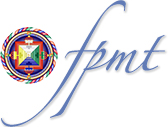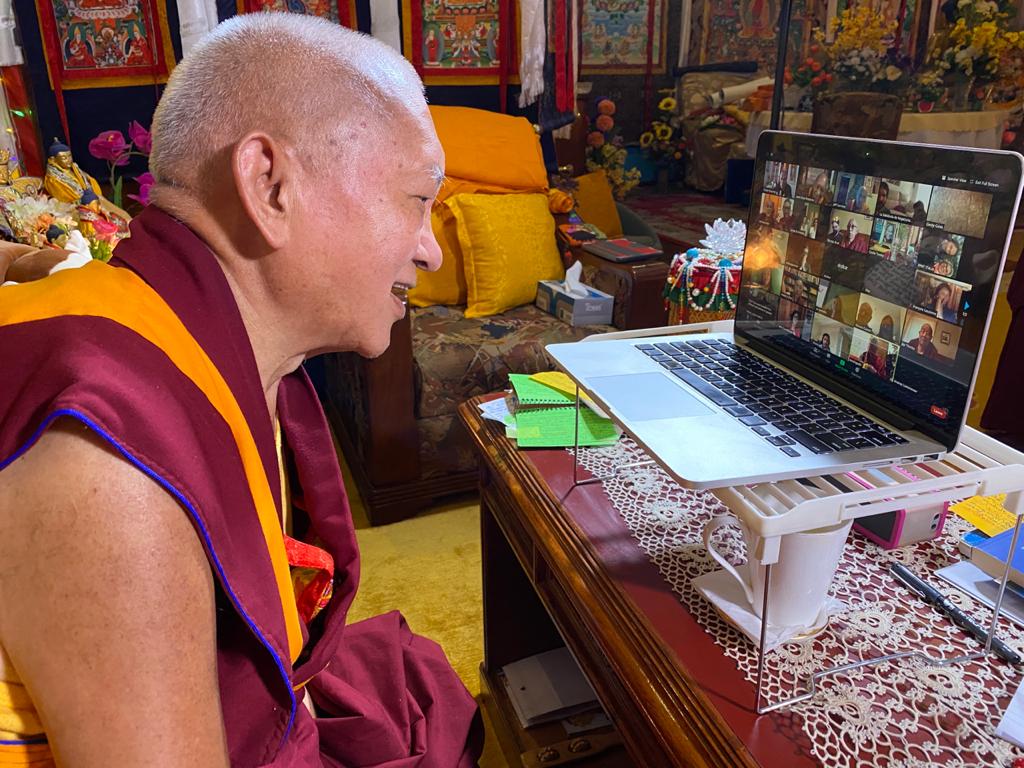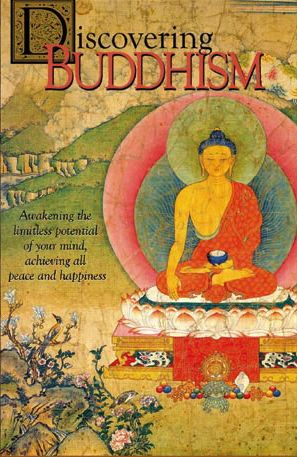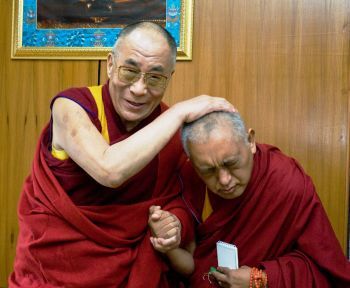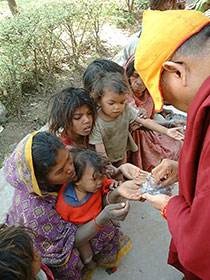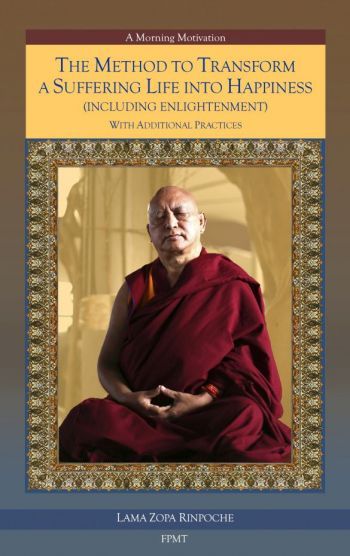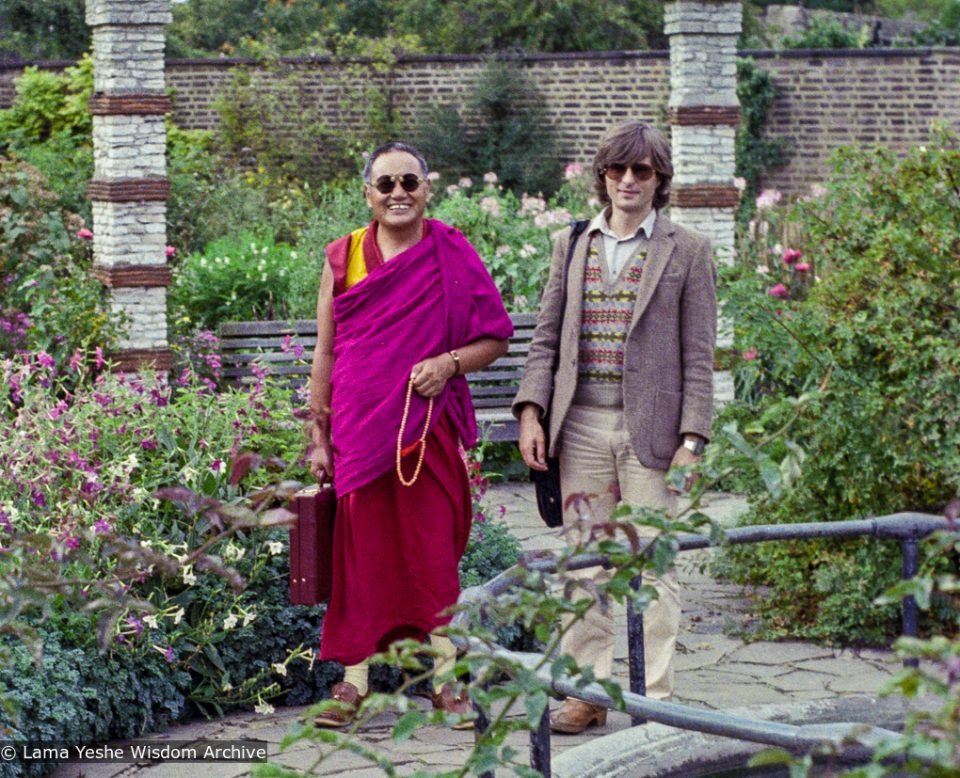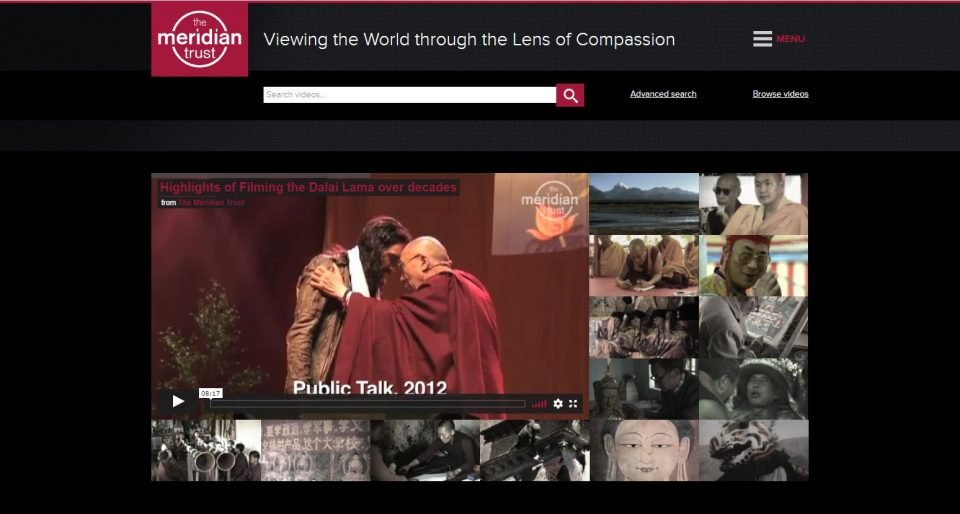- Home
- FPMT Homepage
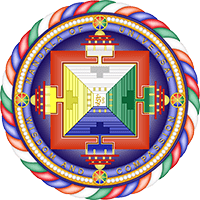
Foundation for the Preservation of the Mahayana Tradition
The FPMT is an organization devoted to preserving and spreading Mahayana Buddhism worldwide by creating opportunities to listen, reflect, meditate, practice and actualize the unmistaken teachings of the Buddha and based on that experience spreading the Dharma to sentient beings. We provide integrated education through which people’s minds and hearts can be transformed into their highest potential for the benefit of others, inspired by an attitude of universal responsibility and service. We are committed to creating harmonious environments and helping all beings develop their full potential of infinite wisdom and compassion. Our organization is based on the Buddhist tradition of Lama Tsongkhapa of Tibet as taught to us by our founders Lama Thubten Yeshe and Lama Thubten Zopa Rinpoche.
- Willkommen
Die Stiftung zur Erhaltung der Mahayana Tradition (FPMT) ist eine Organisation, die sich weltweit für die Erhaltung und Verbreitung des Mahayana-Buddhismus einsetzt, indem sie Möglichkeiten schafft, den makellosen Lehren des Buddha zuzuhören, über sie zur reflektieren und zu meditieren und auf der Grundlage dieser Erfahrung das Dharma unter den Lebewesen zu verbreiten.
Wir bieten integrierte Schulungswege an, durch denen der Geist und das Herz der Menschen in ihr höchstes Potential verwandelt werden zum Wohl der anderen – inspiriert durch eine Haltung der universellen Verantwortung und dem Wunsch zu dienen. Wir haben uns verpflichtet, harmonische Umgebungen zu schaffen und allen Wesen zu helfen, ihr volles Potenzial unendlicher Weisheit und grenzenlosen Mitgefühls zu verwirklichen.
Unsere Organisation basiert auf der buddhistischen Tradition von Lama Tsongkhapa von Tibet, so wie sie uns von unseren Gründern Lama Thubten Yeshe und Lama Thubten Zopa Rinpoche gelehrt wird.
- Bienvenidos
La Fundación para la preservación de la tradición Mahayana (FPMT) es una organización que se dedica a preservar y difundir el budismo Mahayana en todo el mundo, creando oportunidades para escuchar, reflexionar, meditar, practicar y actualizar las enseñanzas inconfundibles de Buda y en base a esa experiencia difundir el Dharma a los seres.
Proporcionamos una educación integrada a través de la cual las mentes y los corazones de las personas se pueden transformar en su mayor potencial para el beneficio de los demás, inspirados por una actitud de responsabilidad y servicio universales. Estamos comprometidos a crear ambientes armoniosos y ayudar a todos los seres a desarrollar todo su potencial de infinita sabiduría y compasión.
Nuestra organización se basa en la tradición budista de Lama Tsongkhapa del Tíbet como nos lo enseñaron nuestros fundadores Lama Thubten Yeshe y Lama Zopa Rinpoche.
A continuación puede ver una lista de los centros y sus páginas web en su lengua preferida.
- Bienvenue
L’organisation de la FPMT a pour vocation la préservation et la diffusion du bouddhisme du mahayana dans le monde entier. Elle offre l’opportunité d’écouter, de réfléchir, de méditer, de pratiquer et de réaliser les enseignements excellents du Bouddha, pour ensuite transmettre le Dharma à tous les êtres. Nous proposons une formation intégrée grâce à laquelle le cœur et l’esprit de chacun peuvent accomplir leur potentiel le plus élevé pour le bien d’autrui, inspirés par le sens du service et une responsabilité universelle. Nous nous engageons à créer un environnement harmonieux et à aider tous les êtres à épanouir leur potentiel illimité de compassion et de sagesse. Notre organisation s’appuie sur la tradition guéloukpa de Lama Tsongkhapa du Tibet, telle qu’elle a été enseignée par nos fondateurs Lama Thoubtèn Yéshé et Lama Zopa Rinpoché.
Visitez le site de notre Editions Mahayana pour les traductions, conseils et nouvelles du Bureau international en français.
Voici une liste de centres et de leurs sites dans votre langue préférée
- Benvenuto
L’FPMT è un organizzazione il cui scopo è preservare e diffondere il Buddhismo Mahayana nel mondo, creando occasioni di ascolto, riflessione, meditazione e pratica dei perfetti insegnamenti del Buddha, al fine di attualizzare e diffondere il Dharma fra tutti gli esseri senzienti.
Offriamo un’educazione integrata, che può trasformare la mente e i cuori delle persone nel loro massimo potenziale, per il beneficio di tutti gli esseri, ispirati da un’attitudine di responsabilità universale e di servizio.
Il nostro obiettivo è quello di creare contesti armoniosi e aiutare tutti gli esseri a sviluppare in modo completo le proprie potenzialità di infinita saggezza e compassione.
La nostra organizzazione si basa sulla tradizione buddhista di Lama Tsongkhapa del Tibet, così come ci è stata insegnata dai nostri fondatori Lama Thubten Yeshe e Lama Zopa Rinpoche.
Di seguito potete trovare un elenco dei centri e dei loro siti nella lingua da voi prescelta.
- 欢迎 / 歡迎
简体中文
“护持大乘法脉基金会”( 英文简称:FPMT。全名:Foundation for the Preservation of the Mahayana Tradition) 是一个致力于护持和弘扬大乘佛法的国际佛教组织。我们提供听闻,思维,禅修,修行和实证佛陀无误教法的机会,以便让一切众生都能够享受佛法的指引和滋润。
我们全力创造和谐融洽的环境, 为人们提供解行并重的完整佛法教育,以便启发内在的环宇悲心及责任心,并开发内心所蕴藏的巨大潜能 — 无限的智慧与悲心 — 以便利益和服务一切有情。
FPMT的创办人是图腾耶喜喇嘛和喇嘛梭巴仁波切。我们所修习的是由两位上师所教导的,西藏喀巴大师的佛法传承。
繁體中文
護持大乘法脈基金會”( 英文簡稱:FPMT。全名:Found
ation for the Preservation of the Mahayana Tradition ) 是一個致力於護持和弘揚大乘佛法的國際佛教組織。我們提供聽聞, 思維,禪修,修行和實證佛陀無誤教法的機會,以便讓一切眾生都能 夠享受佛法的指引和滋潤。 我們全力創造和諧融洽的環境,
為人們提供解行並重的完整佛法教育,以便啟發內在的環宇悲心及責 任心,並開發內心所蘊藏的巨大潛能 — 無限的智慧與悲心 – – 以便利益和服務一切有情。 FPMT的創辦人是圖騰耶喜喇嘛和喇嘛梭巴仁波切。
我們所修習的是由兩位上師所教導的,西藏喀巴大師的佛法傳承。 察看道场信息:
- FPMT Homepage
- News/Media
-
- Study & Practice
-
-
- About FPMT Education Services
- Latest News
- Programs
- New to Buddhism?
- Buddhist Mind Science: Activating Your Potential
- Heart Advice for Death and Dying
- Discovering Buddhism
- Living in the Path
- Exploring Buddhism
- FPMT Basic Program
- FPMT Masters Program
- FPMT In-Depth Meditation Training
- Maitripa College
- Lotsawa Rinchen Zangpo Translator Program
- Universal Education for Compassion & Wisdom
- Online Learning Center
-
- Prayers & Practice Materials
- Overview of Prayers & Practices
- Full Catalogue of Prayers & Practice Materials
- Explore Popular Topics
- Benefiting Animals
- Chenrezig Resources
- Death & Dying Resources
- Lama Chopa (Guru Puja)
- Lama Zopa Rinpoche: Compendium of Precious Instructions
- Lama Zopa Rinpoche: Life Practice Advice
- Lama Zopa Rinpoche Practice Series
- Lamrim Resources
- Mantras
- Prayer Book Updates
- Purification Practices
- Sutras
- Thought Transformation (Lojong)
- Audio Materials
- Dharma Dates - Tibetan Calendar
- Translation Services
- Publishing Services
- Ways to Offer Support
- Prayers & Practice Materials
-
- Teachings and Advice
- Find Teachings and Advice
- Lama Zopa Rinpoche Advice Page
- Lama Zopa Rinpoche: Compendium of Precious Instructions
- Lama Zopa Rinpoche Video Teachings
- ༧སྐྱབས་རྗེ་བཟོད་པ་རིན་པོ་ཆེ་མཆོག་ནས་སྩལ་བའི་བཀའ་སློབ་བརྙན་འཕྲིན།
- Podcasts
- Lama Yeshe Wisdom Archive
- Buddhism FAQ
- Dharma for Young People
- Resources on Holy Objects
- Teachings and Advice
-
-
*If a menu item has a submenu clicking once will expand the menu clicking twice will open the page.
-
-
- Centers
-
- Teachers
-
- Projects
-
-
-
-
*If a menu item has a submenu clicking once will expand the menu clicking twice will open the page.
-
-
- FPMT
-
-
-
-
-
Cultivating a close, warmhearted feeling for others automatically puts the mind at ease. From the least to the most important event, the affection and respect of others are vital for our happiness.
His Holiness the Dalai Lama
-
-
-
- Shop
-
-
-
The Foundation Store is FPMT’s online shop and features a vast selection of Buddhist study and practice materials written or recommended by our lineage gurus. These items include homestudy programs, prayers and practices in PDF or eBook format, materials for children, and other resources to support practitioners.
Items displayed in the shop are made available for Dharma practice and educational purposes, and never for the purpose of profiting from their sale. Please read FPMT Foundation Store Policy Regarding Dharma Items for more information.
-
-
In-depth Stories
9
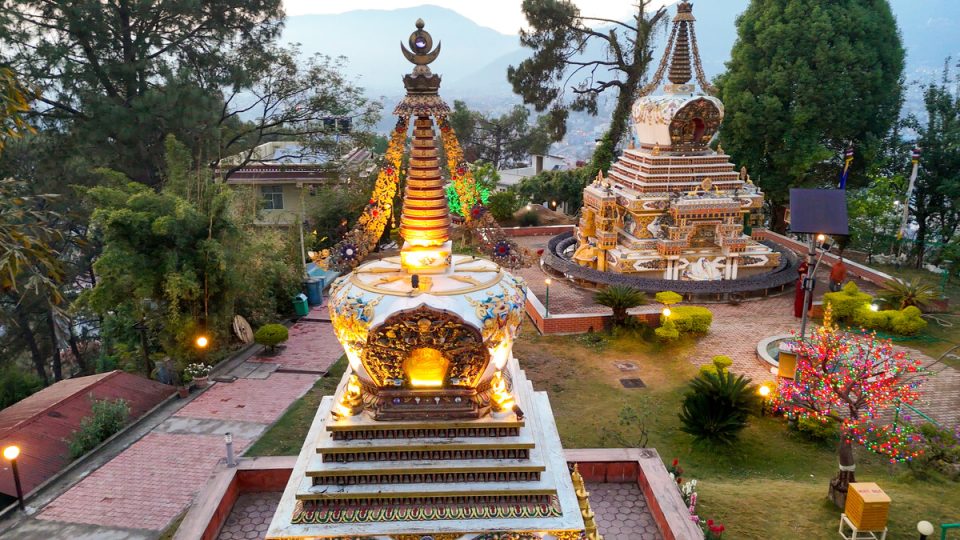
Beautiful early evening lights in the stupa garden, Kopan Monastery. Photo by Capucine T. Dekyong.
Introduction | Reunited and Establishing Our Motivation, April 6 |
Our History, Our Legacy, and the BIG Announcement, April 7 | The Tracks and Break-Out Groups, April 8-9 |
The Vast Visions, Compassion in Action, April 10 | Integration and Next Steps, April 11 |
A Deeply Connected Community | Photo Gallery
By Carina Rumrill
“It’s been so long!” was heard frequently as 195 individuals from 70 FPMT centers, projects, and services greeted each other with hugs and huge smiles upon arrival from 25 different countries at Kopan Monastery, Nepal, for the 2025 CPMT Summit: Advancing Our Gurus’ Vision of a World Guided by Compassion and Wisdom. Indeed, it had been “so long,” eleven years in fact, since the last CPMT meeting was held at the Great Stupa of Universal Compassion in Bendigo, Australia.
In addition to old friends and colleagues reuniting after so many years, many people were meeting close connections for the first time in person. Heart-warming expressions of recognition were shared abundantly— “Oh! So that’s you! It’s so good to finally meet you!” Friends were not only so delighted to see each other, but also so happy to be at Kopan. For many, this was the first pilgrimage in this life to the heart location of the FPMT organization—established at Kopan fifty years ago this year—and for others this was their first time back in many years. In either case, the gathering of this particular body of participants (FPMT directors, regional and national coordinators, spiritual program coordinators, study group coordinators, affiliate board members, key staff, and registered teachers), in this particular, most blessed and significant place (Kopan Monastery, the start of it all) was extremely meaningful.
For six agenda-packed days, participants energetically discussed, debated, dreamed, shared struggles and successes, commiserated and rejoiced, collaborated, planned, and strengthened connections old and new.
A more detailed and data-driven report of the findings, conclusions, and next steps established by this momentous meeting will be shared once all the surveys, reports, transcripts, and minutes from group discussions have been thoroughly analyzed. Meanwhile, I hope you will enjoy an overview of the activities that framed the 2025 CPMT Summit. Please also don’t miss this special photo gallery of the event.
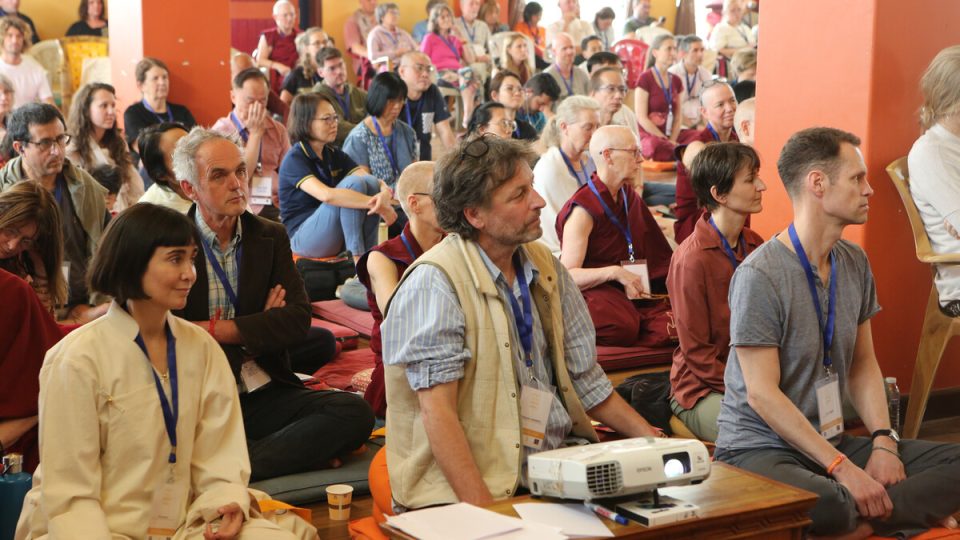
Kopan SPC Francisca, IOF COO François as well as Jeff, head of FPMT Education Services in a packed Chenrezig Gompa. April 7, 2025. Photo by Capucine T. Dekyong.
Reunited and Establishing Our Motivation, April 6
On the first evening, April 6, travel-tired students packed into the Chenrezig Gompa after a nourishing group meal in the dining hall. The lunch and evening meals for the entire week were generously sponsored by Amitabha Buddhist Centre, Singapore; and the breakfasts were provided by Losang Drakpa Centre, Malaysia. The excitement in the gompa was electric and many of us found it difficult to resist rubbernecking around the room looking for old friends.
FPMT Inc. Board member, Paul de Wys, greeted the crowd warmly as we all found our seats. She teared up as she shared, “I think that this group, coming to work together, people who have been offering service for so long, who can contribute so much, to be here with one another at Kopan looking to the future of the organization, is something that would make Lama Thubten Yeshe and Lama Zopa Rinpoche very, very happy. So … my thanks to you.” Paula then invited Khenrinpoche Geshe Chonyi, Abbot of Kopan Monastery and FPMT Inc. Board member, to address the group.
“I think it is so important that everyone has come together, to work together united to fulfill Rinpoche’s wishes. I look forward to having a meaningful and productive CPMT meeting.” Khenrinpoche Geshe Chonyi also led the motivation for the week ahead.
Another of the six FPMT Inc. Board members, Ven. Pemba Sherpa, shared a letter of support and encouragement for the meeting from His Holiness the Dalai Lama, which also provided an auspicious framing for the week to come:
“I am pleased to know that representatives of all the centers belonging to the Foundation for the Preservation of the Mahayana Tradition (FPMT) in different parts of the world will be meeting in Kathmandu, Nepal, to discuss the future direction of the organization.
“First of all I want to recall the contribution your founder teachers, Lama Yeshe and Lama Thubten Zopa have made to the Dharma. Through this organization they have enabled many people to appreciate the potential of the Buddha Dharma to contribute to the wellbeing of sentient beings. Since 1979 at their request I have also given teachings to your members on many occasions – so we have established a special bond with each other.
“Since both Lama Yeshe and Lama Zopa have now passed away, it is appropriate that you discuss the future direction of your community. Soon after Lama Zopa passed away, members of the FPMT Board came to see me. One of the issues they raised was the future of the organization. As I understand it, the FPMT has a sound structure, with teachers and prominent disciples holding leadership positions, which you can reinforce on the basis of discussion and agreement. As I told them, I will continue to offer the FPMT encouragement and support in your service to benefit others.” Please read the full letter.
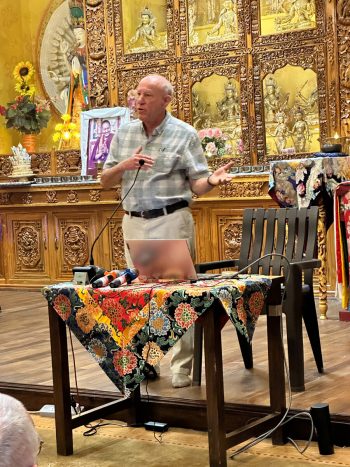
FPMT Inc. Board Chairperson Karuna Cayton addresses the CPMT group. Photo by Harald Weichhart.
Chairman Karuna Cayton addressed the group, introducing the various board members and the qualities, diversity, and expertise they bring to the organization, and remarked that this was the biggest turnout for a CPMT meeting ever, “capturing the magnitude of what we are trying to accomplish.”
Facilitator Jennifer Kim, director of Shantideva Center in New York, USA, also offered an overview of how the Summit would be structured and how the topics chosen to be discussed were selected. She explained that the surveys circulated at the end of 2023 to all FPMT centers, projects, and services; as well as regional consultations held in 2024 in Europe, Asia, Australia, America, and within FPMT International Office, had provided extensive layered data concerning the concerns and key areas of need for discussion within the organization. This pre-work for the Summit took the organizing committee over a year to gather and process in order for the agenda to be as informed as possible.
She explained that three layers, in general, would be covered during the meeting. The core, or first layer, was identified as the Dharma Education of the organization, preserving the unique legacy of teachings from Lama Yeshe and Lama Zopa Rinpoche and also bringing this lineage into a modern context. The next layer was described as the organization itself: the roots, or the structure, upon which all of our services are offered. And finally, the outer layer is symbolized by the wider community, the world outside that desperately needs our help. This includes what we are doing now in terms of the Vast Visions of our lamas, and what we can do going forward to help these visions flourish.
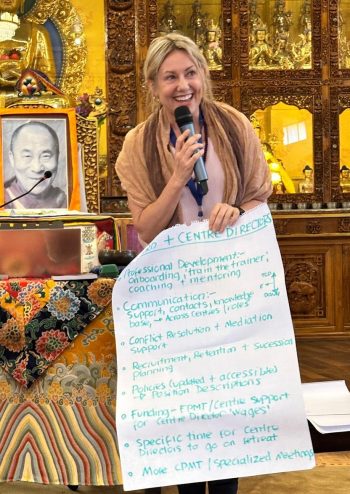
Chenrezig Institute director Emanuelle Jones presenting notes from her break-out group. Photo by Capucine T. Dekyong.
Jennifer introduced the seven tracks that would be explored during the first full two days of the Summit:
- More Experiential & Applied Dharma
- More Approachable & Inclusive Dharma
- Effective Use of Technology
- Promotion & Communications
- Professional Development & Collaboration
- Sustainability
- Protection from Abuse
FPMT International Office COO, Center Services and Teacher Services Director, Francois Lecointre, one of the organizers of the Summit, shared some opening remarks including, “This is really your CPMT. This meeting will be what you choose to do with it. Of course, we will have many sessions and it’s going to be a bit intense. I hope you will not be overwhelmed, I know many of you have come very far and are very tired. But it’s not only the sessions here at the CPMT meeting. This is a family reunion. This is a place for this family feeling to be nourished and for us to recharge with the family. I encourage you to make the most of it. See old friends but also make new friends.”
Director of FPMT Education Services and one of the organizers of the meeting, Jeff Highfill, also greeted participants and offered some “ice breakers” for all to engage in. He didn’t have to ask us twice! Immediately people were enthusiastic about engaging with those sitting next to us, and the whole gompa was buzzing with laughter and energetic exchanges. “I think we are fully thawed out now!” Paula de Wys joked.
A beautiful short video of Lama Zopa Rinpoche teaching on bodhichitta was shared, fully establishing a wonderful motivation for the whole event and reminding everyone about Rinpoche’s core teaching, “We must generate bodhichitta in our minds in this life. That should be the main aim of living life, do you understand? What are you living your life for? Why? The aim should be bodhichitta. To generate bodhichitta in this life, everything should be for that. So, whenever you collect merit, dedicate for that. Jangchub semchog, that is why we dedicate with that.”
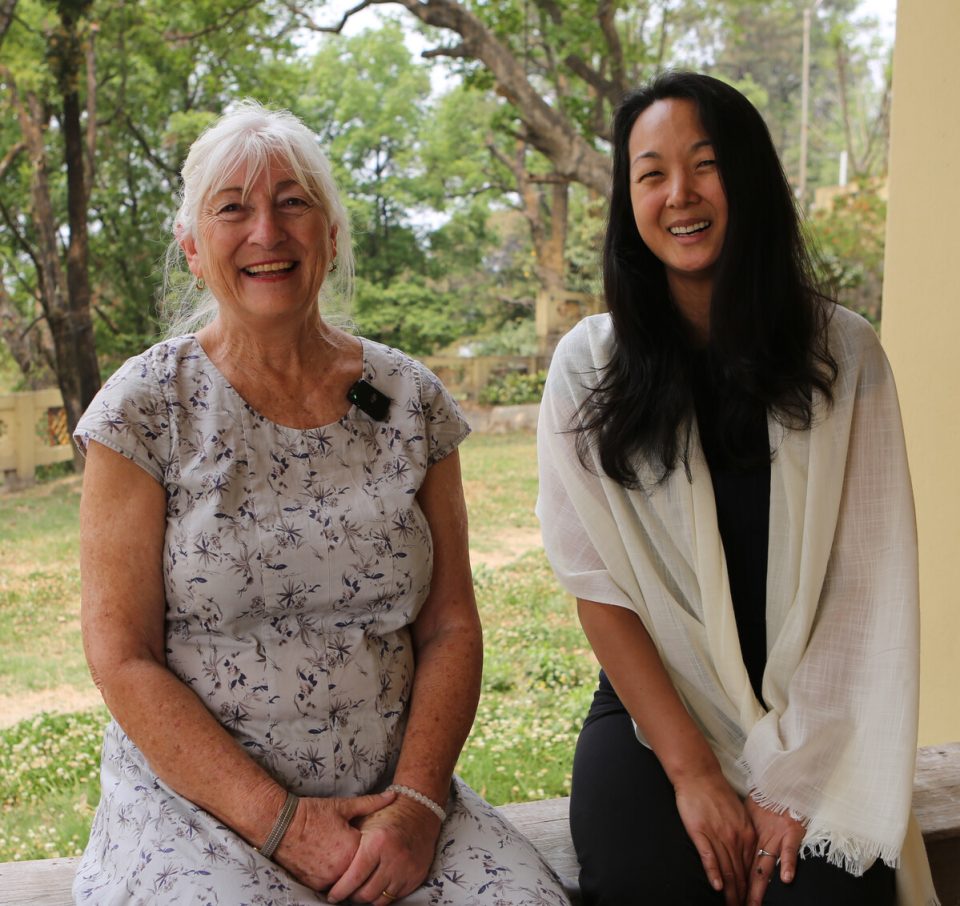
FPMT Inc. Board member Dale Davis and CPMT Summit Facilitator, Jennifer Kim. Photo by Capucine T. Dekyong.
FPMT Inc. Board member Dale Davis addressed the group, welcoming everyone and overviewing what we should expect over the days to come. Francisca Riaño, SPC of Kopan Monastery, graciously greeted and welcomed the group and went over some practical information about staying at Kopan.
After a quick Q & A with participants, Ven. Joan Nicell led a moving dedication, really sealing all the incredible energy generated on this first night together. Exhausted from travel, most of us returned to our dorm rooms to get acquainted with our roommates, unpack, and settle into our new homes for the week.
Our History, Our Legacy, and the BIG Announcement, April 7
The first full day of the Summit was dedicated to understanding and appreciating the unique history of the FPMT organization, and familiarization with the current structure and challenges of successfully moving the organization forward into the future. We were treated to several talks from some of FPMT’s beloved legends and received the joyful news that His Holiness the Dalai Lama had confirmed the rebirth of Lama Zopa Rinpoche’s incarnation in Nepal. What an auspicious start to the event!
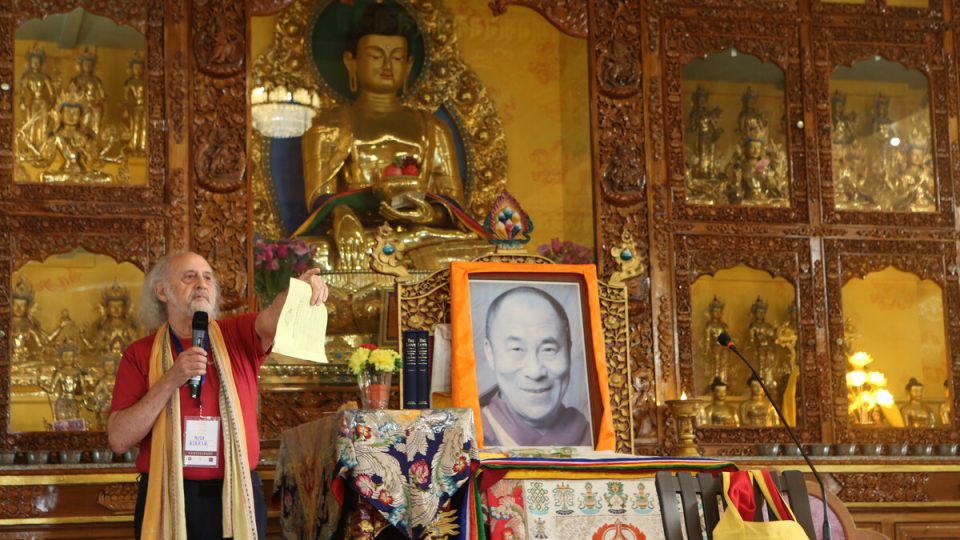
Nick Ribush discussing the early years of the FPMT organization, April 7. Photo by Capucine T. Dekyong.
The first speaker of the day was Dr. Nicholas Ribush, who is known widely in the organization not only for his contributions to preserving the legacy of our founding lamas, but also for his superb institutional memory. “Good morning. My name is Nick, and I’m a Dharmaholic,” he joked. You could sense the entire gompa relaxing with comfort and ease as Nick warmly shared many precious details and an overview of FPMT organizational history, painting a picture of the richness, magic and absurdity of some of the stories from the early years.
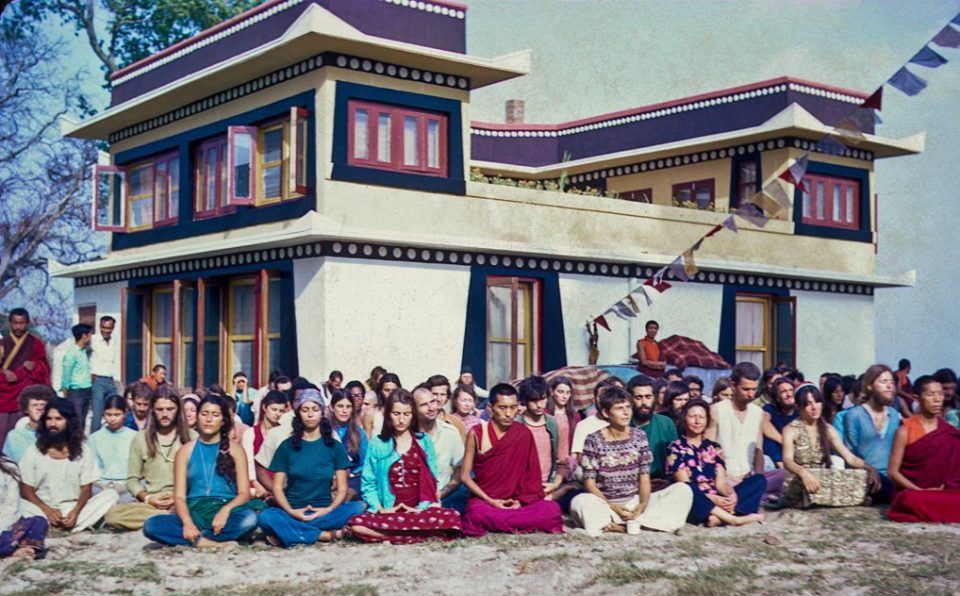
Lama Zopa Rinpoche in a group photo from the Fourth Meditation Course, Kopan Monastery, Spring 1973. Photo courtesy LYWA Collection.
In 1972, Nick arrived at Kopan Monastery in Nepal. After attending the Third Kopan Course, he offered to help Lama Zopa Rinpoche revise Rinpoche’s The Wish-Fulfilling Golden Sun of the Mahayana Thought Training, which served as the teaching text for the course. Rinpoche accepted the offer, and for several years Nick lived at Kopan, attending the month-long courses, working on revisions to The Wish-Fulfilling Golden Sun, and editing notes and transcriptions from Rinpoche’s teachings into course commentaries. After many years of offering service to a variety of FPMT activities, including Wisdom Publications, Nick founded the Lama Yeshe Wisdom Archive in 1996. After the event, Nick shared:
“It has been a great privilege to attend my 18th CPMT, especially since it was held at Kopan. Sadly, however, it was the first without the presence of either Lama Yeshe or Lama Zopa Rinpoche. Nevertheless, to be with 180 or so fellow FPMT students, all working cohesively with energy and devotion to maintain and develop our precious Lamas’ vision for the enlightenment of all sentient beings, has been a wonderful experience.
“It was the first global FPMT meeting in about eleven years, which is far too long between CPMTs, and I hope from now on we will be able to hold them regularly, perhaps every two years at Kopan. Sincere thanks to the organizers and all my FPMT colleagues for creating such a memorable event.”
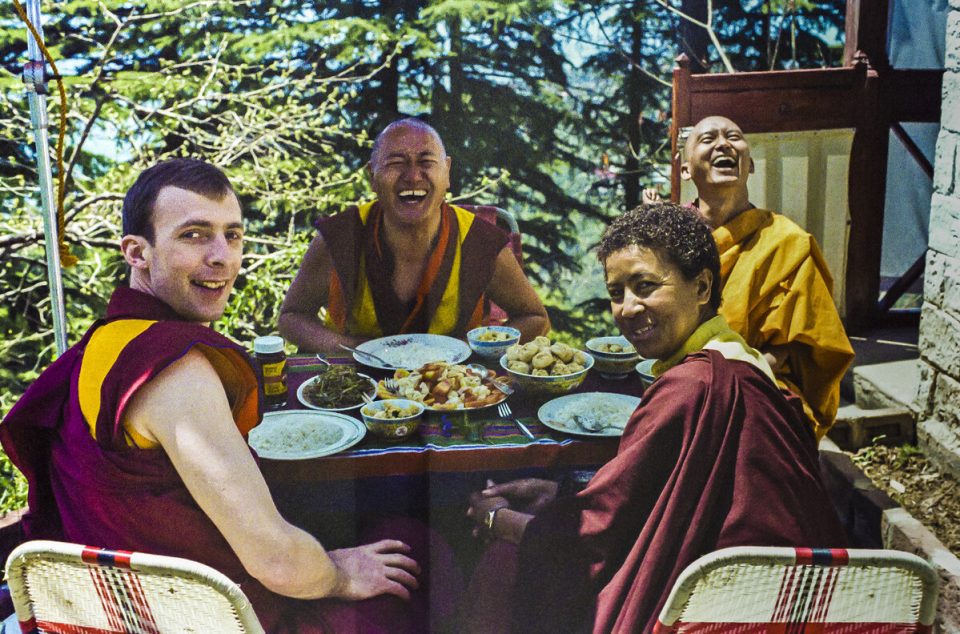
Peter Kedge, Lama Yeshe, Max Mathews, Lama Zopa Rinpoche at the First Enlightened Experience, Tushita Meditation Centre, India, 1982. Photo courtesy of LYWA collection.
Next, Peter Kedge, early student of the lamas who arrived in Nepal in 1971 and Kopan specifically in 1972 and worked closely with Lama Yeshe for twelve years prior to his passing, spoke to the Summit. Peter has been instrumental in the development of the FPMT organization and was involved in so many FPMT activities including as an FPMT Inc. Board member, and former director and CEO of the Maitreya Project. Peter joined the group over livestream from Canada and shared some additional history of the organization, stories of the lamas from the early days, and recognized some of the remarkable people who helped shape, support, fund, and establish FPMT in the early years. This is always a key message of Peter’s to really acknowledge those who selflessly gave so much of themselves to help make the lamas’ vision a reality, the “heroes,” who “hold up the sky for FPMT” as he says, including Tibetans, local Nepalis, and Westerners, particularly in the very difficult early years. Peter also discussed the challenging and pivotal time following Lama Yeshe’s passing.
One particularly interesting point Peter shared was how, when the lamas first started traveling the world, outside of India and Nepal, in 1974 and 1975, they would always come back through India and stop in Dharamsala in order to make a full written report to His Holiness the Dalai Lama. “Rinpoche has explained, several times, that our Boss is His Holiness. And that’s still the case,” Peter said.
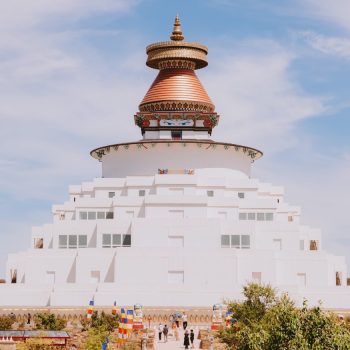
The Great Stupa of Universal Compassion, Bendigo, Australia. Photo courtesy of The Great Stupa.
“Lama was into absolutely everything,” Peter explained. “He was also very concerned with how people managed the centers. ‘The purpose of centers is to serve,’ he would say. He was very concerned about the phenomenon of groups of people in the centers becoming like a club. Lama would say, ‘This is not a club. This is not a nightclub. The purpose is to serve.’ He also said he’d rather that centers be empty than become like soup—a mixture of too many things.”
Ian Green, a long-time student of both Lama Yeshe and Lama Zopa Rinpoche, has served FPMT and the Dharma only in big ways: as a founder and director of Atisha Centre in Bendigo, Australia, as the chairman of various FPMT-related boards, and as the director of two of FPMT’s biggest holy object projects: the Great Stupa of Universal Compassion and the Jade Buddha for Universal Peace. Ian read from his new book, Monumental: The Story of the Stupa.
Ven. Elisabeth Drukier, director of Kalachakra Centre, presented next. Ven. Elisabeth is an early French student of the lamas who came to Kopan in 1974 and stayed for the next five years, ordaining in 1976. Ven. Elisabeth was instrumental in establishing Institut Vajra Yogini, Nalanda Monastery, and Kalachakra Centre in France. She shared stories about Kopan and Kathmandu in the early days of the FPMT organization and shared some of her own personal story making her way to Kopan for the first time. “Lama Yeshe had a talent for picking up people and giving them responsibilities. You didn’t know really you were capable of doing what he asked, but he knew. He knew.”
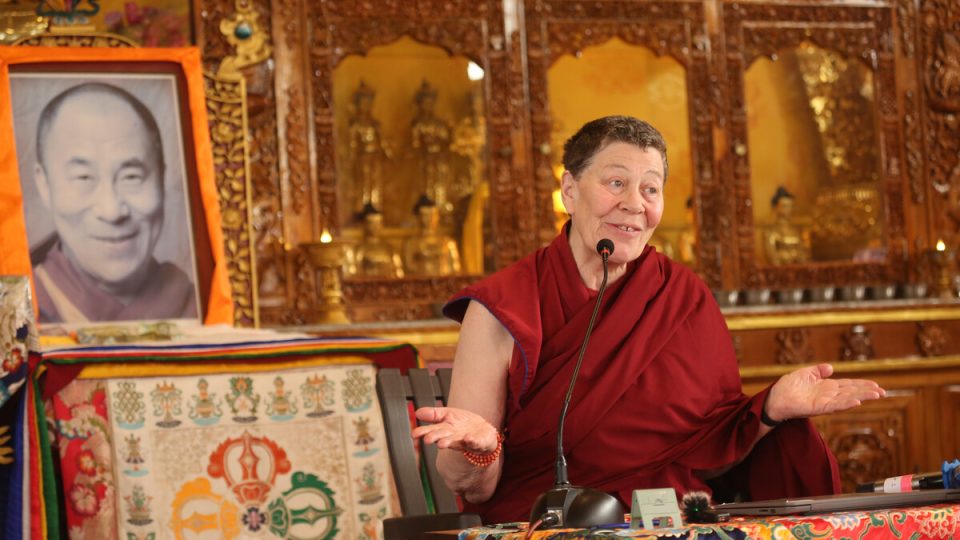
Ven. Elisabeth Drukier addressing the group about the early years of FPMT, April 7, 2025. Photo by Capucine T. Dekyong.
Ven. Roger Kunsang next discussed the early years of the organization including the period when Lama Zopa Rinpoche reluctantly took over leadership following the passing of Lama Yeshe. Ven. Roger is CEO of FPMT International Office, FPMT Inc. Board member, and was the attendant to Lama Zopa Rinpoche from 1986 until Rinpoche showed the aspect of passing away in 2023. Ven. Roger’s talk included an overview of the evolution of Rinpoche’s “office” (now known as FPMT International Office).
Khenrinpoche Geshe Chonyi offered a history and some personal stories of Kopan from the very early days. Khenrinpoche joined Kopan Monastery after being ordained by Lama Zopa Rinpoche in 1974. He studied at Kopan for six years then went to Sera Je Monastery in South India and continued another 18 years of intensive study and debate in Buddhist Philosophy. Khenrinpoche was awarded the title of Geshe Lharampa, the highest Tibetan Buddhist doctorate conferred in the Gelug monastic tradition. Khenrinpoche is currently abbot of Kopan Monastery and Kopan Nunnery, and resident geshe at Amitabha Buddhist Centre (ABC), Singapore.
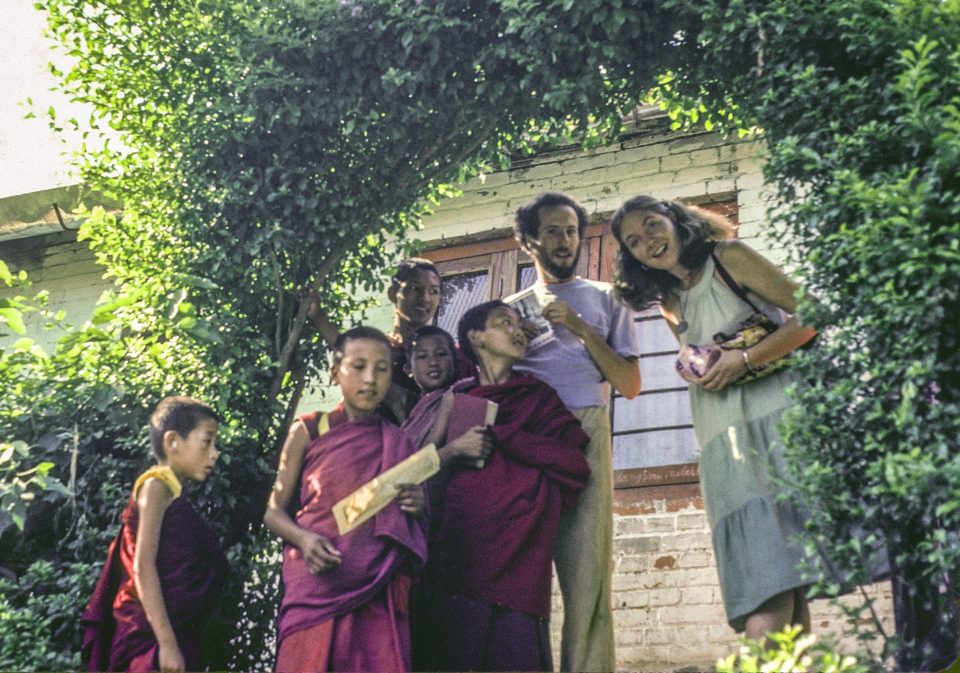
Karuna Cayton at Kopan Monastery, 1978, with the young monks and Jacie Keeley. Photo courtesy of the Lama Yeshe Wisdom Archive.
Karuna Cayton, early student of the lamas who lived at and helped manage Kopan Monastery from 1978-1988, and current chairperson of the FPMT Inc. Board of Directors, discussed Lama Yeshe’s wishes for a thorough education of the monks and his active role in establishing the educational structure during his time at the monastery. Karuna also discussed several challenges currently facing the FPMT organization, including recent events involving Osel Hita.
Geshe Sherab, headmaster of Kopan School, further discussed the development and evolution of the academic education system at Kopan, the importance of sustaining the Sangha community, and the need for integration of modern education with the traditional monastic education.
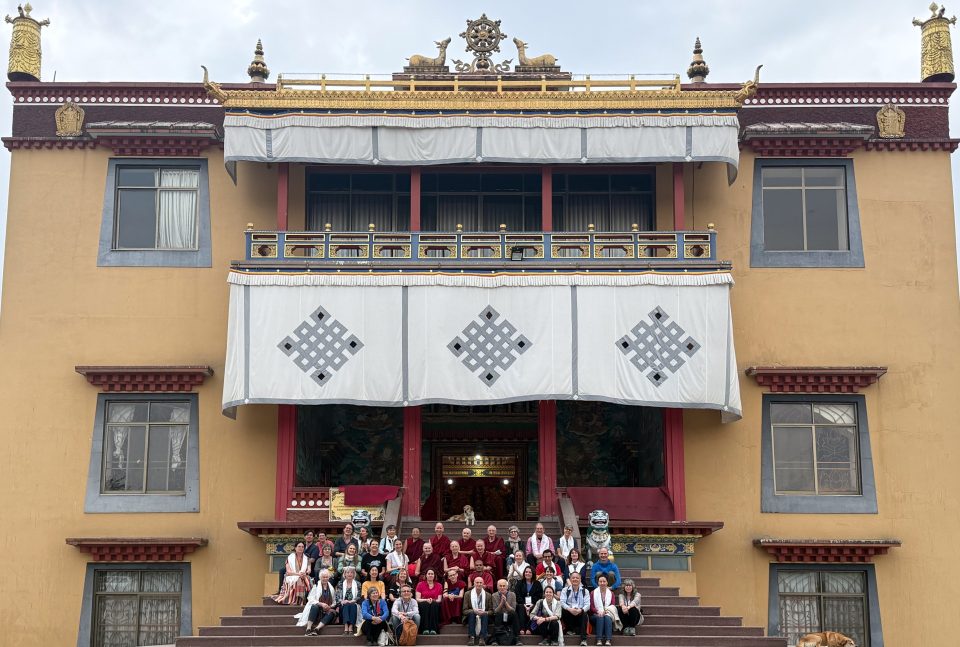
CPMT participants visiting Khachoe Ghakhyil Ling Nunnery (Kopan Nunnery), April 11. Photo by Capucine T. Dekyong.
Ven. Thubten Dekyong (known as Ani Tsenla) had everyone laughing and engaged with her energetic stories about her role in the history of Khacho Ghakyil Ling (Kopan Nunnery), located just under a half of a mile from Kopan Monastery. She shared the story of how she slowly came to the realization that Lama Zopa Rinpoche wanted her to take responsibility for the nunnery. This suspicion was sealed after she was invited to lunch by Rinpoche in the mid-1980s. “Whenever you get invited to a meal, you know … that’s a project coming. So I knew I was getting the [nunnery].”
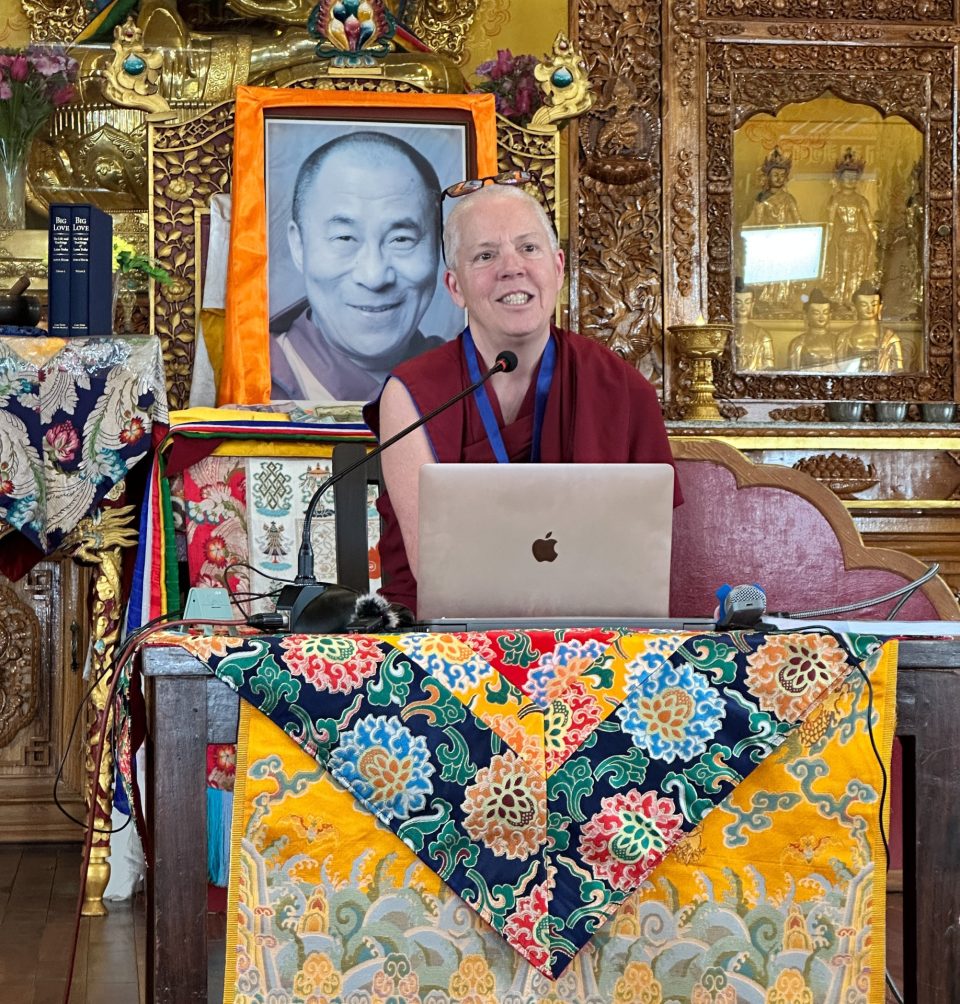
Ven. Joan Nicell presenting, April 7, 2025. Photo by Harald Weichhart.
Ven. Joan Nicell, who first attended the Kopan November course in 1987, and ordained in 1989, provided an overview of the courses at Kopan and their evolution. Ven. Joan helped set up the first Masters Program at Istituto Lama Tzong Khapa in Italy, and has worked as a translator of Tibetan texts, as an editor, and as a live transcriber of Lama Zopa Rinpoche’s teachings. She presently lives and teaches at Kopan. Ven. Joan shared that Kopan has been most successful in offering courses to beginners. Last year’s November Course included an 88-year-old student as well as two 18-year-olds, illustrating the range of participants who come from all over the world. She shared, “One thing that’s special about Kopan, and also Tushita, is that many young people come here.” Ven. Joan also offered a beautiful tribute to Ani Karin Valham, who was not well enough to offer this talk herself and asked Ven. Joan to offer it on her behalf. Ani Karin attended her first Kopan course in 1974 and ordained in 1976. She began leading meditations for the November Course in 1978 and began teaching actual courses at Kopan in 1985. Ani Karin is one of those true treasures we have within the FPMT organization, who has selflessly given her life to serving others through teaching the Dharma and it was extremely moving to hear Ven. Joan share a bit of Ani Karin’s story so we could appreciate her rich contributions.
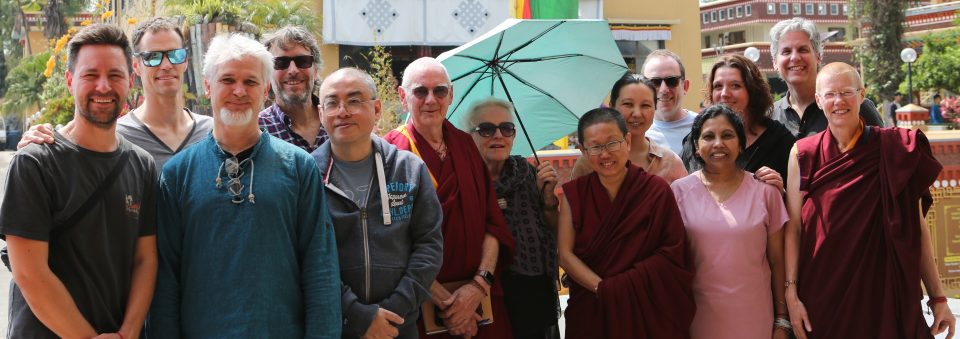
FPMT International Office Staff, Kopan Monastery following a staff meeting, April 12, 2025. Missing: Adam Payne and Justin Jenkins who could not attend the CPMT Summit. Photo by Capucine T. Dekyong.
In the afternoon, FPMT International Office was introduced and gave a brief outline of their various roles within the office. The office staff had not been together in person as a group for nearly seven years, and some staff had never met one another in person at all, so this meeting was important, and essential, for us.
After lunch, Ling Rinpoche joined by livestream and warmed everyone’s hearts with his message about the lamas’ legacy:
“One of our main aims is to follow the advice and wishes of His Holiness the Dalai Lama, and also the founder of FPMT, Lama Thubten Yeshe. Although he was a very simple monk with a very sincere wish to benefit sentient beings and the Dharma, he worked so hard for so many years to teach many students and to establish the roots of the organization. And his very heart disciple, Lama Zopa Rinpoche, carried on this work in such a tremendous and excellent way. The two of them were wonderful examples, Lama Yeshe and Lama Zopa Rinpoche, who worked very hard for so many years to establish the FPMT organization in order to benefit the Buddha’s teachings in general, and to share the Tibetan lineage of Buddhism and to spread it all over the world, especially to many places where even the word ‘Buddhism’ had never been heard before. So it’s really something wonderful they have done and that we continue to do now.”
The big news of the day was the announcement that His Holiness the Dalai Lama had recently confirmed that Lama Zopa Rinpoche’s incarnation has been born and is living in Nepal. This was a truly joyous moment for all. The FPMT Inc. Board of Directors then took some time to discuss spiritual leadership within the FPMT, and to update on some expected changes to the structure moving forward.
Ven. Sarah Thresher shared her vision for preserving Lama Zopa Rinpoche’s lineage and repaying the kindness of our spiritual friends. Ven. Sarah met the Dharma in 1982 at Kopan and almost immediately began working for Wisdom Publications editing and preparing Dharma materials. In 1986, after ordaining in Bodhgaya with His Holiness Dalai Lama she made her first trip to Lawudo. She has traveled and taught around the world, but her focus is preserving and spreading the teachings, practice and chanting lineage of Lama Zopa Rinpoche. Ven. Sarah really emphasized that Rinpoche left this incredible wealth of teachings “for US!” and we all have the responsibility to put into practice what Rinpoche advised and to preserve this most extraordinary lineage. Ven. Sarah shared three important aspects of preserving this lineage: The collected writings, the practice lineage, and the heart advice/pith instructions. Ven. Sarah also shared several proposed ideas for how we can do this. Following on this, Geshe Legtsok reminded us about the uncommon qualities of our lineage lamas. He discussed the need for following the guru’s advice (individually and organizationally).
About the event, Geshe Legtsok shared:
“After being inspired for years by news from all corners of the FPMT of people doing retreats, offering educational programs, building holy objects, supporting charitable projects and much more, it was a privilege to meet many of these people in person for the first time all at Kopan, the mothership. The kind-heartedness, commitment to serving the Dharma and sentient beings, and depth of experience was palpable in all. With each person I met it felt as though we could have spent hours getting to know each other better and sharing ideas to further our respective practice and endeavors. I came away more confident than ever in the integrity of the FPMT and the shared pure intention for our mission in the world. How fortunate to be part of this community of such good people with such a profound purpose!”
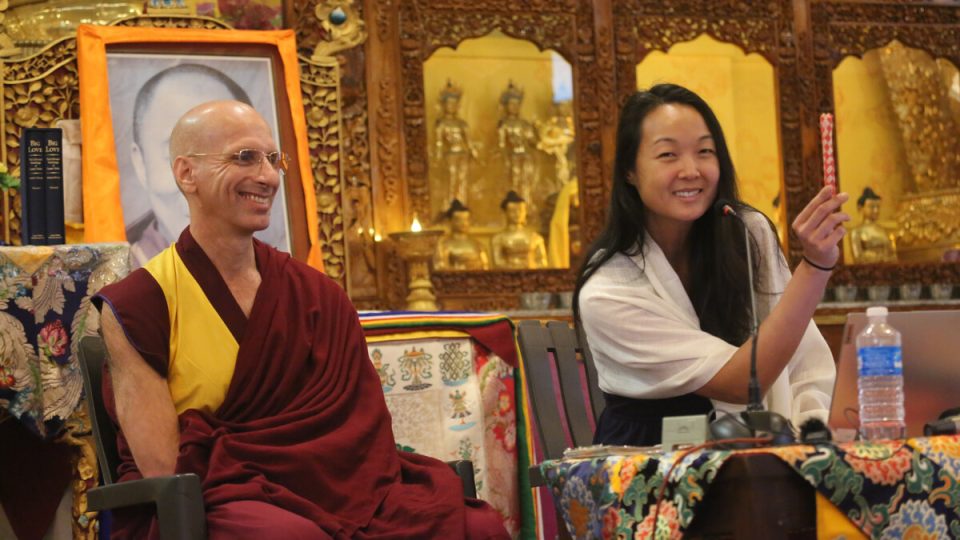
Jennifer Kim presents a small toy to CPMT participants. They had to figure out how to collaborate to easily get it off their fingers again. Hint: collaboration and moving together is key. April 7, 2025. Photo by Capucine T. Dekyong.
Geshe Legtsok then joined facilitator Jennifer Kim in a discussion on “polarities” with an enjoyable group exercise using a Chinese finger trap, which was used as a metaphor to encourage us to shift our mindset from one of resistance and struggle to one of acceptance, willingness, and collaboration.
The Tracks and Break-Out Groups, April 8-9
Our passive experience of enjoying the informational presentations came to an end on Day 3 as we embarked on the “track” section of the Summit for the next two days where participants engaged in topic-focused breakout groups to address issues identified in the surveys and consultations from earlier in the year.
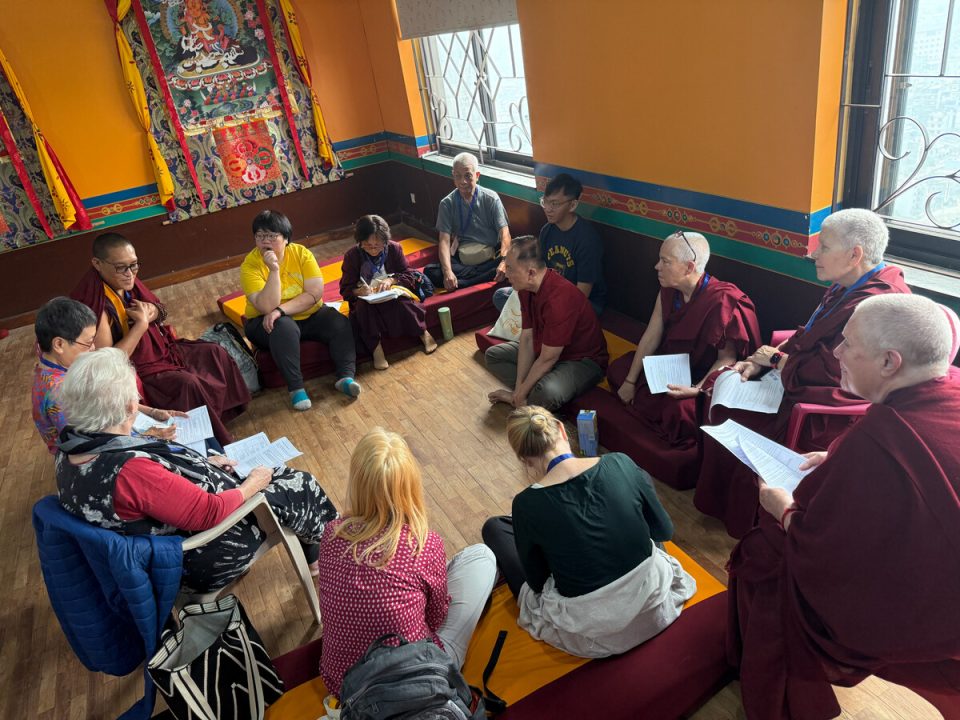
Groups discussing the topic “More experiential and applied Dharma” at CPMT 2025. April 8, 2025. Photo by Capucine T. Dekyong.
On the first day of the breakout group sessions, Strengthening Education was explored, and participants were asked to choose one of four tracks: More Experiential & Applied Dharma, More Approachable & Inclusive Dharma, Effective Use of Technology, and Promotion & Communications.
On day two of the breakout sessions, the theme of Strengthening the Organization was discussed in small groups through tracks on Professional Development & Collaboration, Sustainability, and Protection from Abuse.
Each track met in different locations to discuss thoroughly the topics after an opening presentation from the facilitators. Following the group discussion, conclusions and key points of discussion were presented by each track to the full group of participants, followed by lively Q & A discussions.
These discussions weren’t always easy. Many of the topics discussed are quite personal for those serving in various key roles throughout the organization, and passionate opinions and concerns can be challenging to navigate, particularly if one feels criticized for their own work or the work of colleagues, or if expectations are not aligned between groups which can lead to disappointment. In general, even during heated debates, participants displayed good faith in one another and reached mutual understanding or at least a shift in view from one’s own solid perception.
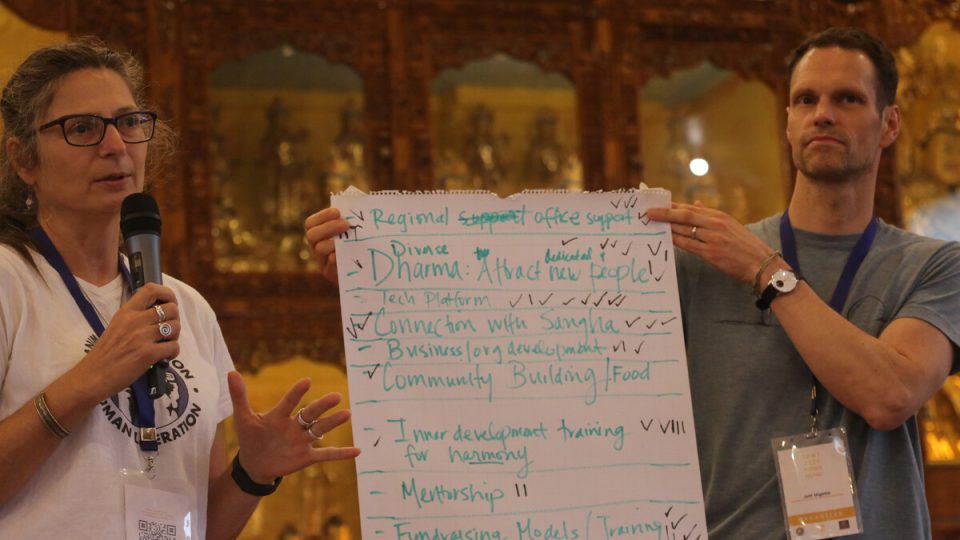
Tania Duratovic presenting from her break-out group discussion on April 9, 2025. Jeff Highfill holds her notes. Photo by Harald Weichhart.
On the evening of April 8, Geshe Tenzin Zopa offered a very moving talk about how to think when the guru is no longer physically with us.
Geshe Zopa praised the FPMT centers and students: “The dedication and the service, is unbelievable. It’s absolutely in accordance with Lama Yeshe and Kyabje Zopa Rinpoche’s vision … Very much all of you, it’s so heart-touching, so inspiring, whatever was taught in the lamrim about guru devotion such as the Fifty Verses of Guru Devotion—each and every one of you embody those teachings exactly. If not more. It’s unbelievable, really. So, my point is, if you want to focus on all this greatness, there are numberless examples, numberless. But if you want to focus on the negative side, we’re in samsara. And not only outwardly, but it’s the result of the collective karma of the samsara beings, but also, our mind is not yet purified. I don’t know about you, but at least for me … the mind is not purified, hallucinated, dualistic, delusional—and in the eyes of delusion, you see that everything is not right. Everything is false. Even when something is right, you see wrong. … But really we have so much in which to rejoice. We are so lucky. Really, so lucky.”
Geshe Zopa also shared so many hilarious and inspiring stories about Lama Zopa Rinpoche—his tireless activities taking care of every single being—be it one frog, a group of ants, a cow, or any single human—in his path at all times, day or night, the prayers, the mantras, the practices, the offerings, the patience to endure difficulties, the joyous effort Rinpoche displayed serving sentient beings. “There’s no way we can even fathom Rinpoche’s qualities,” Geshe Zopa said.
FPMT Australia Education Coordinator, Stephanie Brennan shared:
“It was such a delight to meet the people working for FPMT across the globe that had only been names on the end of an email address before. There was a genuine feeling of goodwill and happiness. There was also space for debate and discussion, which was so important. People weren’t afraid to express themselves and this led to moments of breakthrough and creative suggestions. Following the joyful news from His Holiness the 14th Dalai Lama that Kyabje Zopa Rinpoche had been reborn, there was great joy and emotion. I left with a feeling of confidence and expanded relationships.”
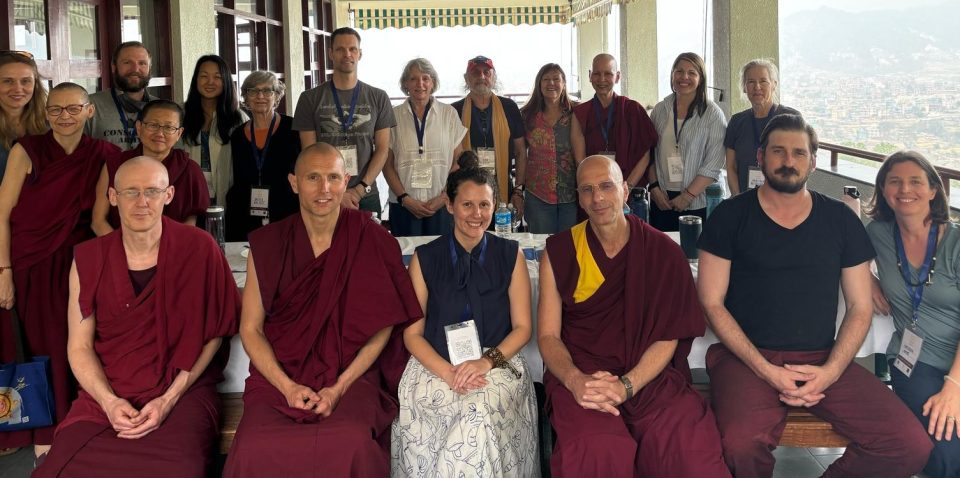
On April 8, participants took advantage of being together and gathered for a North American Regional Lunch at the Kopan dining hall. Photo courtesy of FPMT North America.
FPMT East and Southeast Asia Regional Coordinator, Selina Foong shared:
“This CPMT summit has been a long time coming, and it was a true joy to meet so many of my dear dharma family from all over the world again. And to make new friends! The past few years have not been easy for FPMT, but I found much hope and inspiration in coming together at our beloved Kopan, to collectively chart the future. Moving forward, I hope and pray that we always have harmony. I also look forward to sharing more about our East & Southeast Asia region in the years to come, as the sheer energy and scale of events offered in this part of the world is something in which to truly rejoice.”
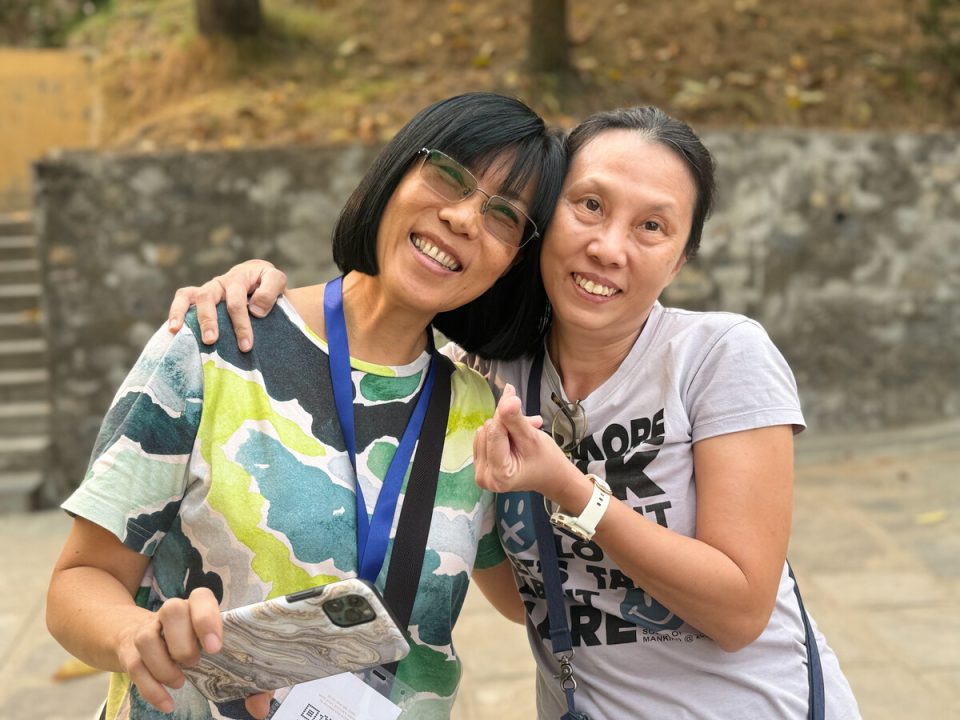
Regional Coordinator of FPMT East & Southeast Asia Selina Foong and Guat Cheng Koh, Amitabha Buddhist Centre SPC sub-committee member and registered teacher, April 8, 2025. Photo by Capucine T. Dekyong.
Newly appointed director of Chenrezig Institute, Australia, Emanuelle Jones reflected:
“What struck me most was the way this summit seamlessly blended the structure and depth of mainstream professional education with a deeply rooted commitment to inner development and global wellbeing.
“The format of the conference felt familiar—plenary sessions, breakout groups, targeted working sessions—mirroring the best of professional development in educational settings. Yet, unlike typical conferences, every discussion was grounded in the aspiration to cultivate compassion and ethical awareness.
“Whether we were exploring strategy, teacher training, pedagogy, or curriculum design, the conversations echoed the same rigor and intention you would find in leading educational institutions—but here, they were infused with the wisdom and the urgency of our shared responsibility to create meaningful change.”
Namdrol Adams, North American Regional Office Board Chair and President, and Maitripa College Dean, and Melissa Kaye, North American Regional Coordinator, shared in their report of the event:
“Repeatedly throughout the summit, regional and national offices were recognized as critical sources of support, implementation, and follow-through for the ideas and strategies generated at CPMT. In turn, coordinators emphasized the urgent need for expanded resources—people power, financial support, and active engagement from centers and projects—in order to meet these expectations and continue providing essential services to the global FPMT community.”
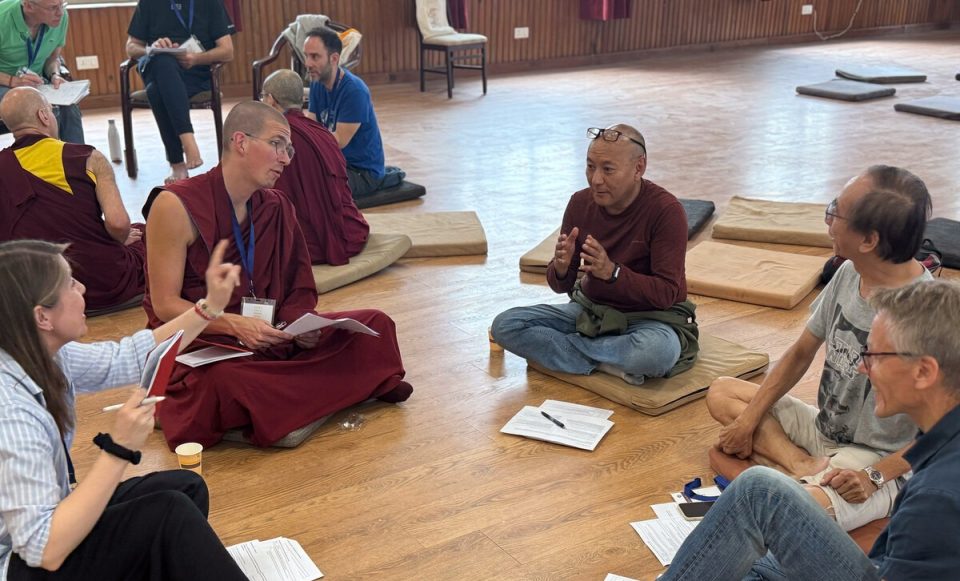
Lively discussions at CPMT 2025. April 8, 2025. Photo by Capucine T. Dekyong.
FPMT International Office will be sharing conclusions and action points from these sessions very soon—the team is collecting and processing all the valuable data collected from these discussions.
The Vast Visions, Compassion in Action, April 10
On the last full day of the meeting, Lama Zopa Rinpoche’s Vast Visions were discussed in a presentation by Ven. Roger Kunsang and Ven. Holly Ansett. It was incredibly powerful to hear from Ven. Roger, who was by Lama Zopa Rinpoche’s side nearly every moment from 1986 until Rinpoche’s passing into parinirvana in 2023, providing context for Rinpoche’s Vast Visions. These ambitious wishes for the organization were originally presented to Ven. Roger and Ven. Holly Ansett in 2007 on several blue sticky notes. From those sticky notes, Ven. Roger and Ven. Holly were able to identify four key areas: Offering Service to His Holiness the Dalai Lama, Creating and Displaying Holy Objects for World Peace, Supporting Practice and Realizations, and Social Services.
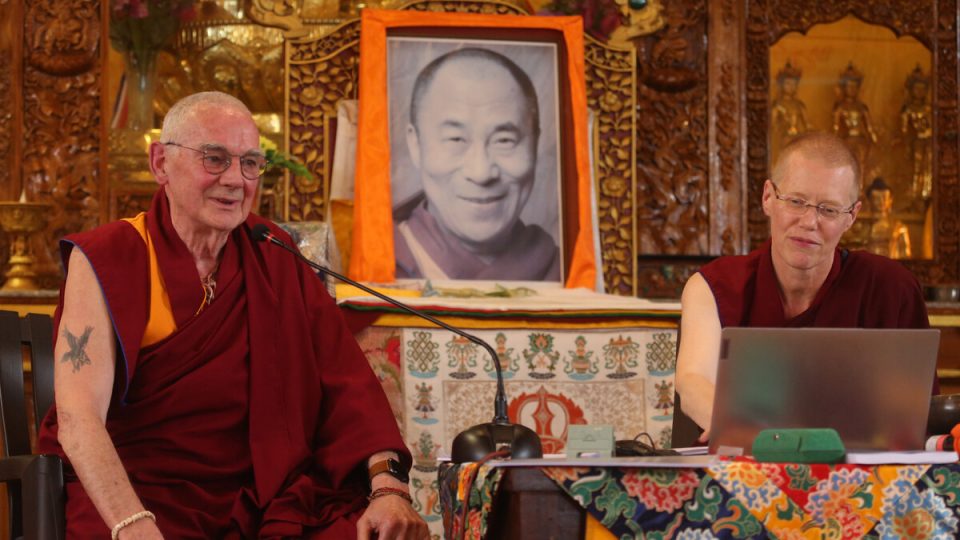
Ven. Roger Kunsang and Ven. Holly Ansett presenting Lama Zopa Rinpoche’s Vast Visions, April 10. Photo by Capucine T. Dekyong.
Ven. Holly presented each of Rinpoche’s Vast Visions in detail, outlining which visions are well underway in terms of actualization, and which projects still need energy and support. The sheer scope of each vision was incredible to see laid out, and it became so clear how much work we all must do to help make Rinpoche’s incredible wishes manifest, and to rejoice in how much has already been done. Prior to this presentation on the Vast Visions, inspiring stories and words of encouragement were shared.
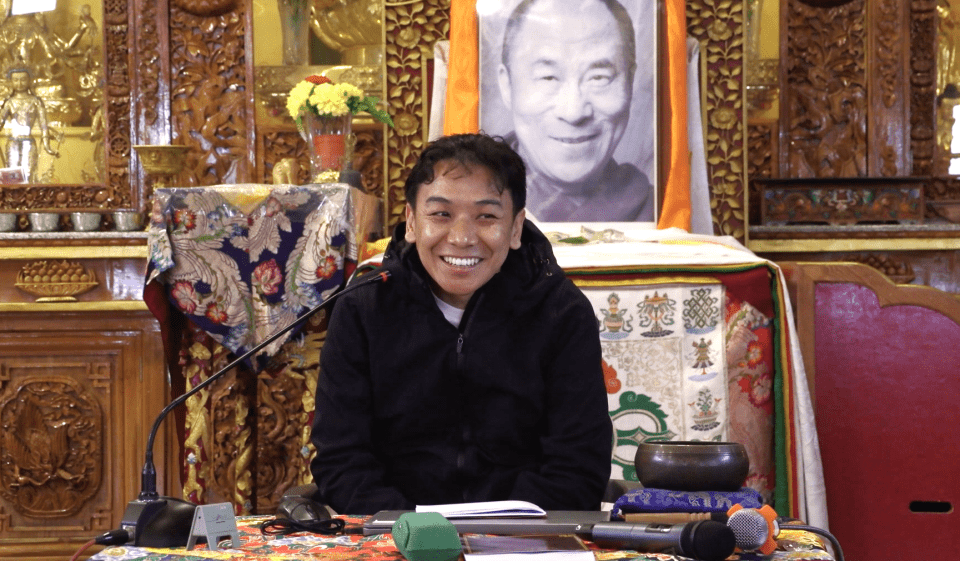
Charok Lama addressing the group, April 10, 2025.
Charok Lama began the day with an incredibly moving talk, reminding us that every action we engage in can be done with compassion, as was continually expressed by Lama Zopa Rinpoche. “The practice of compassion can be applied in any field” he reminded us. “You are one, others are countless, therefore compassion is extremely important.” Following the conclusion of the meeting, Charok Lama shared the following additional reflection of the entire CPMT Summit:
“I was invited to the CPMT meeting, and for me, it was an extremely educational and amazing experience. One of the main reasons is because I got to meet so many people who are deeply passionate about Kyabje Lama Zopa Rinpoche and Lama Yeshe’s visions.
“Of course, it’s impossible to fulfill everyone’s expectations completely. But I could see that everyone was doing their best, with genuine compassion, to try to resolve the challenges that come up. There was a real sense of openness — not just openness to understanding, but also openness to accepting feedback from others regarding the changes that need to be made.
“Overall, for me personally, it was extremely educational and very productive. I just hope that it’s not only a gathering of discussions, but that moving forward, these discussions are turned into real action — that is my humble request. Secondly to all students of Lama Yeshe and Kyabje Lama Zopa Rinpoche, FPMT has made many, many of the visions of the guru come alive and it is utmost important to resolve any disagreements by the practice of generosity, forgiveness and compassion. Let go of the ME and the MY (just for this) and think of what we can offer back to the gurus and to work together instead of working against, no matter what the case. We as students of the guru need to prove that our gurus taught us well. With a big heart, vast visions, and unlimited possibilities.”
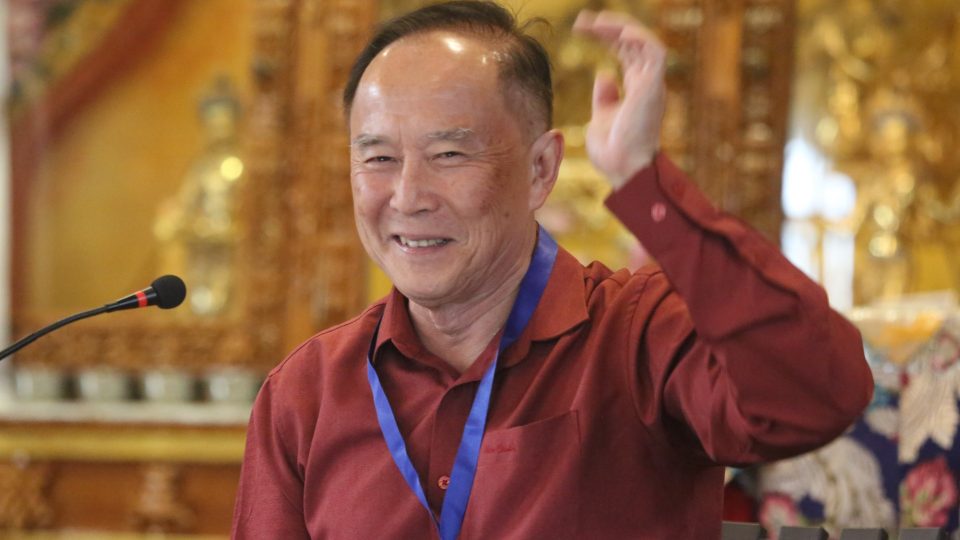
Hup Cheng, the longest serving center director within the FPMT organization, director of Amitabha Buddhist Centre, Singapore. Photo by Capucine T. Dekyong.

Some of the Australian contingent at Kopan Monastery: Tony Steel, Dave Andrews, Ian Green, and Brian Ashen. Photo courtesy of Ian Green.
Amitabha Buddhist Centre in Singapore Director, Hup Cheng, who is the longest serving center director within the FPMT organization, presented on “Using Technology to Construct Holy Objects.” Hup Cheng is truly an innovator. As he explained, he was given a long list from Lama Zopa Rinpoche of holy object projects to complete, and due to his unbelievable resourcefulness and creative thinking, he’s able actualize these projects. Hup Cheng described how he uses many methods, including big format printing, laser cutting technology, 3D scanning and printing, statue scan and replication, animation, and holograms! Hup Cheng’s enthusiasm and excitement about technology was so palpable: “That’s the power of digitalization! Once you scan an image and digitize it, you can upscale it as big or small as you want!”
Ian Green then addressed the group again and offered a jaw-dropping history of the Great Stupa, in Bendigo, Australia, whose actualization was a heart wish of Lama Yeshe’s. In 1980, Ian’s father had offered fifty acres of land to build a Buddhist center in Bendigo. The initial gift of land was added to by Ian’s mother and himself, accumulating into 200 acres. Lama had visited Bendigo in 1981 and was impressed by the strong community and support for Buddhist endeavors. Lama laid out his master plan for the entire site to Ian and artist Garrey Foulkes. The plan was to replicate Tibet’s 600-year-old Gyantse Stupa (Kumbum). In addition, there would be a monastery, a nunnery, a Buddhist center, aged care facility, group accommodation, a library, interpretive center, a restaurant, hotel, a village, and even a primary school. Right in the middle of all this, is the Great Stupa of Universal Compassion, which is 50 meters square at its base and nearly 50 meters high, making it the largest stupa in the Western world. Beautiful gardens surround the Stupa and the Peace Park showcasing symbols from many faiths including Catholic, Sikh, Islam, Hindu and Buddhist.
Ian also introduced the Jade Buddha for Universal Peace, which is the largest Buddha carved from gemstone quality jade in the world. After a world tour of 120 cities in 20 countries, blessing over 12 million people, the Jade Buddha is now at home at the Great Stupa. The gompa sat in stunned silence hearing about these magnificent projects.
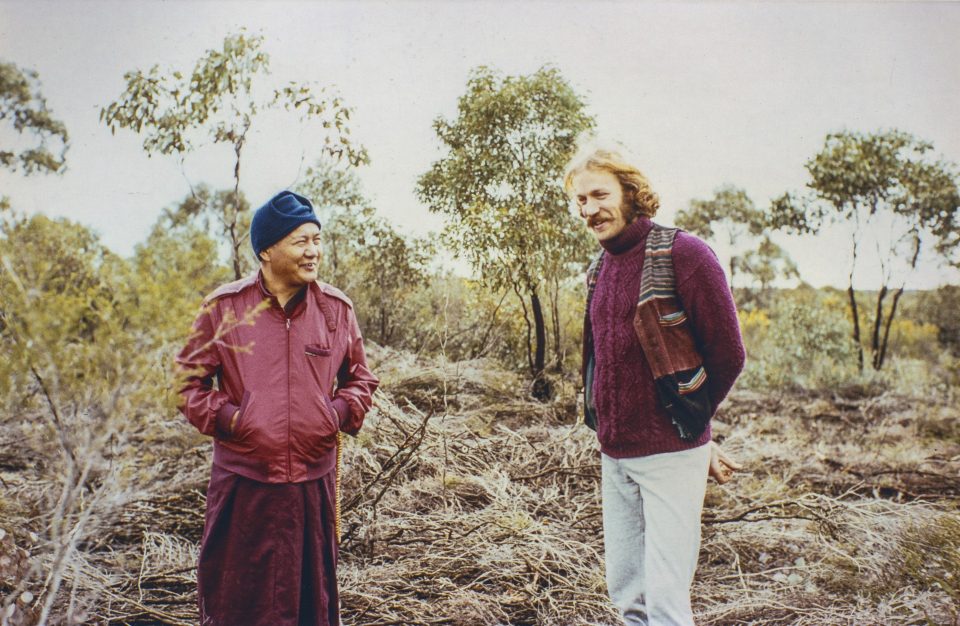
Lama Yeshe with Garrey Foulkes, Bendigo, Australia, 1981. Photo courtesy of the Lama Yeshe Wisdom Archive.
Maitreya Project Trust Director Virgina Roche offered an update on the Maitreya Project in Kushinagar. Those unfamiliar with Virginia’s personal story were deeply moved and impressed by her powerful presence, perseverance, and tenacity. “Rinpoche asked me to jump, and I replied… how high?” Virginia previously ran a leading construction company in the middle east. Rinpoche asked her to do for Maitreya Project what she had done for her own company in terms of success. Virginia has been involved in the Maitreya Project since 2017 from the outside, and since 2019 from the inside as director. She shared some of the tremendous struggles the project has faced but was also very enthusiastic about the “light at the end of the tunnel” coming for the project.
“The twenty-two-year-old stale mate finally comes to an end as we prepare to sign an MOU (Memorandum of Understanding ) with India’s leading Buddhist confederation called, The IBC (The International Buddhist Confederation) that participates and organizes several Buddhist programs and conclaves nationally and internationally. Soon we will be in a position to start the much-awaited Maitreya Project in Kushinigar,” Virginia shared, along with many details of the progress, obstacles, setbacks, and successes over the past twenty-two years of this project.
Next, Ven. Losang Gendun, an FPMT Registered Teacher and member of Mind & Life Europe, a multidisciplinary laboratory that brings together researchers and contemplative practitioners to explore the nature of experience, gave a talk on Inter-contemplative Collaboration, which is an expansion of the types of conversations commonly known as “inter-religious dialogue.” Ven. Gendun has a unique approach to this, whereas he wasn’t just interested in having discussions where participants from various backgrounds share their individual views, but instead find common views to tell a story which goes beyond the concepts of “religion” that is more inclusive to various views of life, including secular views.
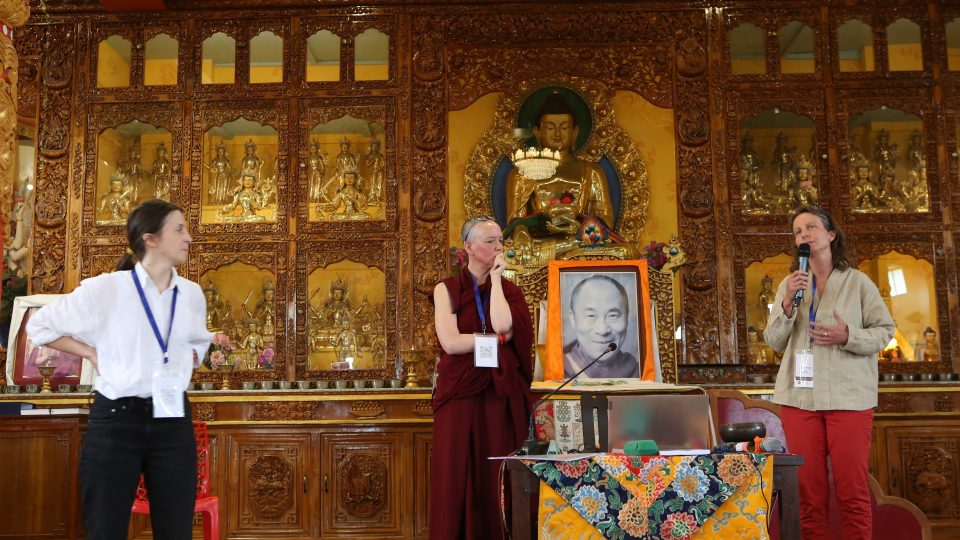
Carina Thorén, Ven. Thubten Drolma, Lisette Reek presenting on climate change. Photo by Capucine T. Dekyong.
Jamyang Buddhist Centre London director Ven. Thubten Drolma; SPC of Maitreya Institute, the Netherlands, Lisette Reek; and Yeshin Norbu director in Sweden, Carina Thorén, offered a presentation addressing climate change. They asked us to consider the connection between the offerings of a Dharma center and the ongoing social and environmental upheavals of which we are all a part. “What if,” they asked, “Dharma centers were catalysts for change in the planetary crisis.” The team discussed key takeaways from the recent Planetary Crisis Summit hosted by Jamyang London as well as other ongoing efforts to continue these important discussions.
Next, Universal Education and the Foundation for Developing Compassion and Wisdom (FDCW) was discussed by three presenters: Jeff Highfill, Director of FPMT Education Services; Pamela Cayton, founder of Tara Redwood School and Creating Compassionate Cultures; and Angela Sanchez, FDCW Operations Manager.
Jeff discussed the need for a true understanding of what is meant by Universal Education and how centers can most effectively offer this as a key aspect of their courses and program.
Pam Cayton discussed her history with Universal Education. She lived at Kopan and helped to educate the monks from 1978-1988, particularly the youngest monks. Pam shared Lama Yeshe’s vision of Universal Education, which presented Buddhist wisdom and methods in a way that was accessible and relevant to all people, regardless of their religious background. This approach aimed to be both scientifically and logically grounded, making the principles of Buddhism understandable and applicable to everyday life. Lama Yeshe believed that by presenting the Dharma in a clear, rational, and universal manner, it could resonate with a wider audience and contribute to a more compassionate and peaceful world. Pam started the Tara Redwood School in 1989 in California, based on the Creating Compassionate Cultures (CCC) pedagogy.
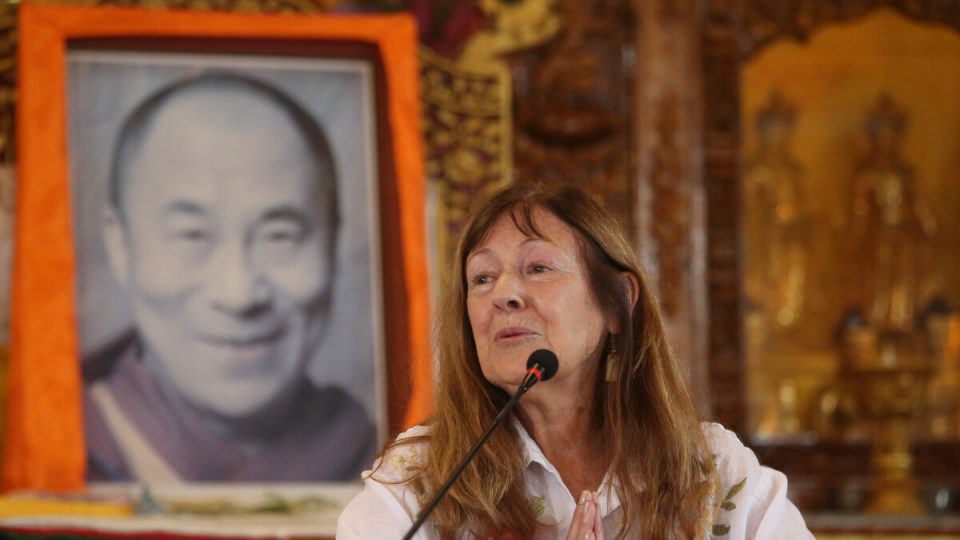
Pam Cayton presenting to the CPMT group on Creating Compassionate Culstures. Photo by Capucine T. Dekyong.
Angela Sanchez gave an overview of the Foundation for Developing Compassion and Wisdom (FDCW) and how new communities of FDCW facilitators are growing and flourishing around the world including a new development of the 16 Guidelines Meditation Course, which centers can use in their own programming.
Angela invited Ven. Gyalmo to discuss the development of 16 Guidelines for Life in Mongolia. Among their efforts in social services, they recently completed translations of the 16 Guidelines children’s resource book Ready, Set, Happy, and The 16 Guidelines for Life Book. The 16 Guidelines for Life Book was created by FDCW to offer a practical framework for enhancing one’s life and well-being. The guidelines are designed to deepen our understanding of ourselves, cultivate compassion, and promote a more meaningful and fulfilling life. The guidelines are organized around four main themes: 1) How we think, 2) How we act, 3) How we relate to others, and 4) How we find meaning.
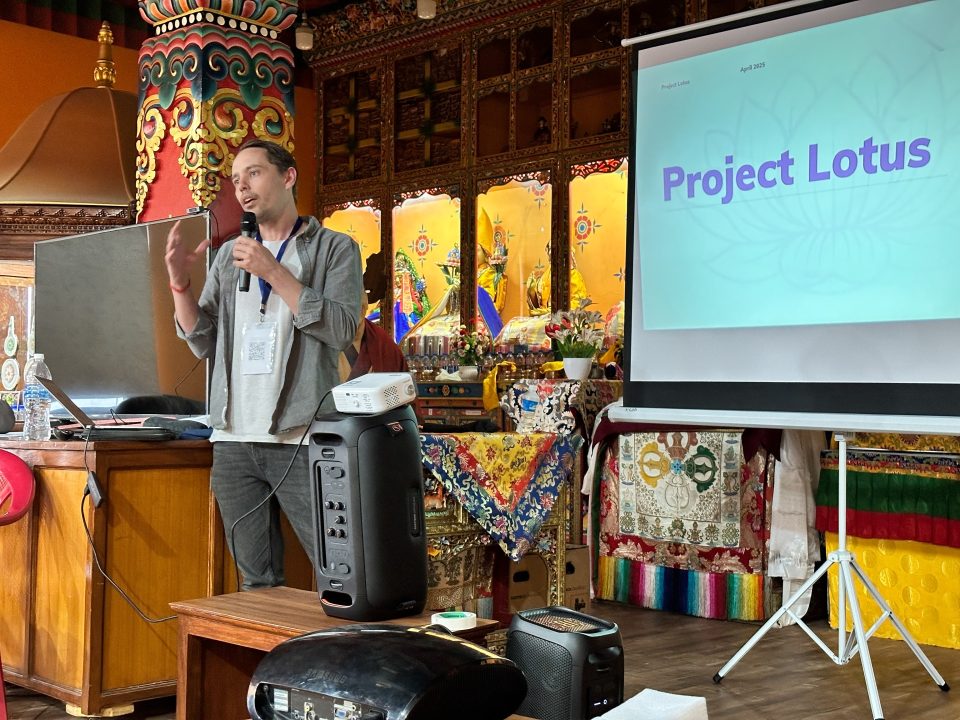
Matt McArthur presents Project LOTUS . Photo by Capucine T. Dekyong.
Following this, it was a “choose your own adventure” afternoon, where various participants shared details about their Compassion in Action initiatives and attendees could learn how they might incorporate some of these ideas into their own programs and projects. The innovation sessions and topics of interest included: Mental Health, the Lama Yeshe Wisdom Archive, International Mahayana Institute (IMI), Foundation for Developing Compassion and Wisdom (FDCW), Creating Compassionate Cultures (CCC), Reaching the Elderly in our Community, Climate Change, Project LOTUS (a global event website prototype), In-Depth Meditation Training, Global Harmony, a visit to the Animal Liberation Sanctuary, and Maitripa College.
Many of us circulated through as many presentations as we could fit into the afternoon. How inspiring to hear these presenters share passionately on topics and projects so close to their hearts. It was easy to feel that indeed, “anything is possible, everything is possible,” as Lama Yeshe used to remind students.
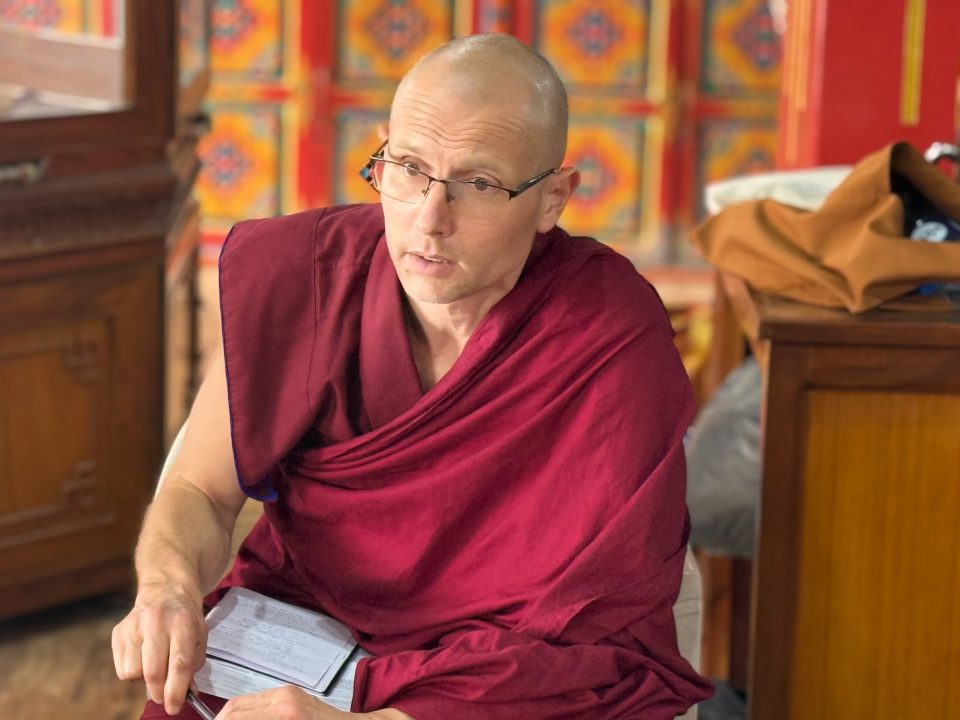
Ven. Tenzin Gache discussing during the CPMT Summit. Photo by Capucine T. Dekyong.
Ven. Tenzin Gache, an American monk and director of the IMI House at Sera Je Monastery, who is currently in the geshe studies program at Sera Je, reflected about the event: “There’s a sense that it’s up to us now. Without Rinpoche here, we have to use our own wisdom to find the way forward. And there’s a sense that though it won’t be easy, that we can do it. We can do it if we work together, and each of us works to subdue our own minds. I was impressed by the maturity of the people in leadership positions within the organization.”
Integration and Next Steps, April 11
On the final day of the Summit participants were given the opportunity to share some of their key impressions of the event. These takeaways, along with details of the evaluations/surveys participants have completed, will be shared in detail soon.
This was also a day for thanking all the various groups of people who helped ensure the meeting was a success, including: the entire Kopan staff who offered “ten star” treatment to all participants, leaders of the optional morning meditations, the track facilitators, the presenters, the translators, the tech support team, the photographers, the CPMT meeting organizers, the FPMT International Office staff, and the facilitator of the event, Jennifer Kim, who was praised for her tireless effort and dedication helping to make the event a reality with such thorough engagement.
In addition to the work of the organizers, facilitator, and everyone else involved in making the event a reality, the behind the scenes work of the tech team was truly indispensable and should be highlighted: Alexis Ben El Hadj and Harald Weichhart set up extensive equipment to ensure good audio quality in the gompa as well as made sure audio and video recordings (both on camera as well as on the computer) were created reliably to preserve the event. The requirements were even more complex than usual as many presentations included slide shows and several speakers presented via Zoom, all of which required continuous changes in the setup in very short time. Real time translations were provided in Spanish (Ven. Paloma), Italian (Ven. Siliana), French (Vens Chantal, Chokyi, and Lhamo), and Chinese (Chun Hui Chang).
About the event, Jennifer reflected, “I was deeply inspired by the care, commitment and wisdom coming from the attendees of the CPMT meeting. It gave me hope that collectively we can preserve our Lamas’ legacy and benefit others in newfound ways for years and even generations to come.”
The morning began with Yangsi Rinpoche, President of Maitripa College, joining the group via livestream. “I want to really rejoice, this is like fifty years of Rinpoche’s prayers and the students’ dedication that contribute to the flourishing of the FPMT Mandala,” Yangsi Rinpoche said. “The flourishing of individual students, projects, Dharma centers, the directors, and communities are due to their dedication together. This is really a source of rejoicing, as is our dedication to our teachers, particularly Kyabje Lama Zopa Rinpoche and Lama Yeshe”.
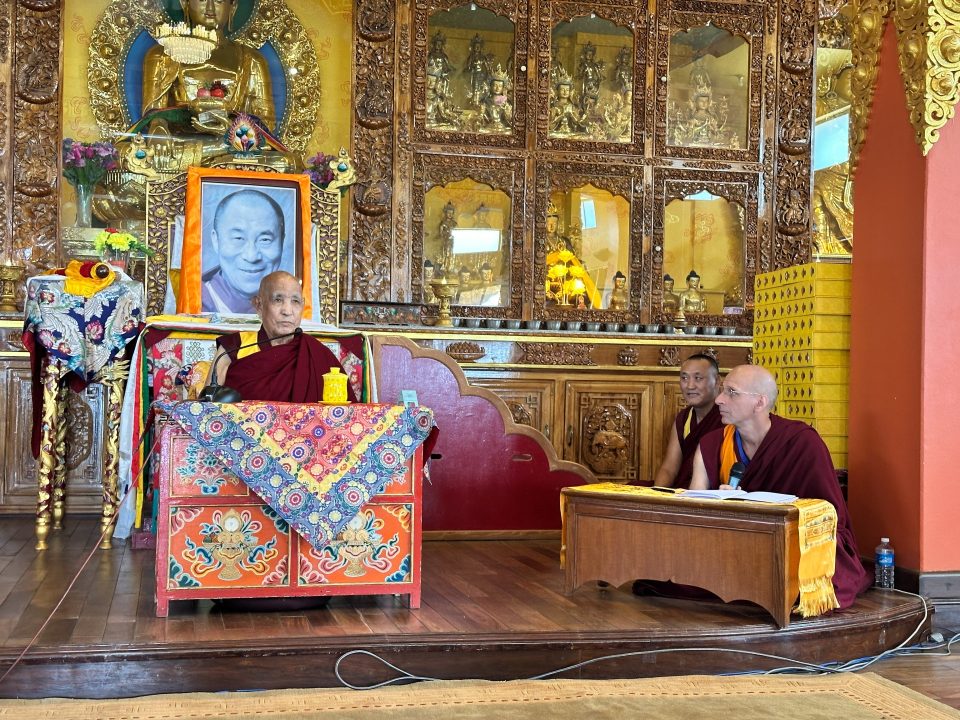
Trisur Rinpoche Jetsun Lobsang Tenzin addressing the CPMT group, April 11, 2025. Photo by Harald Weichhart
After morning tea, Trisur Rinpoche Jetsun Lobsang Tenzin joined the group personally to share a few words of encouragement:
“It’s very excellent that you all have come here and gathered together, and through your discussions with each other at this conference, it’s very important that you come to conclusions about what are the most important things that we want to do in the organization, and be clear about that. Going forward, one of the most important things will be to decide on that. And each of you, as you go back to your own centers, to carry that message with you, and tell others, and to actually put into practice what was concluded here, so in the future, we can see visible results from this meeting.
“It is important for each of you to make effort in your study and practice and really work well together. And for each of you to take responsibility to work together, because that’s the only way as an individual or as an organization that we grow. If we just do something on our own, it won’t be of much benefit. So please do this together.”
Trisur Rinpoche then consecrated beautiful boxes with a stupa of Lama Zopa Rinpoche’s holy blood relics that were then offered to each participating center by Khenrinpoche Geshe Chonyi.
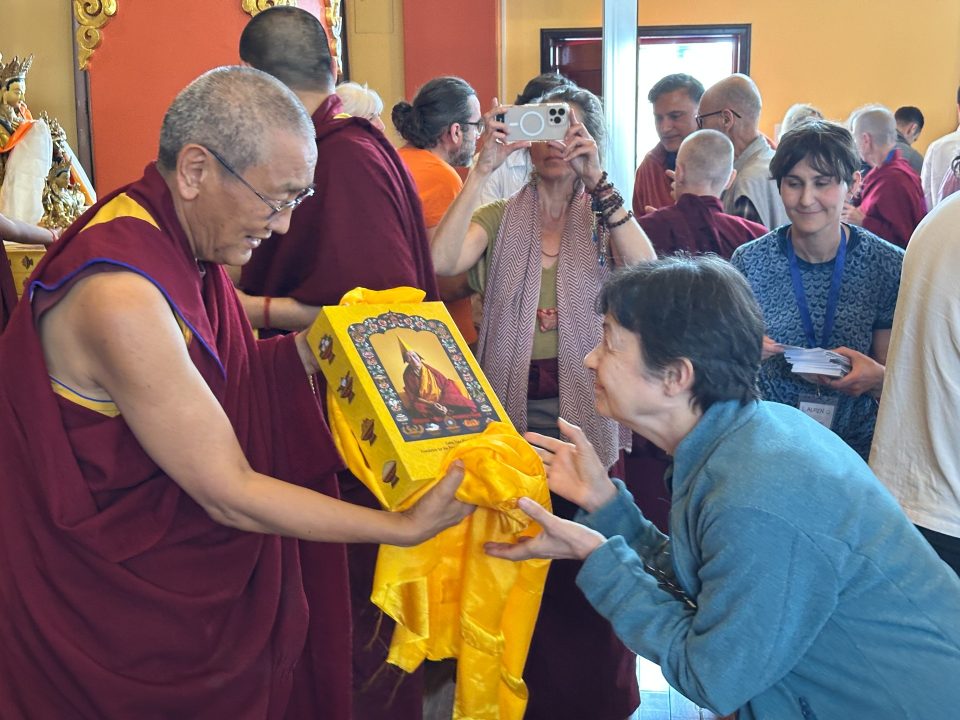
Beautiful boxes with a stupa of Lama Zopa Rinpoche’s holy blood relics were offered to each participating center by Khenrinpoche Geshe Chonyi. Photo by Harald Weichhart.
Two raffles were held on this final day—one recipient, Tara Liberation Study Group, Finland, received a copy of Big Love: The Life and Teachings of Lama Yeshe from the Lama Yeshe Wisdom Archive, and Arya Tara Institut, Germany, was the recipient of a beautiful Tara thangka which was offered by Ven. Roger Kunsang. In 2022 Lama Zopa Rinpoche explained as one of his Vast Visions that he’d like Tara thangkas continuously made for protection of the FPMT organization. This was the first thangka painted for this purpose, and it was offered to the center chosen in the drawing (Arya Tara Institut) with the commitment that the center will offer Tara puja once a month, dedicated to the success and protection of the FPMT organization.
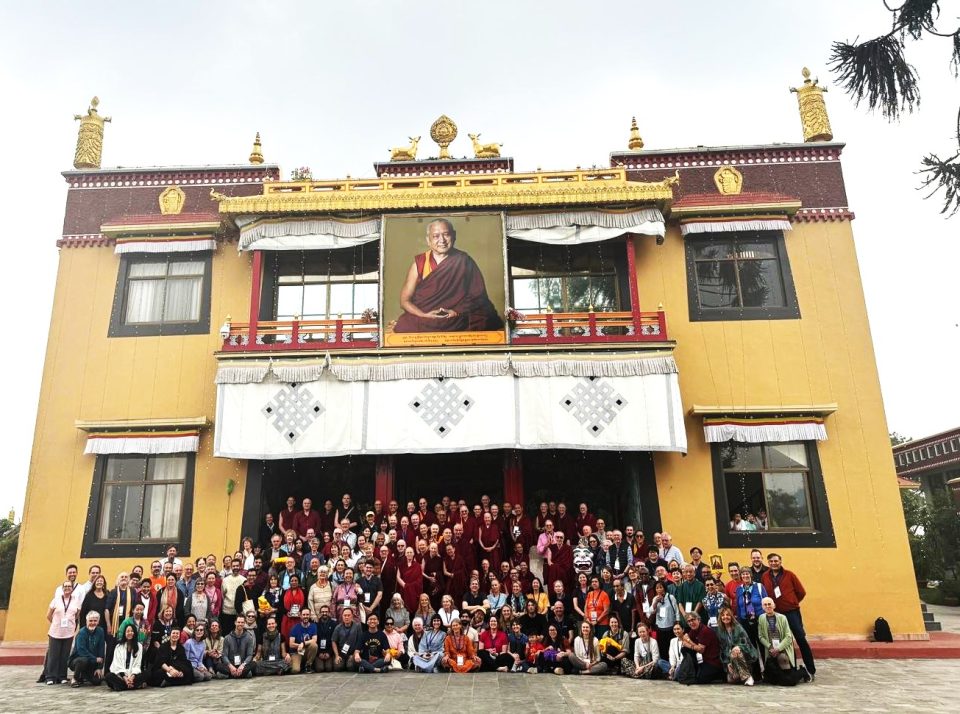
CPMT 2025 participants group photo.
The event finished with a joyful group photo taken in front of the main gompa, and lunch together, snapping our final selfies and exchanging contact info with energetic plans to continue conversations, collaborate on projects, and keep better communication with one another.
For the next couple of days, many participants stayed on at Kopan to participate in smaller group meetings with colleagues, engage in pilgrimage and group prayers at Swayambunath and Boudhanath Stupas, enjoy meals out together in Kathmandu, and join the Kopan Sangha and community for the second anniversary puja and prayers commemorating the parinirvana of Lama Zopa Rinpoche.
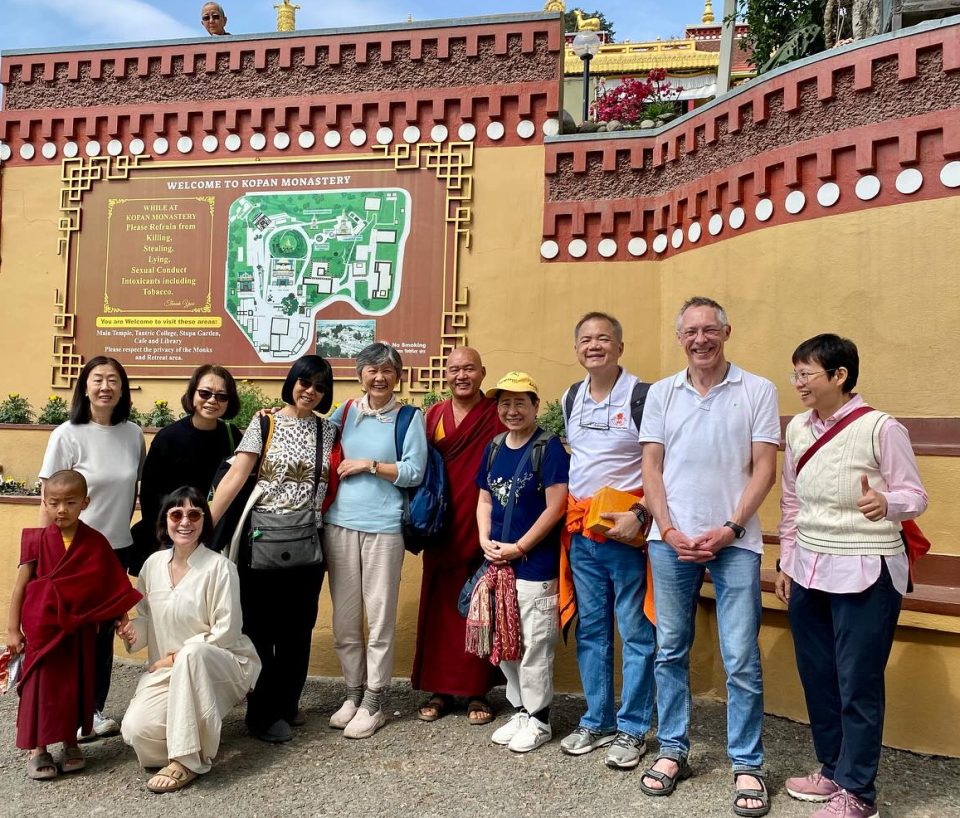
Some of the Malaysian contingent bidding a temporary goodbye, as they prepare to fly back to the land of Nasi Lemak! Photo courtesy of Selina Foong.
Ven. Joan Nicell shared this reflection about our group prayers for Lama Zopa Rinpoche’s swift return at Boudhanath Stupa. This event turned into a bit of a wild Kathmandu experience for us all—we originally had obtained permission to assemble at the first level of the stupa for our group session, but due to a misunderstanding, we had to move back down to the street in the middle of our session—picture nearly 200 of us carrying and moving mats and the altar through the shoulder-to-shoulder packed crowds and arranging ourselves on the sidewalk among the pigeons:
“The day after the CPMT meeting ended, we gathered together at the holy stupa of Boudhanath to pray for Rinpoche’s swift return. In spite of the many curious people who stopped to stare and take photos of the crowd of foreigners doing prayers in English and the flocks of pigeons pecking at the corn scattered on the ground, the feeling was of a great big family joining voices and hearts to request Rinpoche to quickly come back to guide us once again,” Ven. Joan shared.
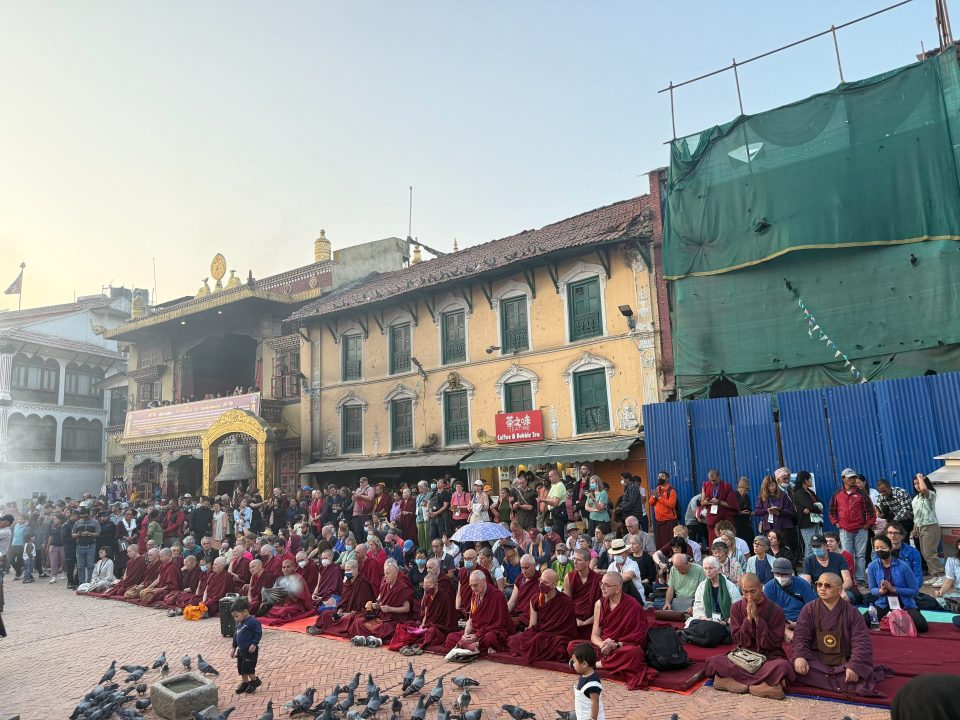
CPMT participants reciting prayers together at Boudha Stupa, April 12, 2025. Photo by Capucine T. Dekyong.
A Deeply Connected Community
Throughout the Summit, optional daily practice sessions were offered, including morning meditation using Lama Zopa Rinpoche’s How to Make My Lives Wish-Fulfilling, and each evening included an optional group activity such as the premiere of a new documentary, Vision of Lama Zopa Rinpoche: Pure Land of Guru Rinpoche at Lawudo, by Capucine T. Dekyong who was also our on-site photographer for this event, snapping an incredible 9,000 photos and video clips! About the event, Capucine shared:
“Shooting the event was like a dance, heart to heart with harmonious friends of the FPMT family. I did my best to extract the essence and inner beauty of participants—A reflection of our guru devotion, guiding us to co-create the future of the community!” All are welcome to enjoy a selection of these photos as well as contributions from others in this photo gallery.
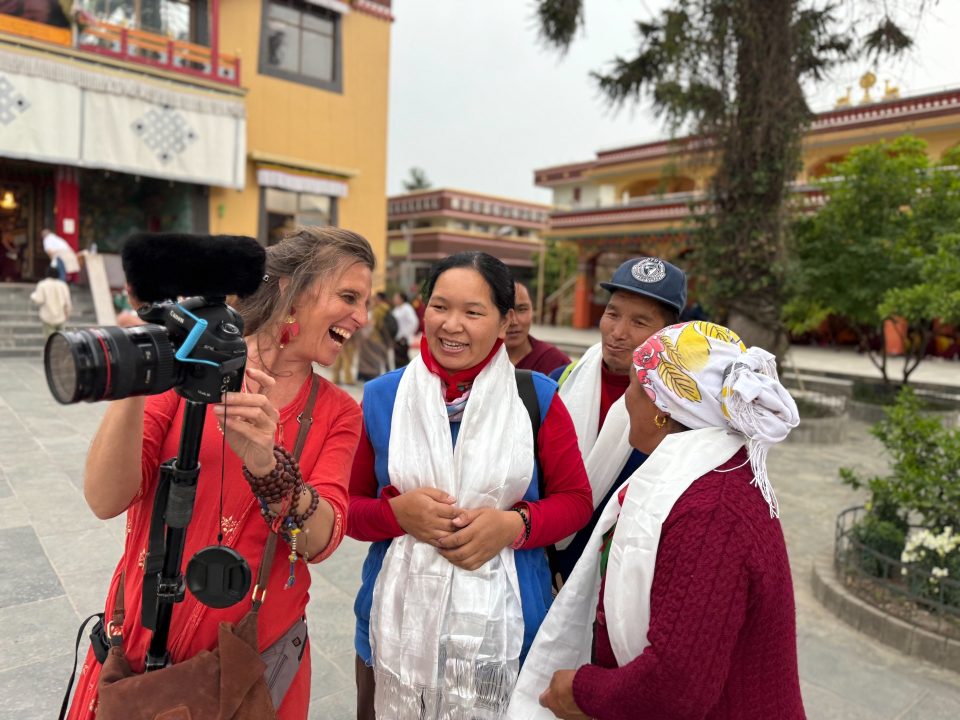
Capucine joyfully shooting the 2025 CPMT Summit.
Paula de Wys reflected on the event at its conclusion:
“This CPMT Summit was truly extraordinary. There was a sense of happiness that was present from the beginning—the happiness of being together at Kopan expressing our thoughts and ideas on how we are continuing our work for the lamas and the Dharma and then having the opportunity to help improve so many aspects of that work. We were inspired by what others are doing and we also worked hard on the future, looking at what needs to be done to make our dreams a reality. The positive energy of the first day remained strong during the whole meeting and made it indeed a truly extraordinary CPMT!”
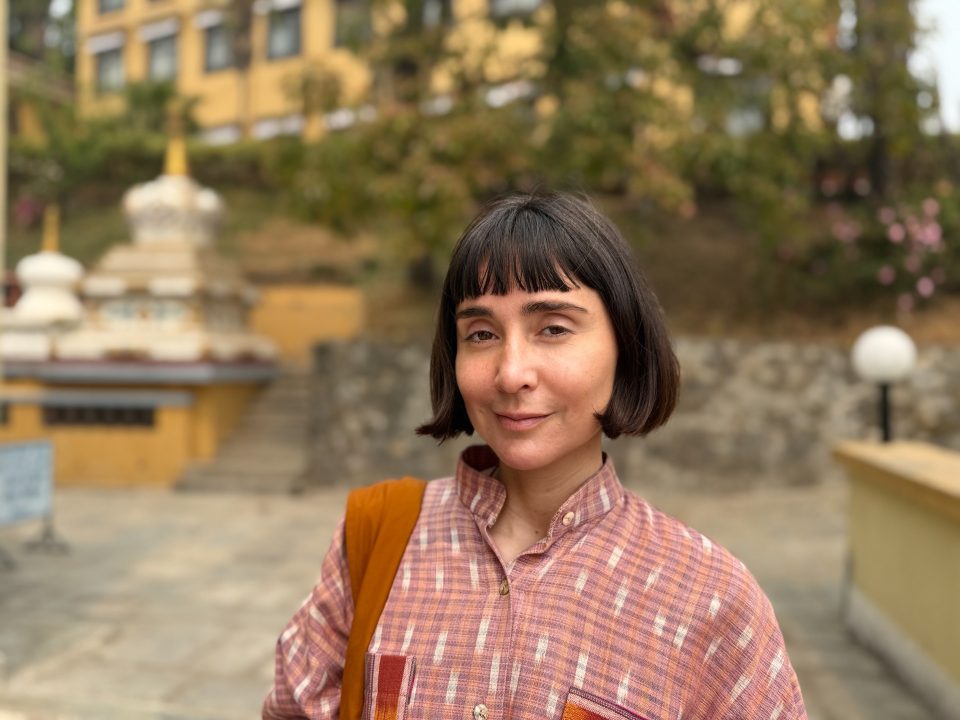
Kopan Monastery SPC, Francisca Riaño during the 2025 CPMT Summit. Photo by T. Dekyong.
Kopan Monastery SPC, Francisca Riaño, shared the following insightful comments about the CPMT Summit, which really captures the spirit of the event shared by many:
“The CPMT meeting was an experience I will cherish forever. If I could distill it into one word, it would be ‘together.’ The feeling was like family, and it was a humbling honor to help organize a gathering that brought together 195 participants, including some of the earliest students of Lama Yeshe and Lama Zopa Rinpoche, as well as a 5-year-old whose joy lit up the room. The energy and legacy of our founding lamas were palpable throughout, and many felt deeply connected to the community they built.
“I was moved by the efforts of the board, the International Office, and our dear Kopan team, who worked tirelessly to make this gathering a reality. We faced challenges—such as a car crashing into an electricity post during a live Zoom session with Ling Rinpoche, causing a temporary loss of connection—yet the spirit of the gathering never wavered. The energy at Kopan remained vibrant, reminding us of the strength and resilience of our global Sangha.
“For those of us serving at centers like Kopan, it can sometimes feel isolating, especially for newcomers. This gathering was a powerful reminder that we are not alone, our network is strong, and we have kindred spirits to walk this path with us. With 70 centers represented out of 133, all gathered where it all began, it was a deeply moving experience, a warm embrace for the heart and a reminder that, in a world marked by separation, coming together is the only way forward.
“Discussions around caring for the planet and preserving our lamas’ lineage highlighted the inseparable link between inner work and outer responsibility. Connecting with fellow practitioners and honoring those who have guided many of us on this path was truly inspiring. Today, there is a clear sense of direction, and our commitment to co-creating a ‘world guided by compassion and wisdom’—the theme of the gathering—is stronger than ever.”
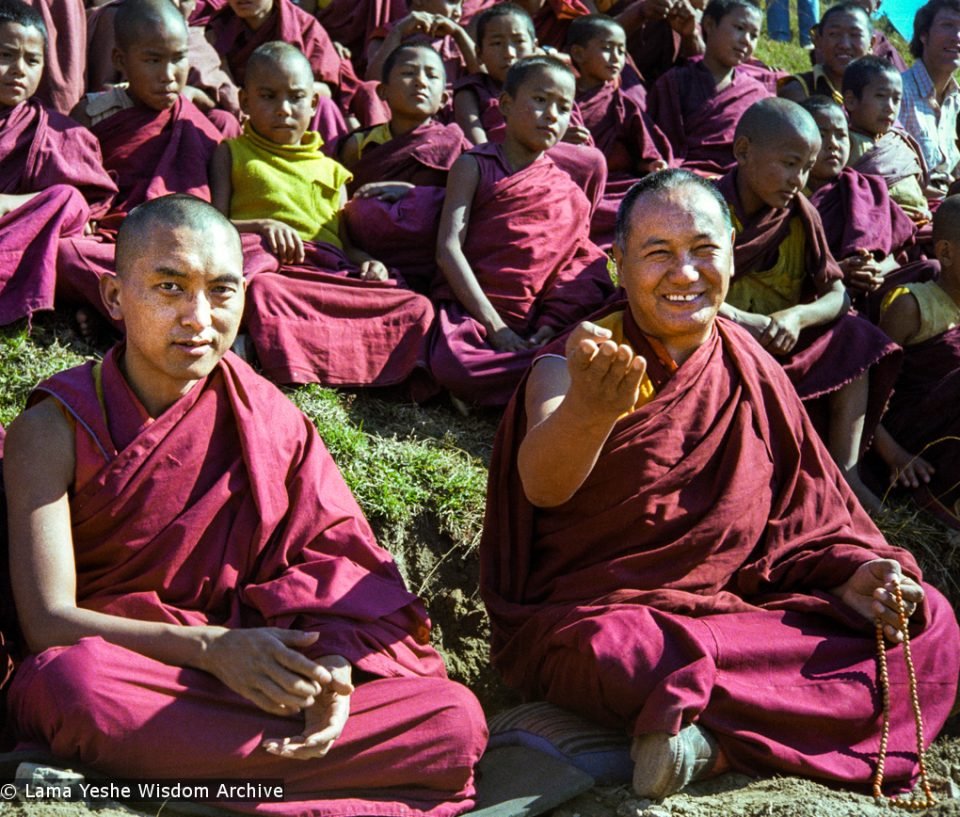
Lama Zopa Rinpoche and Lama Yeshe at the 12th Meditation Course, Kopan Monastery, Nepal, 1979. Photo by Ina Van Delden, courtesy of Lama Yeshe Wisdom Archive.
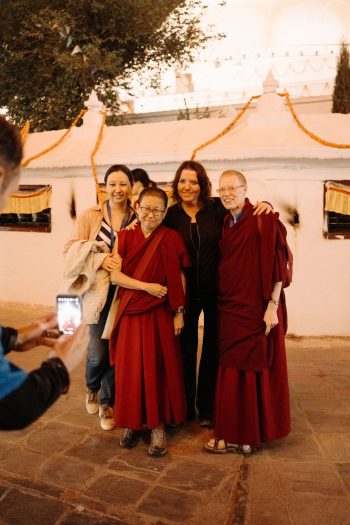
FPMT International Office friends and colleagues: Zarina Osmonalieva, Ven. Tenzin Tsomo, Carina Rumrill, Ven. Holly Ansett, in front of the Boudha Stupa after a meal together. Photo by Matt Linden.
May this collective effort and enthusiasm from the goodhearted and sincerely-motivated participants and organizers of this momentous meeting, blessed by our most kind teachers, create the causes for the FPMT organization to thrive and flourish long into the future so it may continue benefiting sentient beings through the ongoing actualization of our lamas’ incredibly vast vision, put into motion fifty years ago at the heart of it all—Kopan Monastery, and carried forth by every single person tirelessly working, supporting, studying, practicing, teaching, and actualizing the path within the FPMT mandala.
Written by Carina Rumrill, Managing Editor for FPMT International Office with tremendous thanks to Justin Jenkins, Harald Weichhart, Capucine T. Dekyong, Matt Linden, and the International Office staff and Board of Directors for their help providing editing suggestions, details, media, and technical support as this story took shape.
Carina has worked for the FPMT organization since 2004, first with Ven. Robina Courtin at the Liberation Project Project when it was based in San Francisco, CA, USA. She joined the FPMT International Office team in Portland, OR, in 2008 as Managing Editor and Publisher of Mandala magazine and has since worked in various capacities within the communications department. She lives in Vermont.
Foundation for the Preservation of Mahayana Tradition (FPMT), is a Tibetan Buddhist organization dedicated to the transmission of the Mahayana Buddhist tradition and values worldwide through teaching, meditation and community service.
18
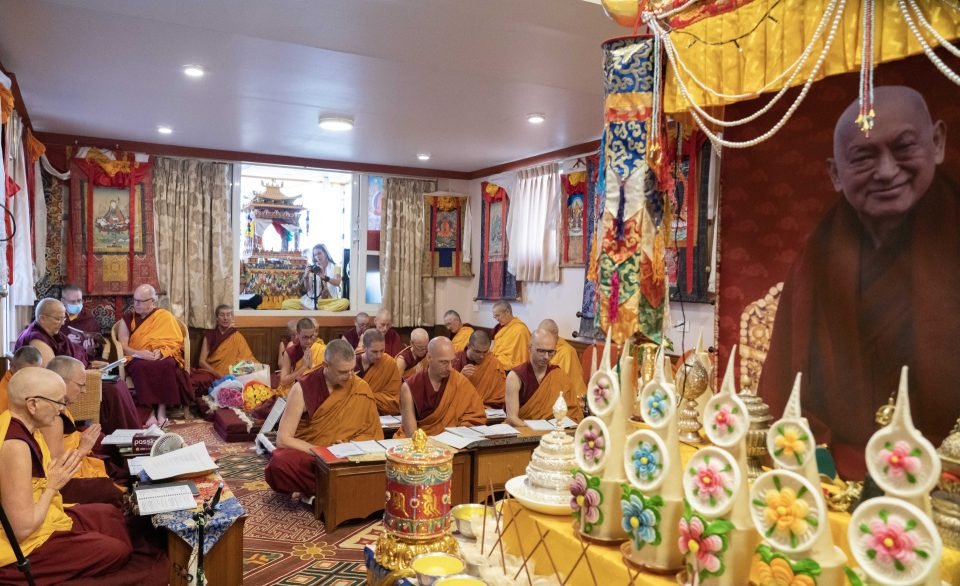
International IMI Sangha offering prayers each day in front of Lama Zopa Rinpoche’s holy body, Kopan Monastery, Nepal, April 21, 2023. Photo by Ven. Lobsang Sherab.
“It’s simply impossible to express how beautiful it is in Rinpoche’s room right now,” Ven. Sarah Thresher shared on her Facebook page from Kopan Monastery on May 4, 2023, two weeks after Lama Zopa Rinpoche showed the aspect of passing away on April 13, 2023. “Kopan has done everything to make it the most extraordinarily beautiful and breathtaking offering for Rinpoche. I hope you all will have a chance to visit in the future and appreciate the love and devotion and majesty of Rinpoche’s mandala. I have watched this transformation over the past two weeks and I’m so grateful.”
We are so fortunate that Ven. Sarah took the time to share what it has been like at Kopan during this devastating and moving time. With Ven. Sarah’s permission, we are sharing some of the detailed reports she has written about how “every inch of Kopan” has been in prayer and service as several thousand individuals have come to pay respects to Rinpoche and process this immense loss. The supportive and kind atmosphere, impeccable coordination and handling of logistics, and the care and detail needed for Kopan to receive and care for hundreds of guests from around the world daily—this effort at a time of losing the guru is something to truly consider and rejoice in.
We have kept Ven. Sarah’s entries dated so readers can appreciate how the events were being experienced in real time.
April 23, 2023: It All Happened So Fast!
I was at Kopan shortly after Rinpoche arrived back from Tsum—having received a cryptic message that it was “very important” I come up immediately. When I arrived at the monastery it was strangely quiet and I wondered around trying to find somebody to talk to—at the same time messaging a friend in Tsum to see if I could get some clues. When I reached the stupa garden I met some people I knew in shock and gradually the truth started to be revealed…
It all happened so fast! Those early hours were confused and the initial days were a time of shock, disbelief and grieving. We didn’t definitively know what had happened that day until the email from Ven. Roger was sent out—so that was roughly the same time as everyone else around the world found out. We knew that Rinpoche had returned from Tsum, there was an emergency situation and the news was bad—but nobody wanted to express the words that would make things clear. We were simply told that “Rinpoche was in meditation… His Holiness says Rinpoche has not yet gone.”
That first afternoon monks gathered for a Cittamani Tara puja in a strangely empty main gompa joined by a handful of Westerners. It was quite surreal—hard to believe this was actually happening. Kopan was full of new people attending an introductory course, which was gradually cancelled as nobody had the will to teach any more.
The second day we began to do Tara prayers at the Chenrezig gompa in English. His Holiness’ immediate advice had been to do Cittamani Tara Four Mandalas. We were still just a few people as many of the usual residents at Kopan were gone. A lot of time those first few days was taken up responding to messages from around the world and encouraging people to come if that was in their heart, even though we had no idea how things would unfold. It was hard to sleep or eat. The mobile phones were “ringing off the hook” and that added to the tension and distress.
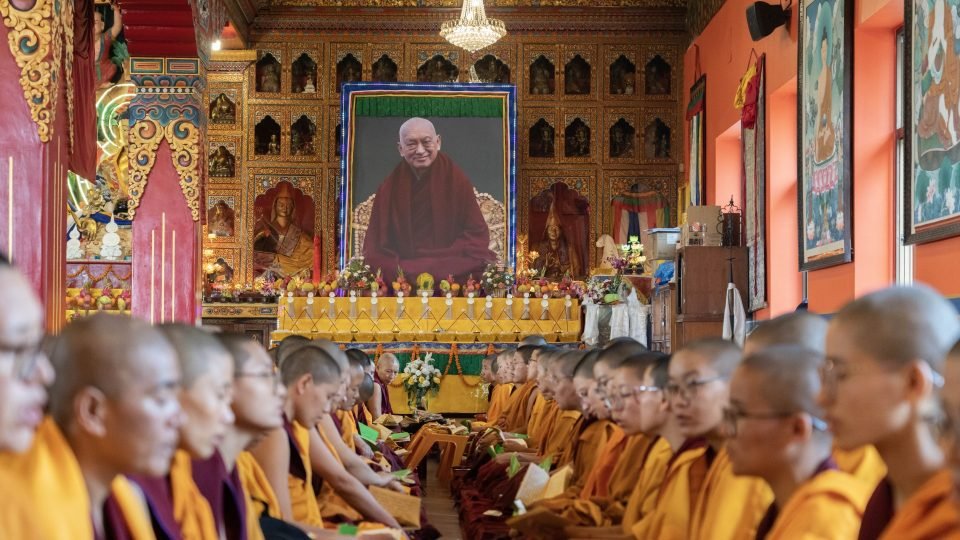
Chittamani Tara puja in Kopan Moanstery gompa, Nepal, April 17, 2023. Photo by Ven. Lobsang Sherab.
By the fourth day people from the introductory course had mainly left and Rinpoche’s students were starting to arrive from around the world. By now, we had a full schedule of prayers in the Chenrezig gompa. The day began with Rinpoche’s morning motivation and 35 Buddhas’ prostrations before breakfast, then Lama Chopa Jorcho before lunch, Cittamani Tara Four Mandalas in the afternoon, and Vajrasattva practice with dedication prayers after dinner. Of course there were prayers in the main gompa all day long with the Kopan monks and nuns but everything was in Tibetan and chanted very fast so it was hard to follow. Ven. Roger had requested a program for English speakers as well.
Interspersed with the prayers we began small group sessions for people to share about how they met Rinpoche, what Rinpoche meant to them, how they heard the news, and how they felt going forwards. This was very healing, moving and inspiring. When Osel Rinpoche arrived he agreed to come and talk to us. He told us not to focus on the loss but on the gratitude for everything we had received—then we would always feel Rinpoche in our hearts. It was powerful advice.
The monks and nuns of Kopan were extremely impressive. From the moment Rinpoche entered into the final meditation mandalas, torma, and all the necessary materials were assembled and a rota of shifts manifested so that the prayers in the room next to Rinpoche’s holy body were unceasing day and night. As the days unfolded and more and more people arrived, it felt as if every inch of Kopan was in prayer. Upstairs there could be different groups of tantric monks and high lamas and heart disciples in prayer in the different rooms at Rinpoche’s apartment, while down in the main gompa monks and nuns packed into the space to do extensive prayer sessions and recitations. Outside in the debate courtyard there was tea and snacks for visitors; and groups were coming to do their own very moving practices to pay tribute to Rinpoche. Meanwhile the young monks huddled together to recite mani mantras and we internationals were following our own schedule in the Chenrezig gompa.
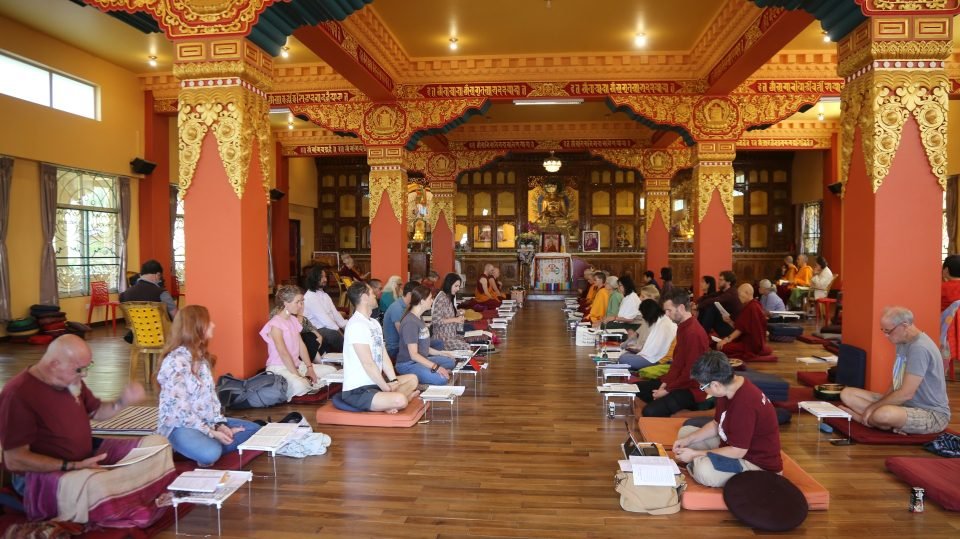
Students doing prayers for the swift return of Lama Zopa Rinpoche in the Chenrezig gompa. April 21, 2023. Photo by Capucine
Redon.
It was so moving to see the high lamas who, from their own side, immediately flew in to Nepal to do prayers, the many students from around the world, and masters and disciples from other traditions come up from the valley to pray and practice out of respect for such a great holy being.
Also incredible has been the generous sharing of images of Rinpoche in meditation and livestream of the continual prayers and the tributes and long life prayers, which meant that people all over the world could feel connected to Rinpoche and what was happening here.
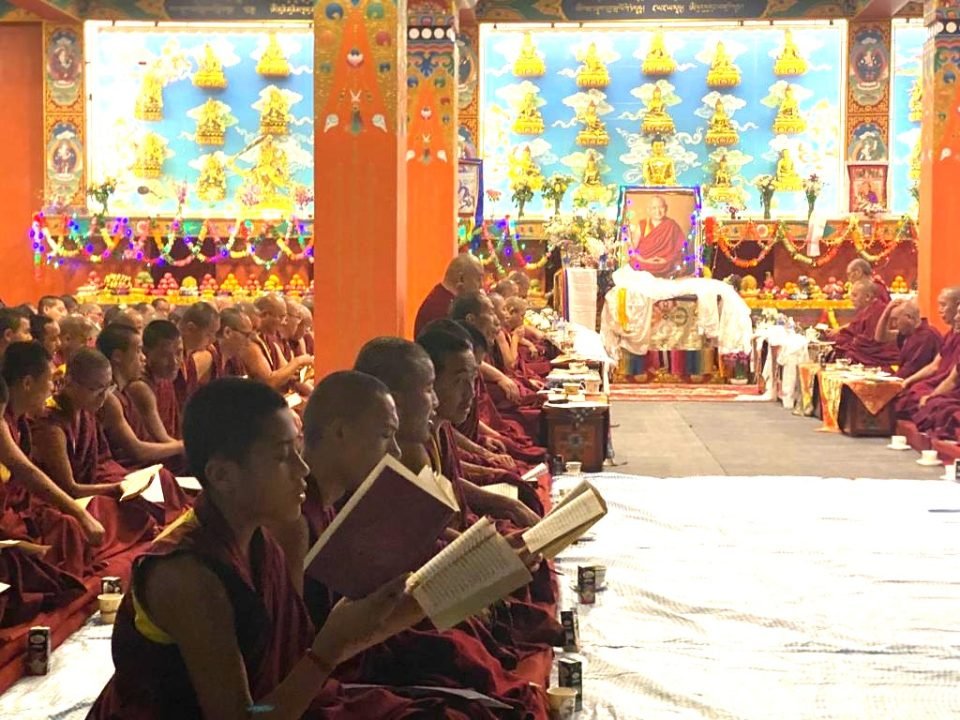
Young monks in prayer at Kopan Monastery. Photo by Alison Murdoch.
We are now on the 11th day. The extraordinary abundance of pujas all over Kopan has calmed. Prayers are still held at Rinpoche’s holy body non-stop. Our retreat schedule of prayers for the international students continues and now in the afternoon we split up into three groups: one in the Chenrezig gompa doing Tara puja, one at the Boudha Stupa offering room doing the extensive offering practice, and one that does prayers in English advised by Khen Rinpoche Geshe Chonyi at Rinpoche’s holy body.
We have a routine to facilitate reflection on lamrim as Khadro-la advised, people are being so kind and supportive to each other, and outside caterers make sure we are well fed and nourished. People are coming from around the world for a day, two days, a week, a month, as they wish to pray and pay respect to our most incredibly cherished and kind Spiritual Guide, to make sense of this great loss and reflect on the future. I see people arrive in tears and leave with laughter and a renewed sense of commitment to continue and fulfil whatever advice Rinpoche has given.
My heart aches for those who were not able to meet with Rinpoche. Those of us who did will always cherish our time spent together and the teachings we received. I can only hope that we can communicate some of that extraordinary blessing to others.
May Rinpoche quickly return in a new incarnation to guide us, and may we all continue his most incredible work, complete the projects, abide purely in our commitments, and always be most pleasing to the Spiritual Guide.
May 2, 2023: Twenty Days of Sorrow, Twenty Days of Gratitude
It’s been twenty days now since Rinpoche suddenly left us—twenty days of sorrow, twenty days of continual prayers and practices, twenty days of offerings and twenty days of unending gratitude for having met Rinpoche and all we have received.
Upon hearing the initial news, many people’s hearts turned to Kopan. The early days were filled with pujas and prayers in every corner of Kopan with many monks and nuns and locals. Then, within days, people were flying in from around the world to pay respect to Rinpoche and gather for prayers and practice. That has been truly inspiring—as Rinpoche used to say before we would offer long life puja, “The prayers the lama does for the disciple have great power and the prayers the disciples do for the lama have great power.”
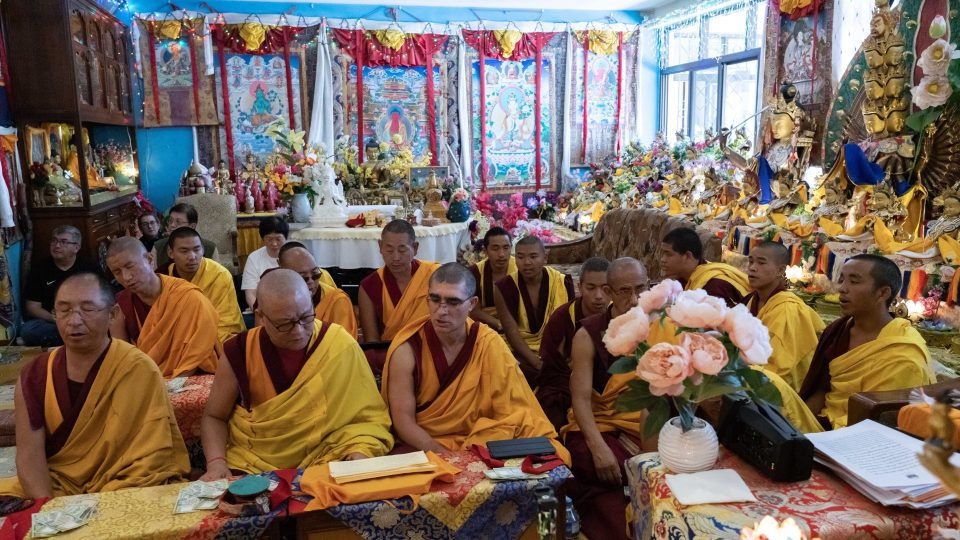
Kopan senior monks and Lama Gyupas offering prayers in front of Rinpoche’s holy body, Kopan Monastery, April 22, 2023. Photo by Ven. Lobsang Sherab.
Now all that busy-ness has calmed. There is still continual practice at Rinpoche’s holy body by different groups throughout the day and night which is livestreamed for all to share. The Kopan tantric monks do Yamantaka self-initiation early morning, the Thame monks from Solu Khumbu do Chenrezig practice early afternoon, the Westerners do various prayers late afternoon, and the Kopan nuns do Vajrayogini self-initiation every evening. There is also all-day Heruka Lama Chopa Tsog every 7th day with the monks and nuns and lay people coming together. Additionally, people are always welcome to come and offer khata to Rinpoche’s holy body and make prayers and circumambulate as these practices are happening. The mandala house where Rinpoche’s holy body is kept becomes more and more beautiful every day. There are silver bowls and butter lamps, banners and parasols and pennants and silk khatas, pearls and food and incense and flowers all around. The sacred and blessed energy in Rinpoche’s room—the place where in recent years Rinpoche spent most of the time—is palpable.
As things begin to calm, many of the visitors who initially arrived are now leaving and we international guests have trimmed down our “retreat-style” practices to a morning session of Lama Chopa Jorcho and an afternoon session of Cittamani Tara or other prayers with occasional pilgrimages. Those who leave express gratitude for the time spent here—the sharing, the opportunity to be part of this gathering of disciples and the blessing of feeling Rinpoche’s presence, and also the hope for the future.
Last week Yangsi Rinpoche very kindly agreed to talk to us before leaving Kopan—though not to be recorded. It took the aspect—as I perceived it—of a profound sharing from a highly accomplished disciple to us newbies—and I hope its okay to share just a few of my reflections on what Rinpoche said—though not everything.
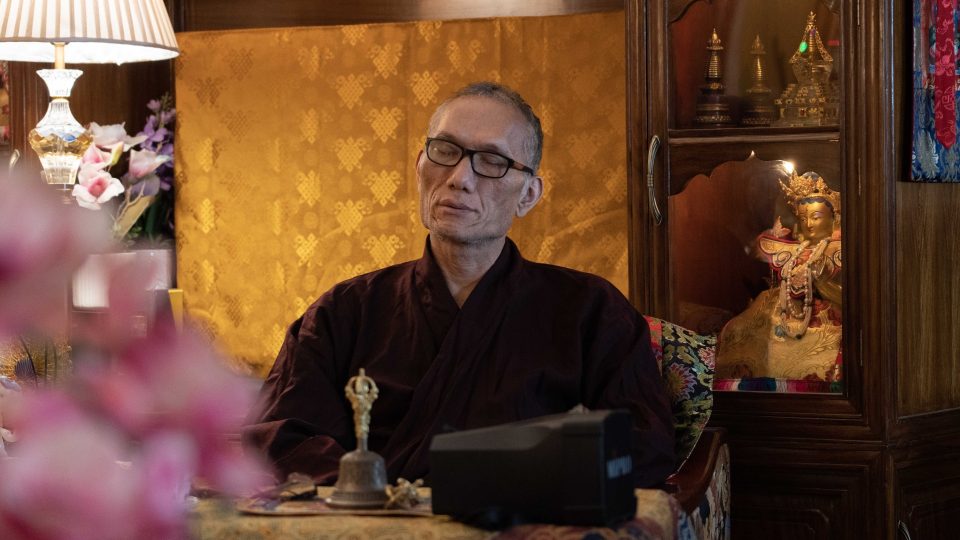
Yangsi Rinpoche offering prayers at Kopan Monastery, April 20, 2023. Photo by Ven. Lobsang Sherab.
Yangsi Rinpoche spoke about how we should consider ourselves most fortunate to have actually met Rinpoche—as Rinpoche will now take a place in history as one of the great masters. Up to now we have been carried along by Rinpoche’s great compassion and vast enlightened activity, but the free ride is over. Now it’s time to repay that kindness. We owe it to Rinpoche to continue the work he began and particularly to take responsibility for Rinpoche’s main project—to free us from our self-cherishing and self-grasping. Yangsi Rinpoche expressed that yes pujas and prayers are good—but if we can reduce our self-cherishing and self-grasping for even a second it is the best offering and Rinpoche will shower us with flowers and cheesecake from the pure lands!
Yangsi Rinpoche also mentioned that Westerners have a unique karmic connection with Lama Yeshe and Rinpoche. Just as we read about previous buddhas making prayers to benefit different beings at different times, it seems Lama and Rinpoche made prayers to benefit the hippies in degenerate times! There are other highly qualified lamas but we didn’t have the connection with them—it was Rinpoche and Lama that brought us onto the path. Therefore, we have a particular responsibility and owe it to Rinpoche to repay the kindness—to reduce the thought that we are the center of the universe and everything is about me, me, me and instead work for others.
Rinpoche has given us enough teachings for several lifetimes. It’s not necessary to go and find another guru—we already have what we need. Now we owe it to Rinpoche to practice and internalize what we have received. And, as for Rinpoche, he is now everywhere—free from the limitations of the physical body.
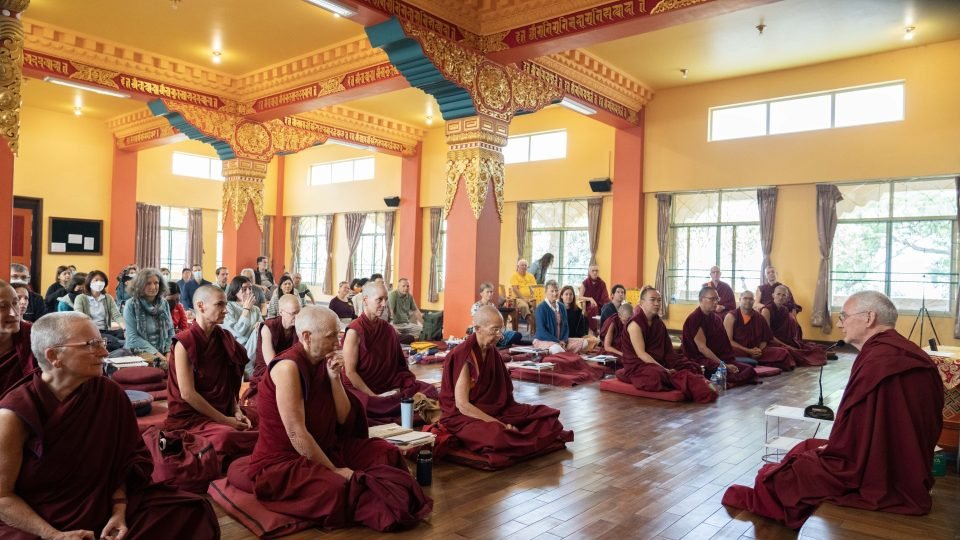
Ven. Roger Kunsang giving talk to the International Sangha and students explaining the details around Lama Zopa Rinpoche showing aspect of passing away, April 28, 2023. Photo by Ven. Lobsang Sherab.
Ven. Roger also came one night to talk to us after returning from a meeting with His Holiness Dalai Lama in Dharamsala. He walked us through what had happened leading up to and then on the actual day that Rinpoche left us. It was quite emotional for many of us listening and also not to be shared. There is a video of the meeting with His Holiness now available for all to view and His Holiness clearly says that he will take personal responsibility to check for Rinpoche’s reincarnation—there is great hope for the future.
The prayers will continue here at Kopan until May 31 when many people are expected to join for the final puja. I hope all of you will rejoice and join with us in supporting what the monastery is doing. Thank you.
May 6, 2023: We Wait, We Pray, We Continue—We Try to Repay The Kindness
Outside the Kopan gates people continue to arrive from around the valley and further by taxi, by car, by scooter, by plane, walking—visiting the beautiful mandala that has become Kopan to pay respects to the crown jewel—our most precious lama. They are greeted by the nuns in the debate courtyard at tables with snacks and chai before winding their way upstairs to Rinpoche’s room.
Rinpoche who continuously prayed during his lifetime to benefit those who saw, touched, or even thought about him—continues to do so after passing. He gave his holy body to us while he was alive and left it for us now that he is gone—always showing the most extraordinary activity of a great bodhisattva. I cannot express enough my gratitude to HE Ling Rinpoche for advising us to keep and preserve Rinpoche’s holy body—every atom of which is a pure holy relic. We can also receive and treasure blessed salt from the embalming process as a holy relic.
Upstairs two nuns are stringing Swarovski pearls flown in from Singapore with local precious stones to adorn Rinpoche’s mandala house. A few days ago the old mandala house was replaced by a new cabinet made by the carpenters and painted by the local artists. There are now silks and brocades, pennants, banners, umbrella, khatas, fruits, flowers, silver bowls, lights, and an extraordinary beautiful display of offerings that adorn the new mandala house. It’s simply not possible to describe the sacred energy in Rinpoche’s rooms where prayers continue to take place around the clock and visitors stream by to pay respect. People will usually sit and join the prayers for a short while before leaving with their choice of photo of different shots of Rinpoche—each one beautiful and printed with the slogans we have come to know and love below Rinpoche’s image—“Live with compassion, work with compassion, meditate with compassion, die with compassion, enjoy with compassion…” “Less desire means less pain…” etc.
The normal schedule for us internationals is relaxed today as we just completed an all-night Tara practice—the Tara Purification Ritual. Tara practice was recommended by His Holiness Dalai Lama within the first hours of Rinpoche entering meditation and this Tara night practice was composed by Rinpoche’s other root guru His Holiness Trijang Rinpoche. We have been doing Tara continuously but last night took the opportunity of the lunar eclipse to stay up and praise, prostrate, make offerings, and circumambulate Tara from sunset to sunrise. It was a special night. The Tara altar was set up in the Chenrezig gompa but people could also circumambulate in the stupa garden where trees of lights offered by Chinese students over the past years illuminate the holy objects—and all of this as Rinpoche’s holy voice sang out the Twenty-one Tara Praises for us to follow.
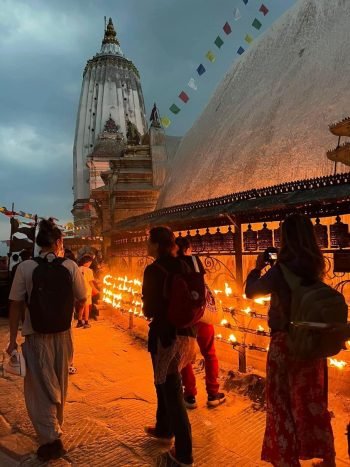
Light offerings by students at Swayambhunath Stupa, April 23, 2023. Photo by Bec French.
The mood at Kopan is good. So many people have flown in for just a few days and left uplifted. Rinpoche is so present everywhere and of course we feel him at the heart center of the FPMT—Kopan—where it all began. But those who fly in also go on pilgrimage to the other holy places in the valley—the three great stupas, the special White Tara, Pharping and so on—to offer prayers. Some have even made the trip up to Lawudo to sit and pray in Rinpoche’s cave and gompa.
A week or so ago, Ven. Roger gave a talk about the events around Rinpoche leaving us. Nobody expected this or could have anticipated it. It was a last final teaching to cut our habitual concept and clinging to permanence. At the end I asked him about the advice for the future. He replied: “The advice is simple—we continue the work Rinpoche has done. We repay the kindness.”
And so we wait, we pray, we continue. Nobody can take the place of Rinpoche except Rinpoche’s next incarnation. However long that takes, none of us have been left with our hands empty—there are so many projects and centers to benefit others. Over half a century Rinpoche has given so much advice, so many teachings and practices. When Rinpoche returns, instead of having to subdue barbarian and hippie Westerners to bring them on to the path for their own and others’ ultimate benefit, let’s hope we are ready to go. As Rinpoche said at a CPMT meeting some years back—FPMT has not begun yet. There is nothing but hope for the future.
May 11, 2023: Kindness and Support
Yesterday was the fourth week since Rinpoche entered the final meditation. It’s been an intensive time for everyone but there has also been so much kindness and support.
From the beginning Kopan has focused on the prayers for Rinpoche and the guests who come to pay respect and participate. Within days, the monastery was welcoming eminent high lamas including the Ganden Tripa, Segyu Khen Rinpoche Geshe Wangdu, Tengye Rinpoche and senior Gyume tantric sangha; FPMT teachers and lamas, such as Yangsi Rinpoche, Khadro-la, Phuntsok Rinpoche, Geshe Sherab from New Mexico, Geshe Tsondu from Malaysia and Osel Rinpoche; great masters from other traditions such as Chokyi Nima Rinpoche and sangha came up from Seto Gompa, and Dilgo Khyentse Yangsi, Khenpo Gyurme Tsultrim, Lama Lungrig Nyima and sangha came up from Shechen Gompa in Boudha. Representatives have come from major and minor monastic institutions in India and Nepal—Mahayana, Vajrayana, and Theravadin—to pray at Rinpoche’s holy body, sponsor prayer sessions and make offerings to the sangha. And so have politicians and other well-known individuals. The respect shown to Rinpoche—and the support and kindness shown to Rinpoche’s sangha—has been moving and constant.
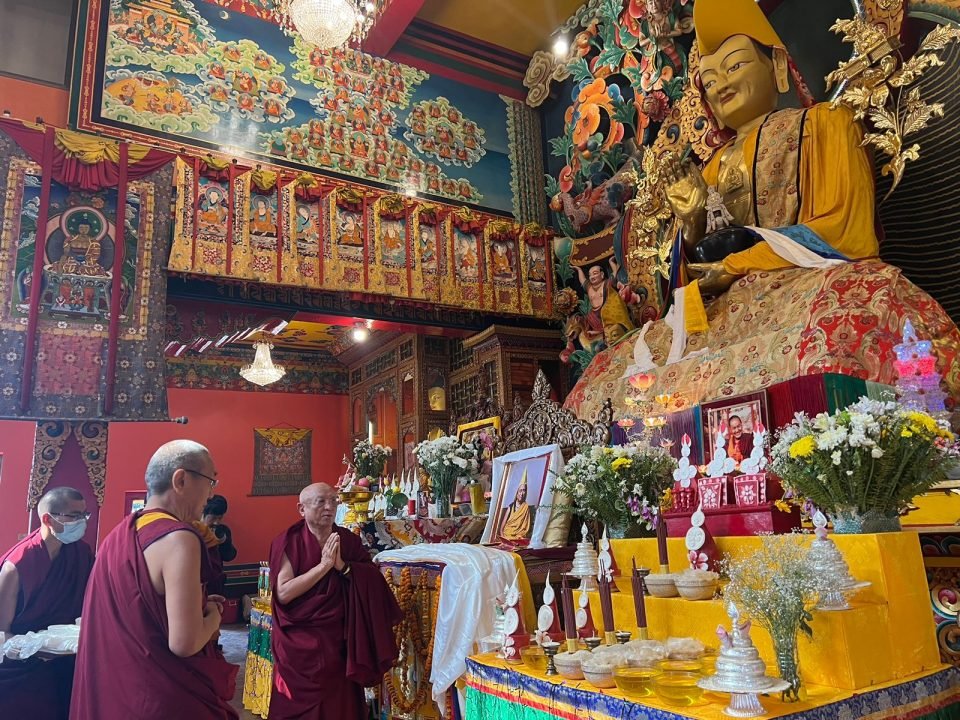
Khenrinpoche Thubten Chonyi and Chokyi Nyima Rinpoche at Kopan Monastery amidst the continual offering of prayers for Lama Zopa Rinpoche’s swift return. April 18, 2023. Photo by Kopan Monastery School.
Yesterday, the fourth week, was no exception. The Namgyal abbot, Thamtog Rinpoche flew from Dharamsala along with accompanying students to offer prayers at Rinpoche’s holy body and sponsor the full day’s puja. Thamtog Rinpoche was a childhood friend of our own precious lama since they were both disciples of Geshe Rabten at a young age. Rinpoche recalled knowing Lama Yeshe, Rinpoche, and Lama Lhundrup well at Buxa and watching as they traveled extensively spreading the pure teachings of the Buddha and especially of Lama Tsongkhapa all around the world. Rinpoche and Thamtog Rinpoche were close friends and during the puja Thamtog Rinpoche offered consolation to all of us grieving disciples with a moving speech in both Tibetan and English which brought many of us to tears.
Also at the puja yesterday was Serkong Dorje Chang Rinpoche who had flown back from a Wesak teaching event in Pokhara in time to attend. And Tsoknyi Rinpoche, another great lama friend of Rinpoche’s came to Kopan with some Tsoknyi nuns to offer prayers at Rinpoche’s holy body and make offerings to the disciples. As we sat in the puja in the main gompa below, we could hear the beautiful chanting of the Tsoknyi nuns in Rinpoche’s apartment above. How can we ever express enough gratitude to these lamas who show kindness and support to us at this time when we need it most?
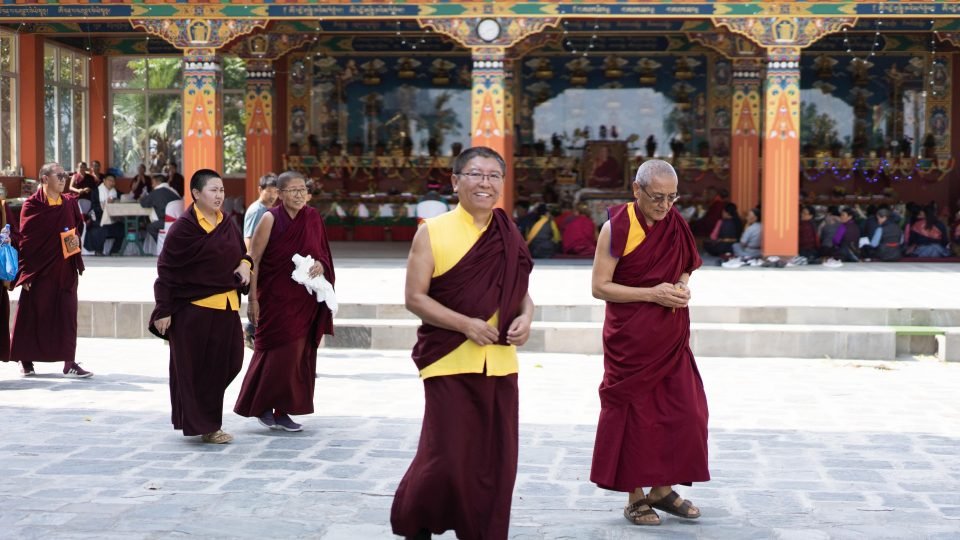
Tsoknyi Rinpoche with Khen Rinpoche Geshe Chonyi, Kopan Monastery, May 10, 2023. Photo by Ven. Lobsang Sherab.
It’s impossible to list here all the visitors high and low, famous and unknown, realized and devoted, local and from distant lands, who have come to visit Rinpoche over the past month, pay respects and offer support to the sangha. And it’s impossible to express enough gratitude.
These next three weeks will see an increased influx of visitors to Kopan as students arrive from around the world to pay respects to Rinpoche before traveling to Dharamsala to offer the long life puja to His Holiness Dalai Lama on May 24. This long life puja was Rinpoche’s holy wish and we can fulfil it. After that, the final days of May will see the culmination of the 49 days of pujas and prayers made with strong longing for Rinpoche to swiftly return.
At this time of heightened awareness of impermanence, Khadro-la advised us from the beginning to focus on bodhicitta, to pray to the Guru and to commit ourselves to fulfilling Rinpoche’s holy wishes. As the lamas are showing us—this is a time to honor Rinpoche’s inexpressible qualities and to support each other with kindness.
May 15, 2023: Serving Sentient Beings Is Serving Rinpoche
It’s Saturday night up at Rinpoche’s apartment and there are 30 plus nuns, monks and lay people on the finishing stretches of a four-hour Vajrayogini self-initiation. Some of the participants come night after night without fail, others are visitors or come when they have time. Outside the sky is clear and the lights of Kathmandu Valley twinkle like earthly stars. Inside the little porch area at the back of the main room— where Rinpoche used to take meals, entertain guests and do prayers and pujas—are a few Western nuns seated around the mandala house. There is no more space in the room where Rinpoche’s holy body is located, numbers have to be restricted due to the limited space—but somehow everyone gets accommodated. The wish to participate in these prayers at this special time in this special place is in everyone’s hearts.
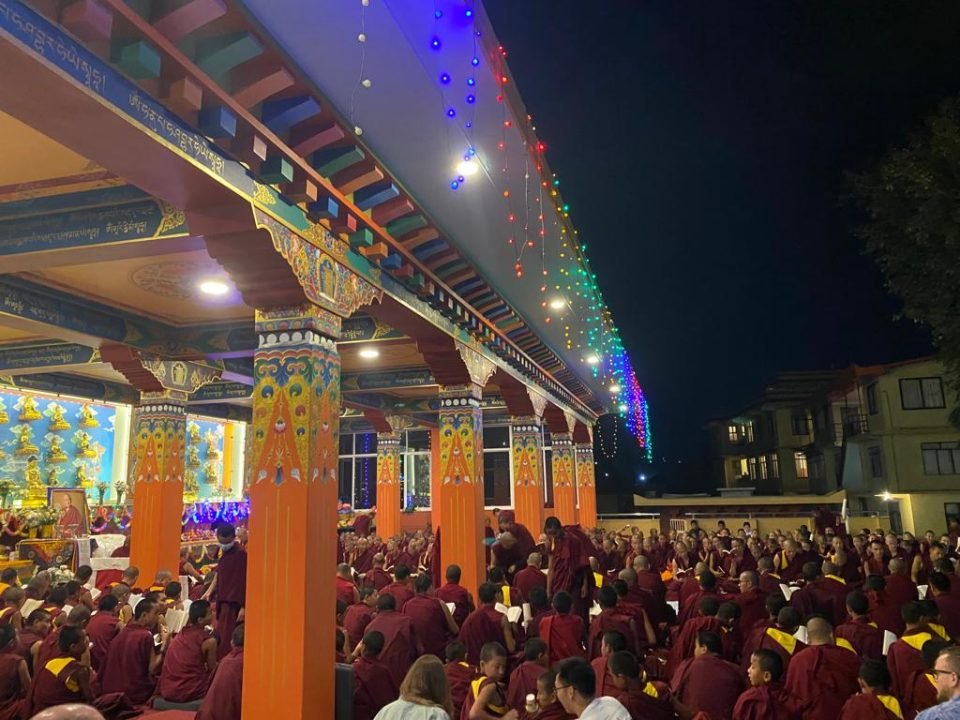
Prayers around the clock at Kopan Monastery for Lama Zopa Rinpoche’s swift return. Photo by Alison Murdoch.
It’s close to midnight when Rinpoche’s attendant comes with a tray to clear away our empty cups. About an hour earlier we were offered a selection of drinks, including a sweet and strong milky tea to keep us all awake, and an hour before that they served warm porridge. In between, money offerings were distributed to those doing prayers.
This is how it is up in Rinpoche’s apartment and how it has been 24 hours a day for the last 30 plus days. Pujas are scheduled continually thoughout the day and night, with short breaks for vacuuming, cleaning up and tending to the offerings, and longer breaks every few days to change the salt or rearrange furnishings. It hasn’t stopped. Hundreds of monks and nuns do prayers and pujas and self-initiations at Rinpoche’s holy body from dawn to dusk and dusk to dawn, usually joined by lay disciples who are resident at Kopan or visiting for the day. Sometimes there are several pujas going on at the same time when high lamas or visiting sangha from other temples gather for prayers in Rinpoche’s living room—the VIP space—whilst the regular schedule continues next door. And all the time a stream of visitors pass through the sacred space to circumambulate Rinpoche’s holy body in its magnificent mandala house, touch their heads to his throne, offer a khata and maybe an envelope, fruit, food, flowers or other gifts, and then file back out again collecting a packet of the salt that has touched Rinpoche’s holy body during the embalming process, some blessed torma and their choice of photo of Rinpoche on the way as holy souvenirs. Nobody leaves empty handed.
All these visitors are offered drinks and snacks by the helper nuns downstairs in the debate courtyard as they arrive. And all the participants at the pujas upstairs are offered a variety of drinks depending on the time of day—hot or cold water, sweet or butter tea, juice—along with snacks and money offerings. It’s an enormous amount of work, requiring nonstop coordination and well-calculated logistics.
Rinpoche’s small kitchen—originally built to cater for Rinpoche, a small entourage and guests—has now been transformed to cope with the huge influx of sentient beings that need to be continuously catered for; and the recently constructed lift up to Rinpoche’s room is now transporting visitors unable to manage the stairs and an endless supply of provisions for the visitors.
I ask the young monk on the night shift at Rinpoche’s apartment how many people pass through daily to pay respects to Rinpoche and he tells me that things have calmed down now to around 50/60 but in the early days it was hundreds and thousands each day for days at a time. Like all mature Kopan monks and nuns he has been offering service since the beginning in addition to his normal schedule of study. He’s enrolled at the Kopan tantric college and not yet 20, but I can see from his appearance that he is kind, patient, responsible and a good human being. He also speaks English well.
This is how it has been at Kopan since Rinpoche went into meditation. So much work, so many things to to be done, so much to be organized. Rinpoche has kept everyone busy with very little time to pause and be sad. There were pujas to be done, high lamas and visitors to be cared for, guests arriving and also a long life puja to be organized for His Holiness the Dalai Lama—in itself an enormous undertaking! Can you imagine?
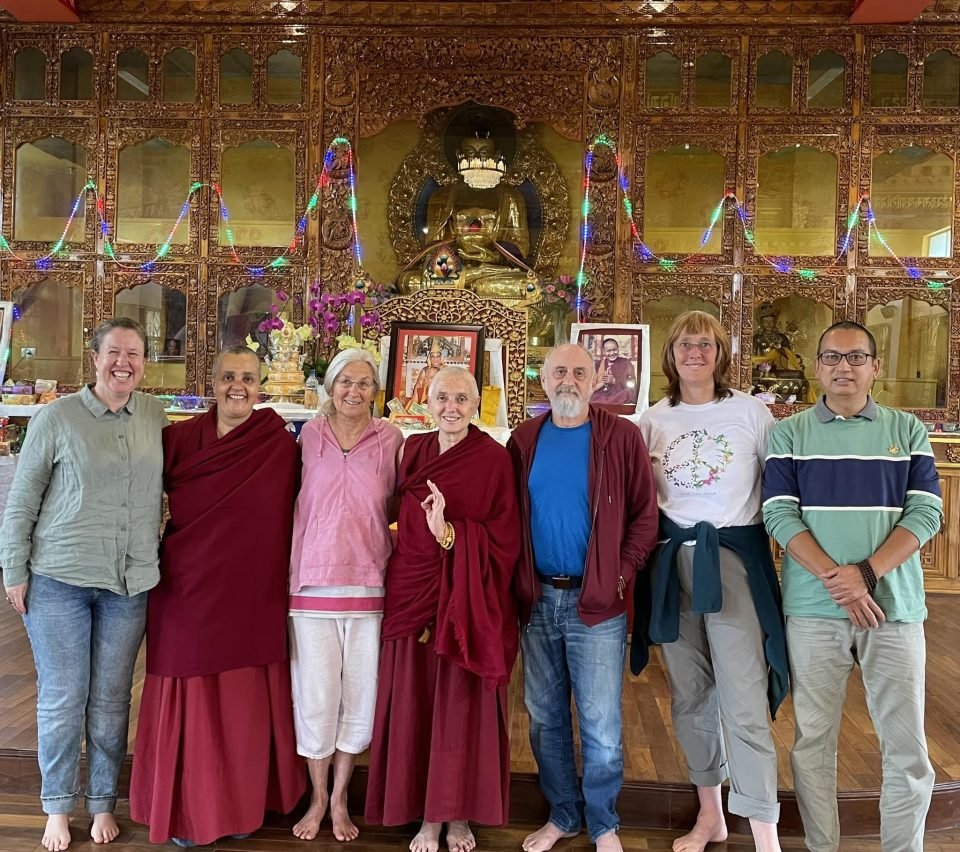
Lisa Gray, Ven. Namdrol, Paula Chichester, Ven. Sarah Thresher, Nick Ribush, Alison Murdoch, Sushil Grg; Dharma friends following prayers for Lama Zopa Rinpoche’s swift return, May 18, 2023. Photo courtesy of Ven. Sarah Thresher.
Pujas require drinks, food for the participants, torma, offerings, monetary distributions (which means piles of cash notes in Nepal!), texts and on and on. Truckloads of supplies have wound their way up the Kopan road every day and, during the most intense period, a caterer had to be brought in to provide the meals. Every visitor must be cared for. It was not just the Kopan monks and nuns doing prayers, but also sangha and lay people from all over the valley, all over Nepal, India and the world—as overseas visitors flew in from South East Asia, Mongolia, Australia, New Zealand, the Americas, and Europe.
It’s now past midnight and the Vajrayogini puja has come to a close. Outside, a group of young monks is waiting patiently for us to leave so they can begin their two-hour prayer session. Everything is well timed. Before they can enter the room it must be cleaned again and I watch as another of Rinpoche’s attendants vacuums up and down for the umpteenth time today to prepare it. Nearly 12 hours earlier I saw the same attendant at the Chenrezig puja—chanting, offering tsog, showing visitors around the mandala house and directing them take packs of holy salt and a photo as they left the room.
Watching all of this unfold over the past days and weeks, I’m reminded how Rinpoche would always teach that serving sentient beings is the best offering to all the Buddhas. All this service, all this devotion, all this sacrifice—I think Rinpoche would be very happy with how his monks and nuns have stepped up and taken responsibility. Yes there is sorrow and heart-break, yes there are times when the emotions are overwhelming and tears flow, but the work has to continue. That is what Rinpoche would want. And as we pray for Rinpoche to return, serving others is how we embody his teachings and keep them alive.
Ven. Sarah Thresher is an English nun who graduated in 1982 and met the Dharma in Kopan shortly afterwards—taking refuge with Lama Thubten Yeshe. She worked many years as an editor for Wisdom Publications and Lama Yeshe Wisdom Archive and has also taught at centers around the world. She ordained with His Holiness Dalai Lama in 1986. For the past five years she has been living in different locations in Nepal.
- Tagged: kopan monastery, ven. sarah thresher
8
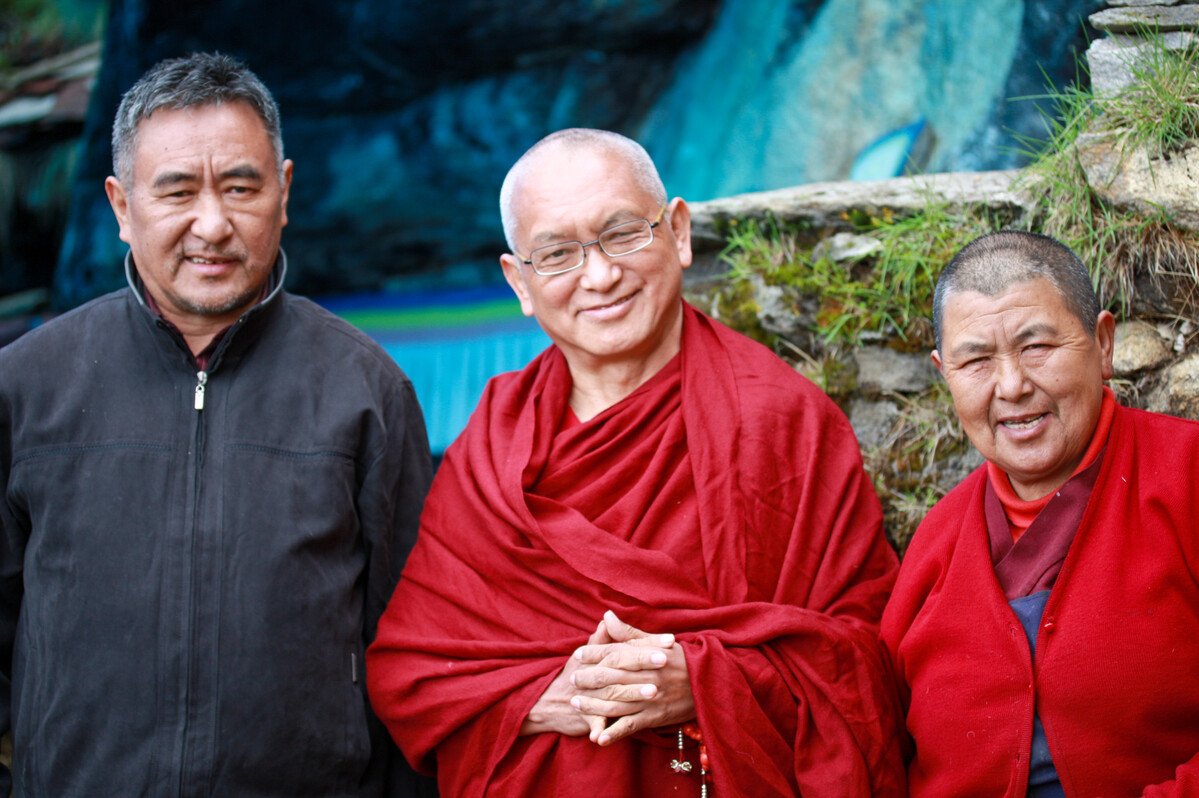
Lama Zopa Rinpoche with brother Sangye Sherpa (left), and sister Ani Ngawang Samten (right), Lawudo, Nepal, June 2008. Photo by Ven. Thubten Kunsang.
This letter below by Frances Howland was originally published in the Love Lawudo Newsletter #14, November 2022. It celebrates the service of Sangye Sherpa, the brother of Lama Zopa Rinpoche, and the development of the Lawudo Gompa and Retreat Center during his time as director. Lawudo is a small and remote village in Nepal, and was the home of the Lawudo Lama, a hermetic yogi who spent most of his life in retreat in a cave above the village. Lama Zopa Rinpoche was recognized as the reincarnation of the Lawudo Lama, so the village holds a special connection with the FPMT organization.
By Frances Howland
Sangye is the younger brother of Kyabje Lama Zopa Rinpoche and his sister Ven. Ngawang Samten. He was born in 1948 in the village of Thame in Solu Khumbu, one month after their father died. They were a poor Sherpa family, and the early years were filled with many hardships due to their father’s untimely death.
In 2008 Lama Zopa Rinpoche requested Sangye to become the director of Lawudo Retreat Centre and for the next 13 years he worked hard raising money and maintaining and developing Lawudo Retreat Centre in accordance with the wishes of Lama Zopa Rinpoche.
The immediate advice from Rinpoche was to tear down the old monastery and build a new, larger gompa that could accommodate 500 monks. Built in 1968 it was in an extremely poor condition and at risk of collapse at any time. The building was sinking into the ground, the front pillars were crooked, and the walls were visibly leaning outwards. However, the senior Lama from Thame monastery, Lama Zopa’s uncle Ashang Yonden, and other Lamas recommended that the old gompa should be preserved as a pilgrimage site because Lama Zopa and Lama Yeshe themselves had supervised and planned the construction and carried some of the stones used in the building. Following this input, Sangye decided to reinforce the foundations with concrete while adding concrete beams and pillars in strategic places, while keeping the original building.
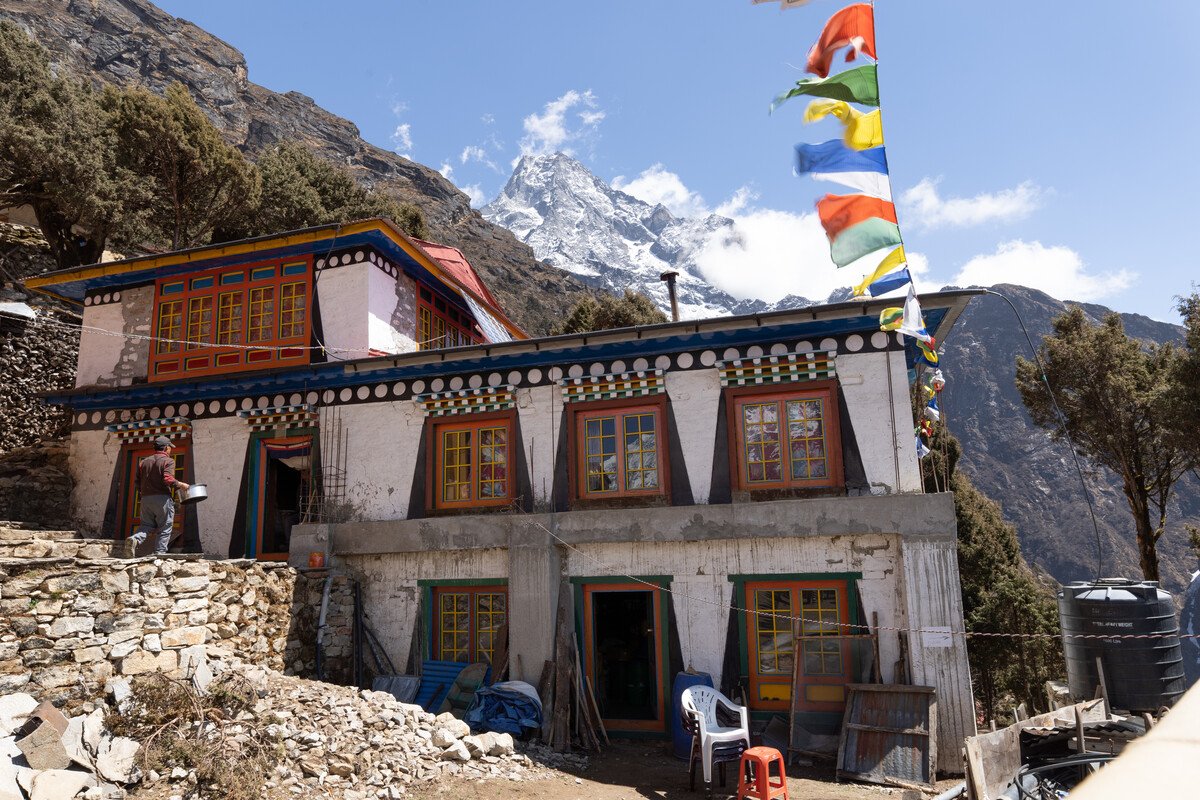
Lawudo Gompa, Nepal, April 2019. Photo by Harald Weichhart.
The difficulties of building in the Khumbu region cannot be stressed enough. In 1976 the Khumbu region became the Sagarmatha National Park and was declared a World Heritage Site. Everything must be carried or flown into the area. Even wood used for building cannot be cut from local trees. Sangye had to organize cargo helicopters to carry all the materials he used for all the projects he undertook. This also increased the cost substantially with each helicopter costing around 3,000 US dollars plus the porter charges to carry the goods from the Syangboche airstrip to Lawudo. Despite these challenges, new guest rooms, a new kitchen, major renovations and extensions to the existing buildings plus the construction of a library with a balcony overlooking the valley were all completed. The logistics of all of these projects are mind-boggling.
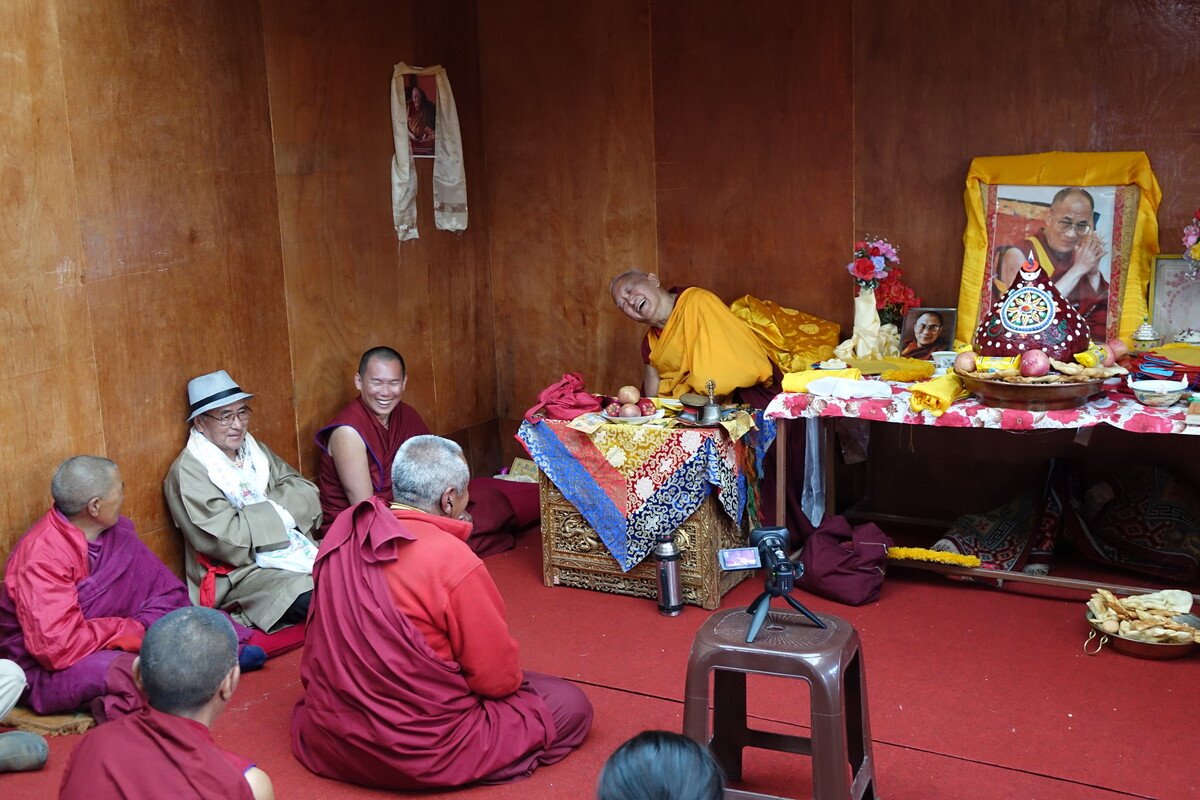
Lama Zopa Rinpoche at Lawudo Retreat Center, with sangha and his brother Sangye Sherpa (with hat), Lawudo, Nepal, April 2015. Photo by Ven. Roger Kunsang.
In late March 2015 a group of us accompanied Rinpoche to Lawudo. Sangye and Ven. Ngawang Samten hosted everyone and there was a big opening ceremony for the new library building, with a procession of monks from a nearby monastery. On April 25th, Lama Zopa Rinpoche had just left Lawudo to return to Kathmandu when a major earthquake measuring 7.6 shook Nepal. No one in Lawudo or the surrounding villages died but most buildings and many stupas on the trails were damaged. At Lawudo the impact was severe. There were cracks in the gompa, the dining room roof fell down, the toilets collapsed, the stone walls of every building cracked open, and the new library where we had just had the opening ceremony was cracked with many stones fallen. Sangye immediately organized an Earthquake Relief for Damage at Lawudo to help fund the repairs.
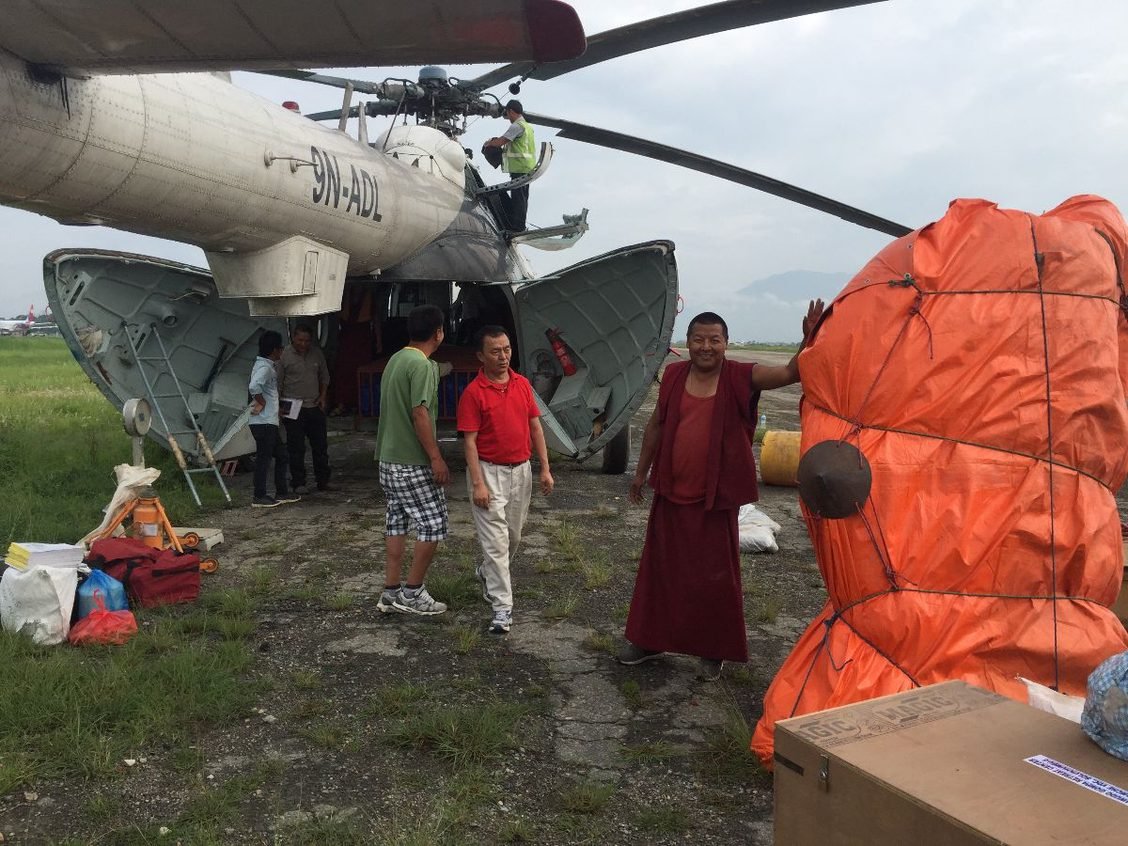
The 22-foot statue of Padmasambhava arriving to Lawudo by helicopter, with Ven. Tashi Nyima, pictured.
Another task that Lama Zopa gave his brother was to install a 22 feet-high Padmasambhava statue in the gompa at Lawudo. In the standing aspect of Sampa Lhundrup, it was to face eastwards and be surrounded by seven life sized manifestations, all cast in copper with gold finishing. Sangye commissioned the statues from the skilled Sakya artisans of Patan down in the Kathmandu valley. On 27 June 2016 the statues were helicoptered into Mende, the hamlet closest to Lawudo. 35 Sherpas were needed simply to carry the main statue up the steep mountainside to Lawudo.
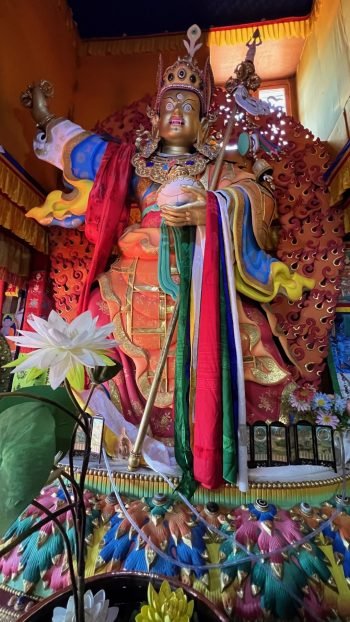
The 22-foot statue of Padmasambhava residing in Lawudo Gompa.
In May 2021 a pilgrimage to Lawudo was organized for Lama Zopa and a group of students. Sangye and Ven. Nyima Tashi spent months in Lawudo making sure all the building work was completed and the statues were ready to be consecrated. By then the COVID pandemic was in its second year, and by May the Delta variant was claiming lives in Nepal and India. Once again Nepal went into a total lockdown and the visit to Lawudo was cancelled. Nevertheless Sangye and his team continued undaunted with their extensive program of repairs and upgrades. These included introducing a damp course for the Lawudo cave, building a support wall behind the monastery building, and installing safer steps and walkways for the increasingly elderly Lawudo family.
Another extraordinary achievement from Sangye’s time as Lawudo director was to bring fresh running water to Lawudo and 38 other households in the valley. Anyone who has been to Lawudo will know what an extraordinary feat of engineering would be necessary for such a project. The water is piped at 1.7 litres per second from a height of 4500m through a pipe clamped to the vertical rock faces above. The pipeline was inaugurated in November 2019 and is making an incalculable contribution to the health and well-being of the local population and its livestock. The budget was millions of rupees, much of which was fundraised by Sangye.
Before dedicating his time to Lawudo, Sangye was a successful businessman, and was also involved in the trekking and tourism business. He lives in Chabhil not far from the Boudha stupa with his wife Nyima, his airline pilot son Pemba, and his daughter-in-law Sarita Chhetri and two grandchildren. His other three children are married and live in the UK and US.
Please join us in rejoicing at the amazing contribution that Sangye has made to fulfilling Lama Zopa Rinpoche’s vision for Lawudo, and in making prayers for his health and long life.
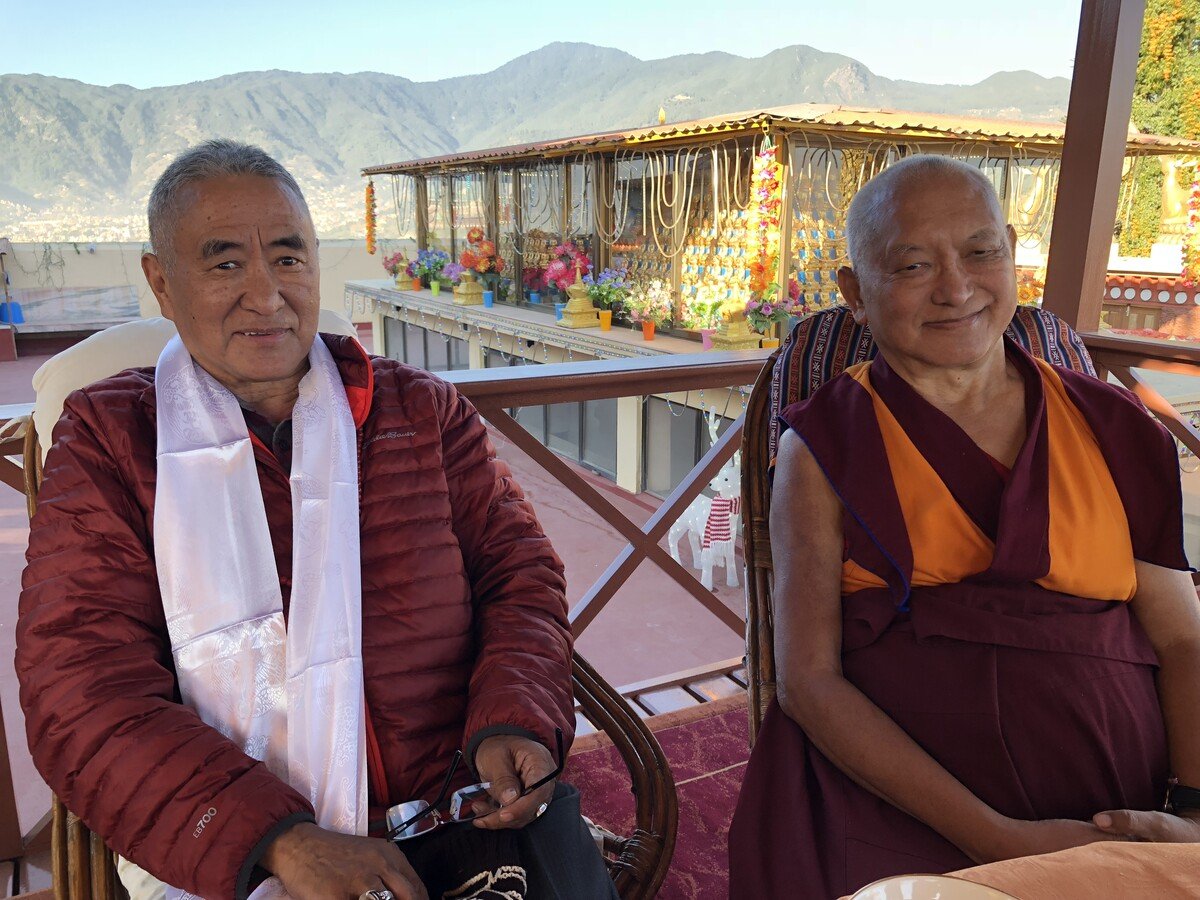
Lama Zopa Rinpoche with his brother, Sangye Sherpa, Kopan Monastery, Nepal, 2017. Photo by Ven. Roger Kunsang.
- Tagged: lawudo, lawudo retreat centre
1
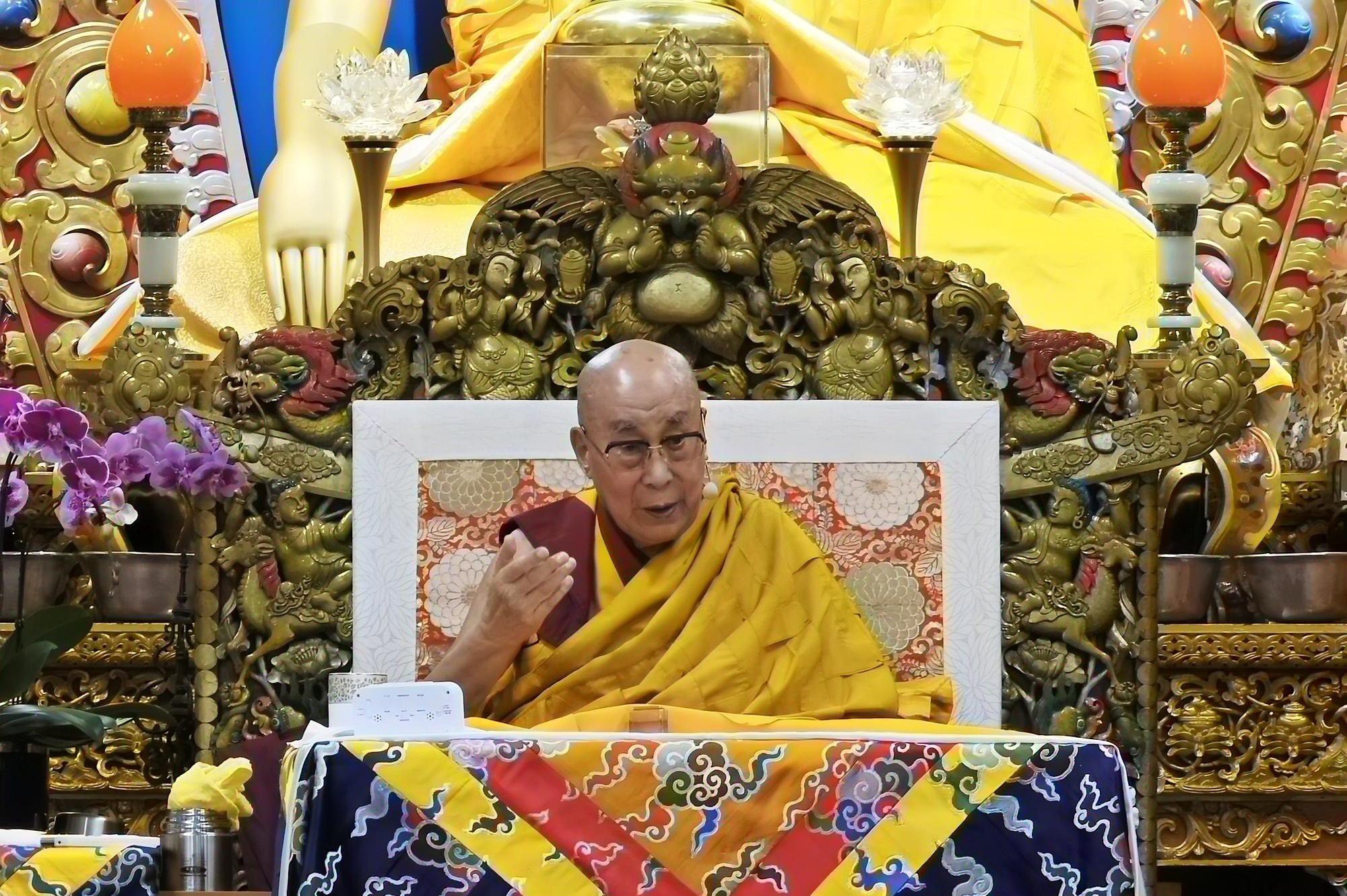
His Holiness the Dalai Lama giving public teachings in person, McCleod Ganj, H.P., India, September 2022. Photo by Jean-Luc Castagner.
Buddhist students around the world have learned to appreciate technology and the blessings of Zoom since the Covid-19 pandemic halted travel and large events or gatherings for most of us for nearly three years. In September, His Holiness the Dalai Lama offered an in-person teaching in McLeod Ganj, Dharamsala, at his monastery, Namgyal Monastery.
We are so happy to share two moving reports of these teachings – one from long-time French student Jean-Luc Castagner, who was able to speak to other students from around the world about their experience with His Holiness’s teachings, and one from Ven. Tenzin Tsultrim, on behalf of a group from Amitabha Buddhist Centre, Singapore, who attended these teachings together.
Return to McLeod: His Holiness the Dalai Lama’s Teachings in a Post-COVID World
By Jean-Luc Castagner
His Holiness the Fourteenth Dalai Lama has been giving public teachings for decades in the little town of McLeod Ganj above Dharamsala (Himachal Pradesh, India), and the flow of Injis (English speakers/Westerners, in Tibetan) that marks the streets here is a constant indicator of the importance and relevance that His Holiness’s message is always touching a wide audience.
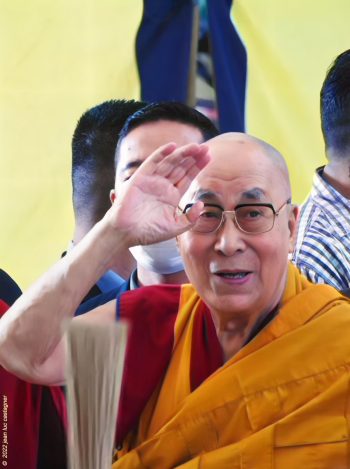
His Holiness the Dalai Lama, September 2022. Photo by Jean-Luc Castagner.
The pandemic that has put these public teachings on hold is now almost behind us and we are now able to attend in person and be in the presence of His Holiness again. In the mornings of September 15 and 16, 2022, His Holiness gave a two-day teaching on Chandrakirti’s Entering the Middle Way, a prominent text written as a commentary to Nagarjuna’s Mūlamadhyamakakārikā (The Fundamental Verses on the Middle Way). It clarifies Nagarjuna’s Middle Way approach with respect to the lack of intrinsic existence as propounded by the Madhyamika Prasangika school of thought. The auto-commentary was further written to clarify its meaning for Chandrakirti’s students. His Holiness has given similar teachings on these texts many times in the past.
Two and a half years have passed since my return to McLeod Ganj. March 21, 2020 was my last day there. That morning, all the students of the Lotsawa Rinchen Zangpo Translation Program (LRZTP), of which I was a part, formally graduated. I remember that time very clearly because of the commotion that the newly emerging virus, now famously known as Covid-19, was causing havoc all over the planet, and the prospect of being stuck in India for a long period of time, in probably dire circumstances, was daunting to me and many other people. My friend and classmate, Lola, and I decided to travel back to France together quickly, after experiencing a few plane cancellations and delays. It turns out that we were on one of the last planes that were allowed to leave India on the morning of March 22, as all of Indian air travel was to be shut down at 6 am on that day. A handful of my classmates had decided to stay in India, thinking that this situation would not last long, that it too would come to pass. Little did they know about the dreadful duration of the restrictions they would be submitted to during the lockdown, but somehow most of them experienced it with a happy mind and made the most out of it. Had it not been for the then-unknown health troubles that my late father was in a year later, I think retrospectively it might have been better to stay there and continue improving my Tibetan skills, which during the next two years in France took a hard hit.
Indeed, Covid-19 has had a tremendous impact on our lives. However, for those lucky ones like myself who could stay in the countryside during the various lockdowns, it was a very pleasant experience. For others less fortunate, the restrictions impacted not only their physical health but also their mental health.
During the two years of the LRZTP, one of the perks of staying in McLeod Ganj was of course to be able to attend His Holiness’ teachings, during which he put more and more emphasis on climate change and how the Buddhist view articulates the interdependent nature of our existence at a personal, individual level, but also on a global, world scale. This has now become a global phenomenon and will hopefully create some sense of urgency, but the notion of interdependence and responsibility, fused within the framework of a compassionate view of our world, is now needed more than ever.
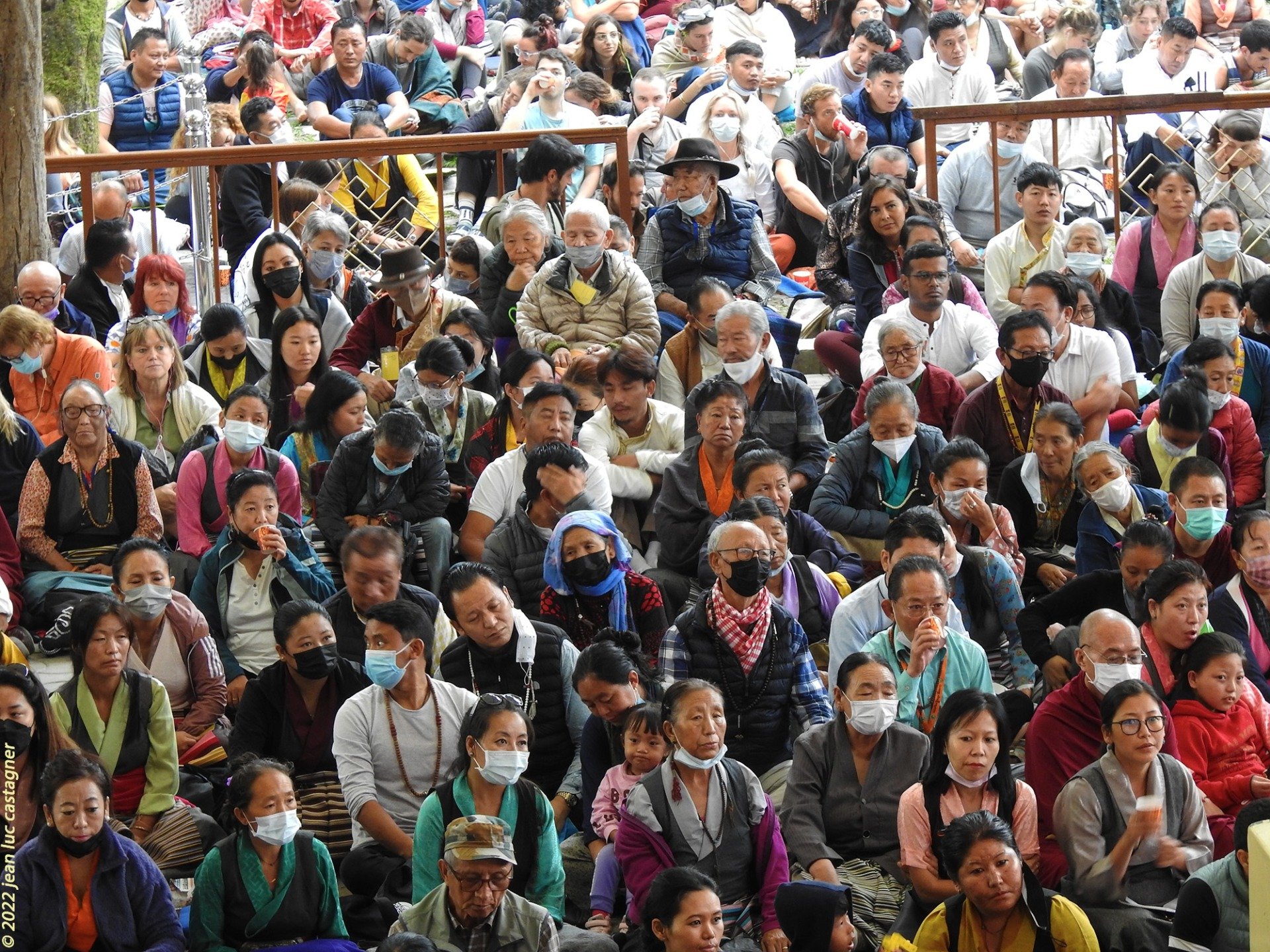
Attendees of His Holiness the Dalai Lama’s teaching, McCleod Ganj, H.P. India, September 2022. Photo by Jean-Luc Castagner.
These teachings were requested by a group of Southeast Asians and the majority of the foreign participants who attended were from Vietnam, Singapore, Taiwan, and China. However, this time there seemed to be less Westerners, as the space on the ground floor outside had plenty of room left for sitting. This was contrasted with the June 2022 teachings for which the doors were shut by 7a.m. as it had very quickly reached full capacity.
For those who had attended the teachings in previous years, not much change is actually visible. Externally of course some improvements have been added in the temple, such as the new elevators that allow His Holiness to access the teaching hall. The video cameras used to stream the teachings are increasing in number it seems, with even a wireless feed that follows His Holiness closely as he slowly makes his way to the temple from his residence.
Mimi is a young teacher from Singapore, who came here to be able to learn and develop insights about herself and others, and also to be as close to His Holiness as possible. The profound impact that these teachings had on her, in her own words, “Really, it’s all about being loving and affectionate. That was mainly something that encouraged me, to be fearless in overcoming selfish delusions and have courage in the heart. Any negative situation is an opportunity to practice more love and affection toward my mind and others, and see the transformation from within. The study of emptiness is to really be able to investigate over and over the cause and effect of an object you have been obsessing about, and then to be disciplined in the mind, to be able to bring reasoning, and not conclude simply.”
Dharma can be understood at many levels and used unconditionally in various areas of our lives. Whether we are full-time at work, have the leisure to travel the world, supporting our family, or living a celibate life; the teachings apply to all situations, because we experience it all with our mind. Alessia, a Russian girl from Moscow who has been studying Tibetan and Buddhist philosophy at the Library of Tibetan Works and Archives for five months now, said, “The most important is what is in my mind, if I have bad things from which I suffer, I have to work with myself. So it is not outside of me, it’s only my mind. This is the most important part.”
Change is also an inevitable part of our existence. Personally, my first visit to McLeod Ganj was in 2007, and for sure it was different than now, the number of hotels was considerably lower, eating out was restricted to a few good options, and the garbage situation was very difficult. Since then, McLeod Ganj has banned plastic bags, and there are now a few locations where waste can be left to be disposed of. Compared to then, the town is much cleaner, and the variety of dining options (Tibetan, Indian, Japanese, Italian, Korean, etc.) reflects well its cosmopolitan atmosphere. As a French person, I especially appreciate the famous cakes that made the reputation of a few places such as Coffee Talk near the temple.
For some like Dimitri, who has been living in McLeod Ganj for 10 years now, his take on the evolution of McLeod Ganj is double-sided, “It became more comfortable to live here, I know from before. If you want to study it’s good, but if you want to do practice or meditation, the atmosphere has changed for the worse, because there are a lot of tourists coming, a lot of distractions. Before it looked like a monk’s village, with monks doing prayers and reciting mantras, but now it’s a tourist place and the atmosphere is different. If I want to do meditation or go deeper into my practice, I move from here for a short time and I come back. But before it was not like this”
While staying in McLeod Ganj during the two years of the LRZTP, I remember noticing that the Tibetan community here had become very proactive with various environmental projects and regular demonstrations. If one reflects on the current state of our planet, it appears that mundane interdependence is not even valued nor considered at government levels. His Holiness’s timeless approach of the Buddha’s teachings manages to integrate and support the various issues that affect us all, such as how to deal with anger, stress, climate change, war, and epidemics within our minds. It is our duty as responsible Buddhists, who, like all sentient beings, do not wish to suffer and only wish for happiness, to uphold his message and advice and implement it in our daily lives to the best of our abilities. It is such a precious opportunity to attend these teachings and to see His Holiness directly. If you have the resources and time to visit McLeod Ganj, this will be very worthwhile. But be mindful as the cakes here are atrociously delicious.
Jean-Luc has been a student of Lama Zopa Rinpoche since 1998 and has been volunteering in various FPMT centers over the years, particularly in Institut Vajra Yogini and Nalanda Monastery near Toulouse, France. He recently graduated from the Lotsawa Rinchen Zangpo Translator Program in Dharamsala and is now pursuing his study of the Tibetan language in Nepal.
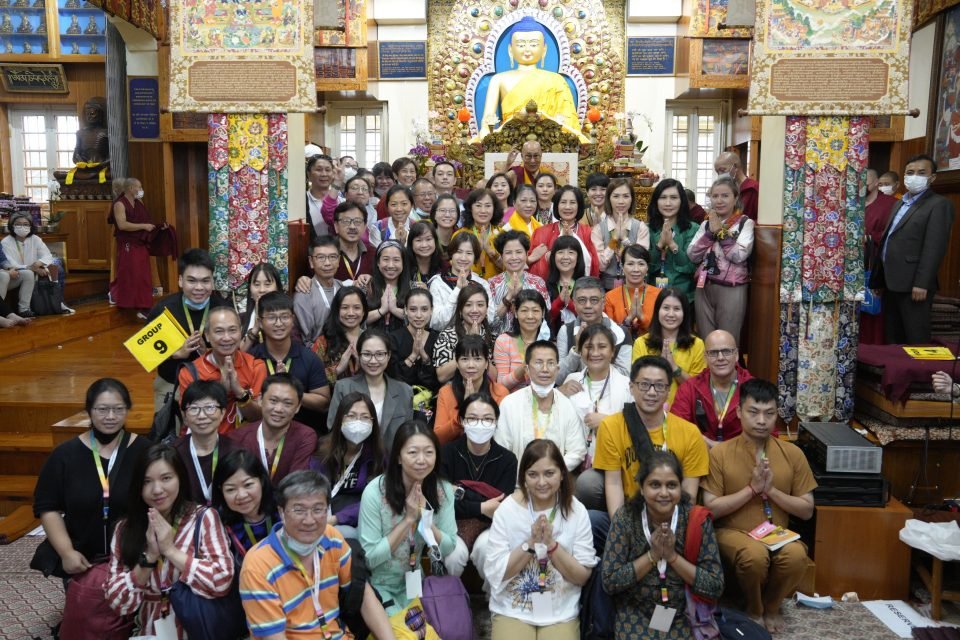
Southeast Asian group with His Holiness the Dalai Lama, September 2022. Photo courtesy of the Office of His Holiness the Dalai Lama.
Amitabha Buddhist Centre Students from Singapore Attend His Holiness’s Teachings
By Ven. Tenzin Tsultrim
An air of enthusiasm and excitement accompanied 33 of us on our Amitabha Buddhist Centre (ABC) tour to attend His Holiness the Dalai Lama’s teachings for Southeast Asian students in Dharamsala, India. Our week-long trip from September 11-19 was joyfully welcomed by all. In the interim, we had been thankful to be able to receive His Holiness’s precious teachings online and even through Zoom. However, nothing could compare to sitting in the gompa of Namgyal Monastery itself as His Holiness continued teaching from where he had left off previously in Chandrakirti’s Entering the Middle Way.
The majority of the ABC travel group are very new to the Dharma and to ABC, or are engaged with other traditions such as the Chinese Mahayana tradition or another religion. However, the rare opportunity to be able to actually see His Holiness in person was what drew many of them to sign up with our tour. We also welcomed back a father and son duo who were ABC members from 30 years ago!
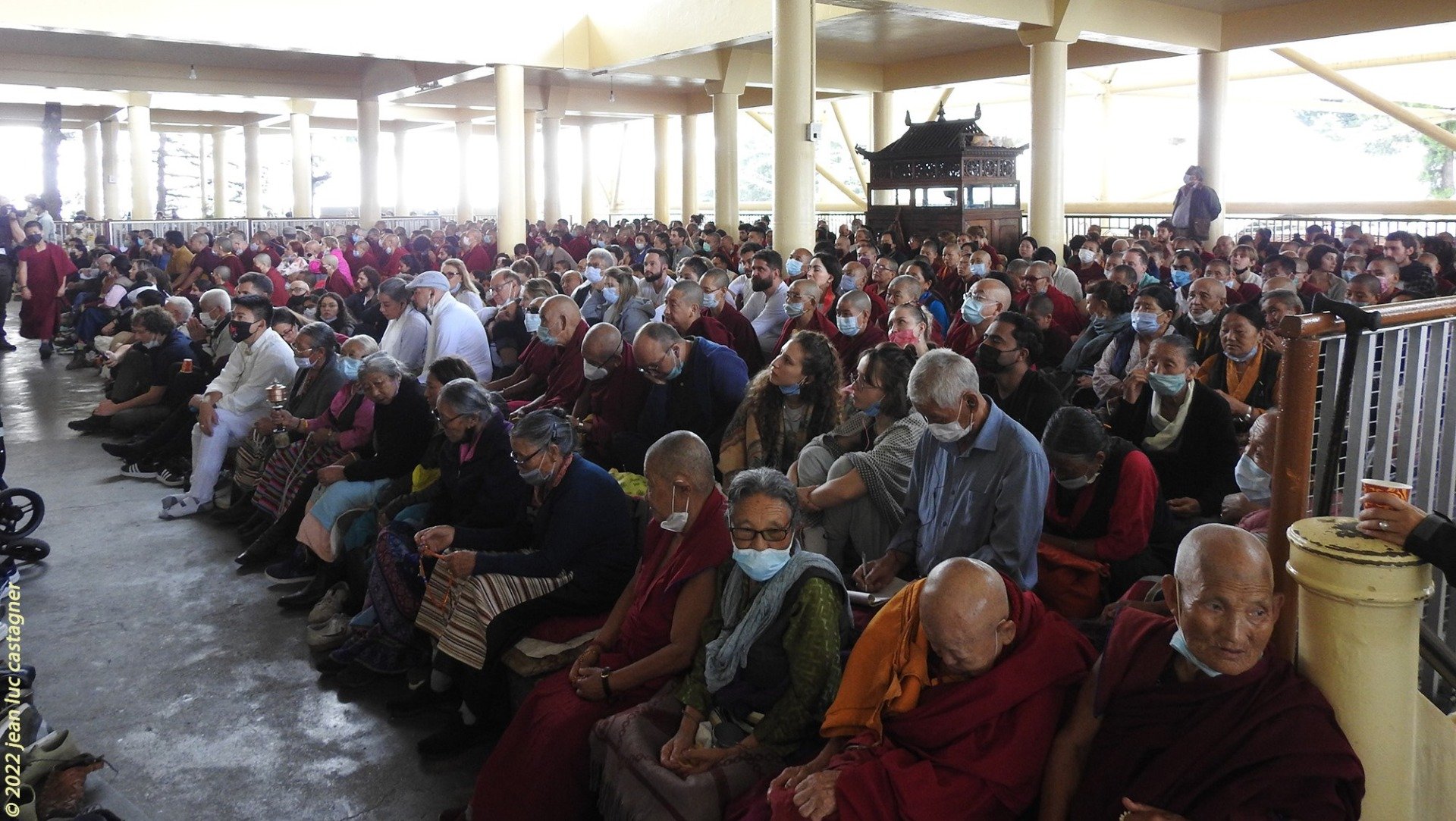
Some of the attendees for His Holiness the Dalai Lama’s teaching, McCleod Ganj, H.P. India, September 2022. Photo by Jean Luc Castagner.
Besides attending the two-day teachings at the main temple, our group had the opportunity for a pilgrimage to Tso Pema at Rewalsar, the sacred lake where Guru Rinpoche, Padmasambhava, is said to have been miraculously born from a lotus. The full-day road trip included visits to three holy caves where Guru Rinpoche had meditated. These included a cave where Guru Rinpoche had planted his footprint. We also sat in the first cave to meditate on Guru Rinpoche, recite the Sampa Nyurdrupma prayers, the mantra of Guru Rinpoche, and dedicate strongly for the peace and happiness of all beings in the world in these troubled times. One of the first-timers later shared that the experience of being able to do these prayers was very meaningful and special to her as she had never performed such prayers before. She was very grateful to be guided in this practice, saying that it was a memorable experience for her.
Another side tour for our group was a visit up to our sister center, Tushita Meditation Centre. Everyone showed themselves to be very good sports in taking the steep hike up the walking trail to Tushita – albiet puffing and panting here and there, but everyone made it! We were warmly welcomed by Tushita Centre’s Spiritual Program Coordinator, Ven. Kunphen. After a comprehensive briefing and tour of Tushita’s holy objects provided by Ven. Kunphen and her assistants, we were treated to a generous and sumptuous buffet that included momos, a variety of cakes and steaming cups of chai.
Other highlights for our participants included an audience with His Eminence Yongzin Ling Rinpoche, observing a post-teaching fire puja at Namgyal Monastery, and a visit to Gyuto Tantric Monastery and Norbulingka. Many also got to view the holy relics of the previous incarnation of Ling Rinpoche in a museum inside His Holiness’s private residence. To celebrate the end of our visit, we all sat down to a dinner together at the newly-refurbished Pema Thang Guesthouse restaurant.
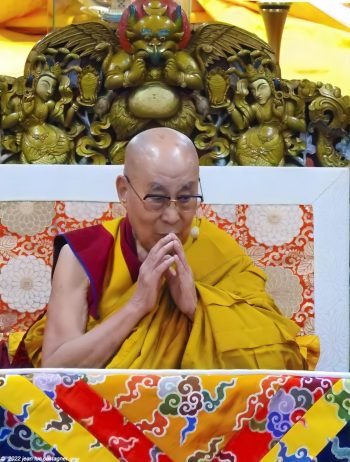
His Holiness giving teachings, McLeod Ganj, H.P., India, September 2022. Photo by Jean-Luc Castagner.
Very positive comments and feedback were heard all round, and there were many happy, beaming faces. One participant who was on her first visit to Dharamsala rated her experience as “5-star” and “A-plus!” It is remarkable that impermanence and our past accumulation of merit brought us over to Dharamsala and back, safe, sound, and filled with special memories and countless blessings. We look forward to receiving the next round of His Holiness’s teachings, so kindly and efficiently organized by Tibetan Buddhist Centre, Singapore.
Camaraderie, open-mindedness, warmth and understanding accompanied us throughout our nine-day tour. Besides the coordination efforts supplied by Executive Committee member Vincent Koh, Sangye Quek and myself, several of our group, older and newer members alike, stepped up readily to help where needed. Everyone contributed to making this a peaceful, happy journey!
Ven. Tenzin Tsultrim is regional representative for IMI Southeast Asia and a long-time member and student at Amitabha Buddhist Centre in Singapore.
To view the current teaching schedule of His Holiness, we invite you to please visit the official website of the Office of His Holiness the Dalai Lama. Most of His Holiness’s teachings offer a live webcast so please check the website regularly for opportunities.
His Holiness will give three days of teachings on the mornings of December 29-31 at the Kalachakra Teaching Ground, Bodhgaya. On December 29 and 30 His Holiness will give teachings on Nagarjuna’s Commentary on Bodhicitta (jangchup semdrel). On December 31 His Holiness will confer the Blessing of Twenty-one Taras (dolma 21 jenang). We look forward to sharing details about these precious teachings after the event.
- Tagged: dalai lama, his holiness the dalai lama
14
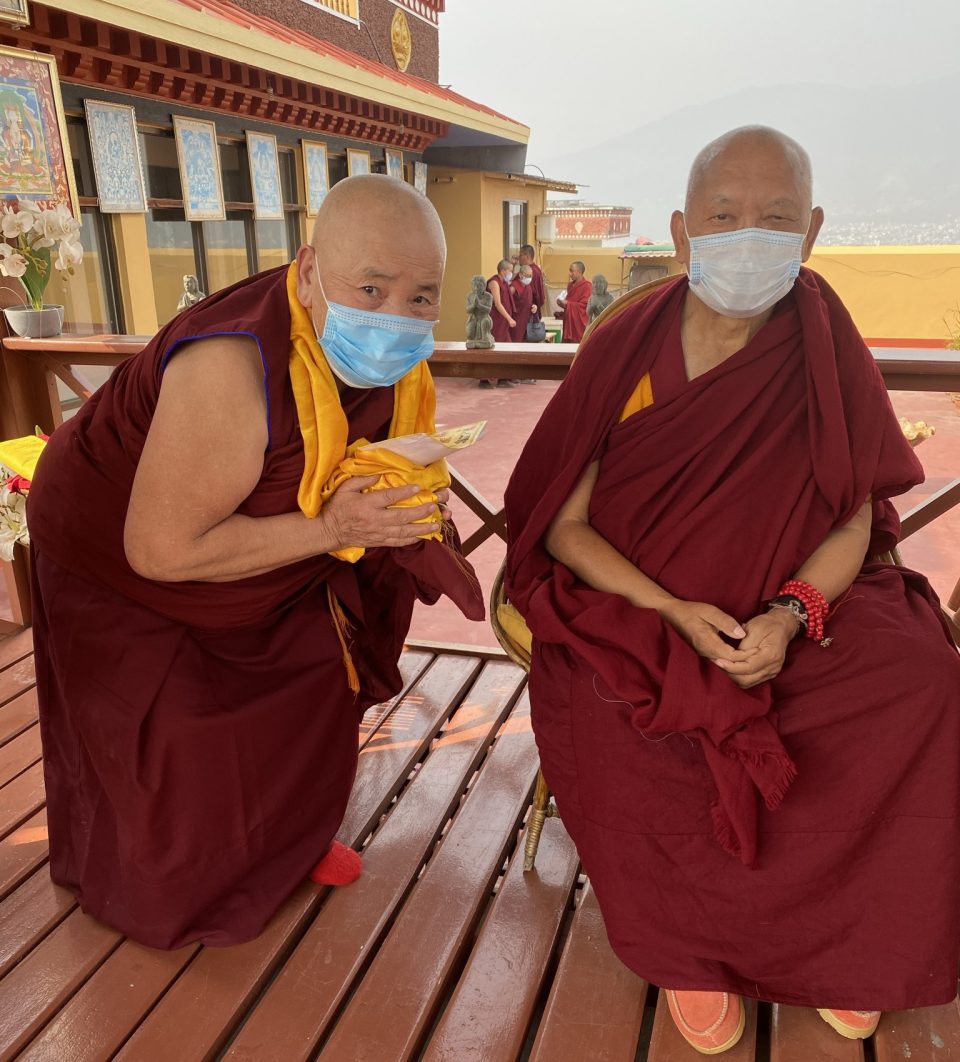
Lama Rinpoche with Ani Chodron at Kopan Nunnery, 2021. Photo by Ven. Roger Kunsang.
Venerable Ani Chodron was born in the year of the wood bird in 1945 in the village of Tsum near the border of Tibet in northeast Nepal. She is the oldest of four children, all daughters, born to Mingmar Tshok and Mingma Tsewang. Her parents were nomads and farmers, and her uncle Gelong Pasang Tsering was known as the chanting master of Mu-Gompa.
At the age of nine, Ani Chodron ordained at Ranchen Nunnery. She received from His Holiness the previous Chosang Rinpoche the great initiations of Avalokiteshvara, Yamantaka, and Vajrayogini. When her uncle retired from Mu-Gompa to enter retreat in a nearby cave, the senior monks and nuns chose Ani Chodron to be his assistant. There she performed one hundred thousand each of mandala offerings, prostrations, guru yoga recitations, and long mantras of Vajrasattva.
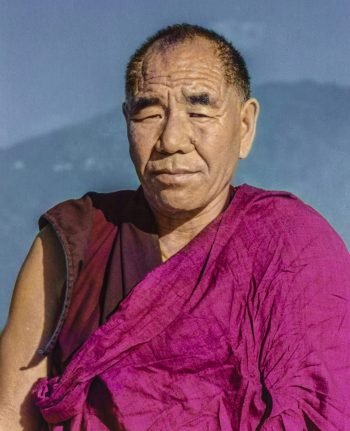
Geshe Lama Konchog at Kopan Monastery, 1985. Photo courtesy of Lama Yeshe Wisdom Archive.
In 1959, Geshe Lama Konchog escaped Tibet via a route revealed to him in a dream which led him across the border to the village of Tsum. After many years meditating in solitude in a cave of Milarepa, he settled in a cave about an hour outside of Tsum known as Gaden Gompa.
Ani Chodron remembers when she heard the great mahasiddha Geshe Lama Konchog had moved to a nearby cave. She joined her uncle, three nuns from Ranchen Nunnery, and seven monks from Mu-Gompa to pay their respects and request teachings. The group received from Geshe Lama Konchog profound instruction and were led in a great Vajrayogini retreat. Together they performed four hundred thousand mantra recitations.
When Ani Chodron’s mother died at the age of 39, she moved home to the village in Tsum to help her family. After some time, Geshe Lama Konchog paid the family a visit. He advised the family to arrange a marriage for Ani Chodron’s younger sister so that Ani Chodron could continue her retreat. The family agreed, and Geshe Lama Konchog chose a husband for Ani Chodron’s younger sister, Ami Bhuti. In 1975, in the village of Tsum, Ami Bhuti gave birth to Tenzin Zopa, now Geshe Tenzin Zopa, an FPMT teacher.
Ani Chodron’s first nyung na retreat was led by Geshe Lama Konchog. The intense purification practice is highly praised by Lama Zopa Rinpoche as a supreme method for transforming the mind. Nyung na involves fasting, meditation, prostrations, mantra recitations, and taking Mahayana precepts each day. In Geshe Lama Konchog’s commentary on nyung na he said, “You should work hard. I have already completed 2,000 sets of nyung na retreats.”
At times the conditions in the cave were so poor it tested Ani Chodron’s faith as to whether she would be able to complete the nyung na retreats. For many years, she would go down to the village to beg for tsampa, rice, fruit, or any food at all just to be able to survive the retreats in the cave. Whenever she questioned whether she had the strength to continue, she recalled Geshe Lama Konchog’s words in order to fortify her resolve. Incredibly, in the end, Ani Chodron was also able to complete 2,000 nyung na retreats.
Over the years, Geshe Lama Konchog became a beloved figure in Tsum village. Ani Chodron’s nephew spent so much time at Geshe Lama Konchog’s feet that as a little boy Tenzin Zopa assumed he was his grandfather. Geshe Lama Konchog taught the local ordained and lay community, and every year he would lead a nyung na retreat that included both villagers and Sangha.
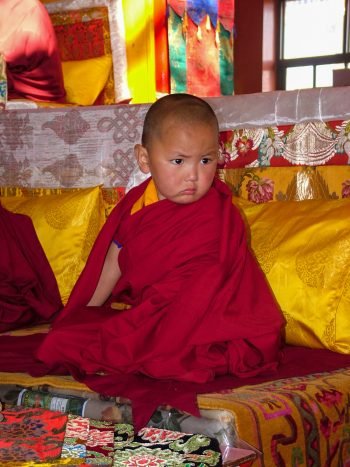
Tenzin Phuntsok Rinpoche, the recognized reincarnation of Geshe Lama Konchog. Nepal, 2006. Photo by Ven. Roger Kunsang.
Ani Chodron did retreats with Geshe Lama Konchog in the summer and traveled with him to India in the winter to attend teachings from His Holiness the Dalai Lama. The walk from Tsum to Kathmandu took sixteen days. In Kathmandu they stayed in Thamel at Katasyambu because they had no money. They would sell Tibetan incense and share what they collected. It took two days of walking non-stop day and night to reach the border of India. In India they received from His Holiness the Dalia Lama initiations for Kalachakra, Yamantaka, Avalokiteshvara, and Vajrayogini. His Holiness also gave teachings on the Bodhisattva’s Way of Life. Each time she returned to Tsum she continued to receive Dharma teachings at Gaden Gompa.
On October 15, 2001 the great mahasiddha Geshe Lama Konchog passed away at the age of 84. Ani Chodron’s nephew Tenzin Zopa had long-since been ordained as a monk and become a devoted disciple of Geshe Lama Konchog. He presided over the ceremonies and funeral for his precious guru at Kopan Monastery in Nepal.
In 2006, Ani Chodron came to Kopan Monastery to take care of Tenzin Phuntsok Rinpoche, the recognized reincarnation of Geshe Lama Konchog. She had no hesitation and only joy at being given the opportunity to serve because, as she explains, she understood the power of the opportunity provided for her to purify her negative karma and to accumulate merit. At Kopan, she received many Dharma teachings from Lama Zopa Rinpoche. Ani Chodron credits any progress in her practice and on her path to following the guidance of her holy gurus.
This remarkable nun has simple advice for her dear Dharma brothers and sisters, “I only have a humble request [for] you to follow wholeheartedly the advice of His Holiness the Dalai Lama and Guru Kyabje Lama Thubten Zopa Rinpoche.”
This article was written by Heather Melton Fox based on an interview with Ani Chodron. Thanks to Ngudrup Tsering for translation of this interview. Edited for publication by Carina Rumrill.
If you are inspired to support people undertaking retreats like what you have read about here, please consider offering to the Practice and Retreat Fund which provides grants and sponsorships to students engaged in retreats such as 108 nyung na retreats, 100 million mani retreats, recitations of sutras, and long-term retreat.
If you are interested in learning more about the practice of nyung na, you can find many resources in the Foundation Store.
- Tagged: ani chodron, geshe lama konchog, nyung nä, nyung na retreat, practice and retreat fund, tenzin phuntsok rinpoche
6
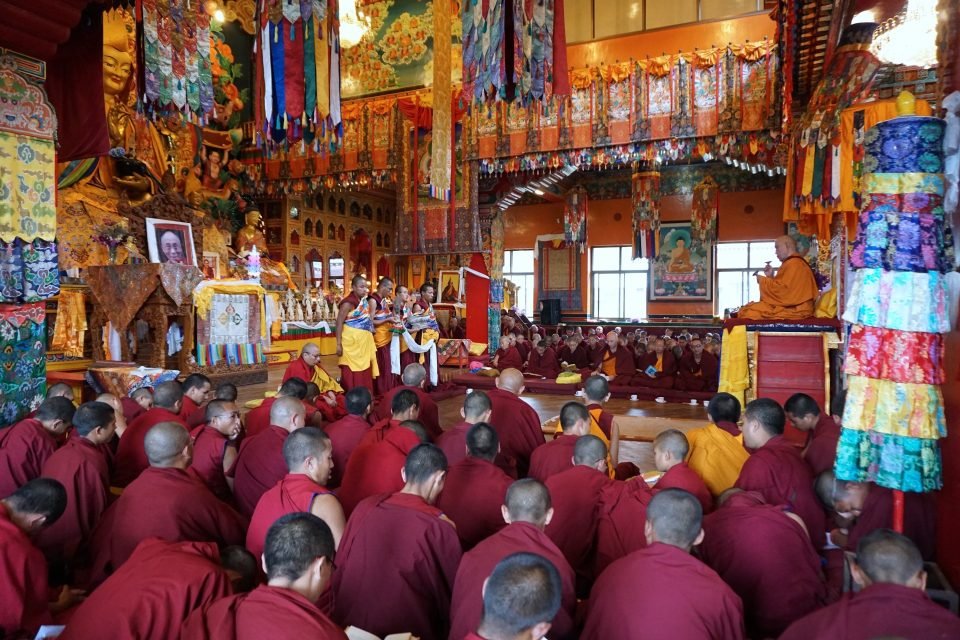
Jangtse Choje Rinpoche presiding over the Monlam prayer festival at Kopan Monastery, 2017. Photo by Ven. Lobsang Sherab.
Since 1998, the Gelug Monlam—known as the Great Prayer Festival—has been held at Kopan Monastery, Nepal, in the tradition of Lama Tsongkhapa, who founded the festival in 1409. The Monlam is regarded as one the “four great activities” of Lama Tsongkhapa’s life. It is held on the first Tibetan month of the year, during Chotrul Duchen, or the “Fifteen Days of Miracles.”
We reached out to Geshe Losang Sherab, who has served as the umze, or chant leader, for the Gelug Monlam at Kopan since 2001, to help share how this tradition, now over six centuries old, is preserved and carried on at Kopan today.
From Lhasa to Kopan – A Brief History of the Great Prayer Festival
Chotrul Duchen is one of the four major anniversaries celebrating the extraordinary deeds of Shakyamuni Buddha. According to the vinaya text Treasure of Quotations and Logic, karmic potential on these special Buddha Days are increased by a 100 million. Chotrul Duchen marks the time when Shakyamuni Buddha, while in Sravasti, India, displayed a series of miraculous acts in response to a public challenge by six ascetics, as a means to instill faith and inspiration.
The first Great Prayer Festival to celebrate Chotrul Duchen was led by Lama Tsongkhapa at the Jokhang temple in Lhasa, Tibet, during the Tibetan New Year of 1409. The Monlam tradition would become very popular and eventually adopted by all the major schools of Tibet.
Geshe Losang Sherab explains, “Lama Tsongkhapa started the festival to remember the kindness of the Buddha and also to create an environment for the people, both lay and Sangha, to create merit. Thousands of monks from all major monasteries around Lhasa such as Sera, Ganden, and Drepung took part every year. So many sponsors would come from all parts of Tibet to make offerings to the Sangha. It was a great opportunity for the both the Sangha, the sponsors, and all who took part in it to accumulate a great number of merits.”
The Gelug Monlam would continue to be held at the Jokhang in Lhasa until 1498, when it was stopped due to political strife at the time. The second Dalai Lama, Gendun Gyatso, revived the Monlam in 1517 while serving as abbot of Drepung Monastery. It was celebrated at the Jokhang Temple continuously until the invasion of Tibet by the Chinese army in 1959.
Geshe Losang Sherab continues, “After 1959, the three great monasteries held Monlam in Buxa, and after the three great monasteries were re-established in south India, they celebrated it in their own monasteries. I think the reason was the distance between the monasteries, which made it difficult, costly, and time consuming to assemble together as in Tibet”
The Gelug Monlam began to be held in Nepal in 1992. Kopan Monastery’s location, up in the hills outside of Kathmandu, was seen to be less ideal than other monasteries at the time, so Kopan never hosted the festival during its first years in Nepal.
According to Geshe Losang Sherab, it was around 1998 that new challenges arose for preserving the continuity of the Gelug Monlam. After His Holiness the Dalai Lama’s request for the discontinuation of the practice of Shugden, some monasteries were still continuing to do the practice. Under the circumstances, Lama Zopa Rinpoche and Khensur Rinpoche Lama Lhundrup offered to hold the Monlam at Kopan. A few other monasteries joined, and a new Gelug Monlam committee also formed around this time. The committee requested Lama Zopa Rinpoche to lead the Gelug Monlam that year.
Geshe Losang Sherab remarks about the 1998 prayer festival:
“With blessings of Kyabje Lama Zopa Rinpoche, the Monlam that year at Kopan went very well, with many locals attending despite the distance they had to travel, and with donations from locals, generous benefactors from other countries, FPMT’s Lama Tsong Khapa Teachers Fund, and some FPMT centers. From that year, almost every year the Monlams were held at Kopan. Some of the other monasteries that didn’t give up the worship of Shugden at first gave it up and joined Monlam at Kopan. After that, many great lamas such as the 100th Ganden Tripa Geshe Lobsang Nyima Rinpoche, (then Jangtse Choje Rijong Rinpoche), Denma Locho Rinpoche, the present Ganden Tri Rinpoche and presently Jangtse Choje Gosok Rinpoche presides over the Monlam.”
How the Gelug Monlam Tradition is Carried Forward Today
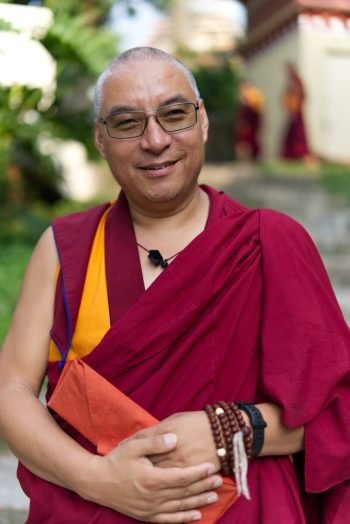
Chant Master of Gelug Monlam at Kopan Monastery, Geshe Losang Sherab.
Geshe Losang Sherab has been the head chant master for the Gelug Monlam for twenty-one years. He describes the position:
“Being the umze of the Monlam I have the responsibility of the leading the chanting and to make sure that it’s done in as authentic a way as possible. I prepare a group of monks who are called Kesang (“good voice”) and Donsang (“having memorized many texts”) and teach them the tunes, and also make them memorize the texts they haven’t memorized. I also do at least six to seven days of training with all Kopan monks and a full rehearsal before the actual Monlam.”
The progression and practice of the Monlam is very elaborate and specifically organized. We asked Geshe Losang Sherab to help describe a picture of the tradition. He kindly offered a detailed account below:
“The prayers that are recited during Monlam are common in all Gelug monasteries, but the tune that is used during the actual Monlam is always from Drepung Monastery, as it was done since the time of the second Dalai Lama.”
Geshe Losang Sherab explained that it was the second Dalai Lama who “restored the great Monlam in Lhasa and established rules and regulations, including the set of prayers that are recited during the Monlam.”
The rest of the prayers, apart from the main Monlam activities, are chanted in the Sera Je Monastery tradition – the monastery that Kopan is most closely connected with.
“During the first session in the morning, many prayers are recited, mainly the homage to Buddha, confession to Thirty-five Buddhas, Ornament for Clear Realization (Abisamayalankara ) by Venerable Maitreya, Introduction to the Middle Path (Madhyamakavatara) by Chandrakirti and Manjushri Nama Samgiti, etc. Tea and bread is served during this session.
“During the second session, monks and nuns from all the monasteries and nunneries would debate on logic to the geshes from Kopan who are appointed to answer the debate.
“During the third session, the head lama of Monlam is invited with procession of gyaling [horns], victory banners and yellow parasol. The chant master chants Migtsema prayers until the lama sits on the throne. Then all Sangha sit on the floor offering three prostrations to the lama. The lama would lead the Heart Sutra followed by the prayers to lineage lamas. After that, the chant master makes three prostrations and chants the mandala offering, after which the lama would teach on the Jakata Tales. After it’s completed, the lama would do dedications, and then he’s invited to his quarters in the same way he was invited to the teaching venue.
“After that, there’s a session during which tea and lunch is served. During this session, Lama Tsongkhapa guru yoga, lamrim Lines of Experience, Triple Ground of Glory, prayers to sixteen Arhats, eight powerful prayers, mantras such as the Namgyalma long mantra, and Medicine Buddha mantras are recited.
“Then after half an hour break, the fourth session begins. During this the monks and nuns from all the monasteries and nunneries debate on the paramitas and on view of the Middle Way to the appointed answers from Kopan.
“Then the actual Monlam begins after the Head Lama is invited with a procession of gyaling [horns], victory banners, and parasol. The lama makes three prostrations to the altar and then sits on the throne. After this all the Sangha sit down. The chant master leads prayers standing on his seat, beginning with the Likdrima (praise to Tara), Kapsumpa (praise to the Buddha by Lama Tsongkhapa), Losang Gyalkunma (supplication to the lineage gurus), prayers of Maitreya, and the Prayers at the Beginning, Middle and End by Lama Tsongkhapa. During the last two prayers, the chant master would walk with huge steps during each verse which is called Cham (“dance”), and offer a khata [scarf] to the lama. The chant master then walks backwards and sits on the seat.
“After that, the assistant chant master and his three companions stand up and start the bath offering prayers and offering the five objects of desire, the seven royal possessions, etc., then an extensive mandala offering followed by prostrations, reciting the confession to Thirty-five Buddhas, and sits down. Then the head lama starts the torma offering to the landlord, after which the chant master stands up and leads the prayer of secret biography of Lama Tsongkhapa. During this, the chant master performs the Cham dance with huge steps at the end of every verse. Then the Foundation of All Good Qualities is chanted. While chanting, the chant master goes back to his seat, walking backwards with huge steps and sits down on his seat. After this, the head lama recites the dedication prayers.
“At the end of the session, the chant master, the assistant chant master and his three companions stand up, wearing the yellow hat and recite the auspicious prayers. Then the lama is invited to his quarters. During the fifth session, extensive White Umbrella prayers and prayers to Lion-face Dakini, and Twenty-one Tara praises are recited. Dinner is served during this session.
“During every prayer session, the Gegu (“master of discipline”) reads the dedication forms with the names of sponsors. During every prayer session, the Heart Sutra and the Hundred-syllable mantra are recited, and at the end of every prayer session, the torma offering to Palden Lhamo and other protectors are recited. The program ends with debate on Vinaya and Abhidharma in the evening.
“On the fourth day of Monlam, which falls on the full moon day, the beautiful butter sculpture made by Kopan monks is displayed outside for the people to get blessed. On the last day of Monlam, Maitreya Buddha statue is invited with a huge procession. And in the afternoon [of the last day], Kopan Lama Gyupas offer the Torgyak which they have prepared and consecrated for three days. Then a dinner session is held and during which the secretary of the Monlam reads out the account of income and expenses of Monlam, and then the Monlam of that year concludes auspiciously.”
Please join us in rejoicing in the preservation of this incredible tradition at Kopan Monastery! The Lama Tsongkhapa Teachers Fund is a sponsor of the Gelug Monlam which is essential for preserving the Lama Tsongkhapa tradition.
Since its inception, the Lama Tsongkhapa Teachers Fund, an extension of the Supporting Ordained Sangha Fund, has supported the preservation of the Gelug School of Tibetan Buddhism.
With tremendous thanks to Geshe Losang Sherab for his time and information about this rich tradition.
9
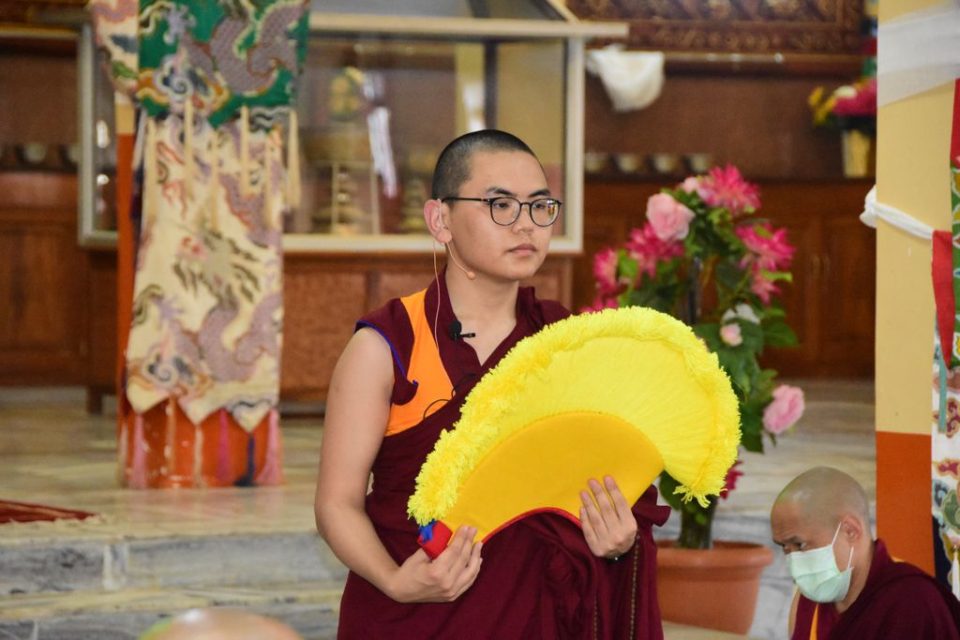
Tenzin Phuntsok Rinpoche during his rik chung debate, Sera Je Monastery, India, September 2021. Photo courtesy of Sera Je Audio/Visual Department.
Tenzin Phuntsok Rinpoche is the recognized reincarnation of Geshe Lama Konchog, a highly respected lama who passed away in 2001. Phuntsok Rinpoche was born in the Tsum region of Nepal in 2002 and enthroned in 2006 at Kopan Monastery, where he lived and attended school for a few years. Rinpoche then spent three years in Perth, Australia, where he received a Western education. He began his studies at Sera Je Monastic University in India in 2015.
Ven. Tenzin Gache, an American monk in the geshe studies program at Sera Je, has been tutoring Phuntsok Rinpoche in debate since 2016. Ven. Gache shares this story of Phuntsok Rinpoche preparing for his rik chung debate at Sera Je, which took place in September 2021, along with other stories from working with Rinpoche over seven years.
Swallowing Butterflies
Tenzin Phuntsok Rinpoche calls me at 3 p.m. to discuss bodhicitta. I ask him, “Are you nervous?”
He responds, “You know that feeling like when you swallow a can of butterflies?”
Over the course of an hour, we have a lively, often humorous discussion about the goal, the benefits, and the different kinds of bodhicitta. As usual, our conversation is a haphazard mix of English and Tibetan, often switching back and forth several times in one sentence. After fifteen years in the monastery, my spoken Tibetan is strong, but it is no match for the fluency of his English after his spending three years in a primary school in Australia.
We started our “intensive sessions” four months ago, and alternated walking across the campus to visit each other until Sera Monastery re-entered a strict lockdown and relegated all classes to the virtual realm. We are hopeful that the monastery will reopen soon, but Rinpoche knows that as soon as it does, he will have to face the most difficult trial so far in his eighteen-year life.
Becoming Tenzin Phuntsok Rinpoche’s Tutor
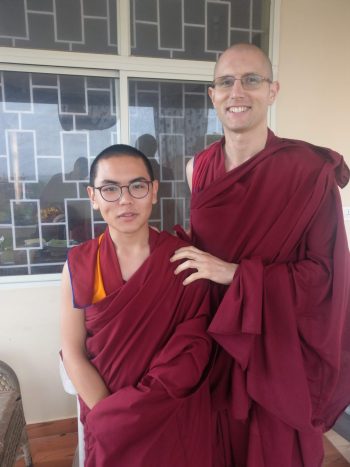
Tenzin Phuntsok Rinpoche with Ven. Tenzin Gache. Photo by Ven. Losang Donyo.
In 2013, Geshe Tenzin Zopa read my Mandala article “The Greatest Honor of Becoming a Rik Chung” about my experiences with a prestigious public debate in front of the Sera Je community. Intrigued that a Westerner was making inroads into this conservative Tibetan community, Geshe-la asked me if I would be able to help his young student, Phuntsok Rinpoche, to adjust to life at Sera, and tutor him in debate. I had only met Rinpoche once, very briefly, during his visit to Sera Je Kopan House in 2006, a couple months after I first arrived. Geshe-la introduced me to him again during His Holiness the Dalai Lama’s teachings at Ganden Monastery in 2014. I bent down and asked, “Rinpoche, how old are you?”
“Only twelve,” he replied and then added enthusiastically, “but next year, thirteen!”
Not long before that encounter, Osel Hita had visited us at Sera IMI House, and something he said stuck with me. Osel wanted to write a book about how to raise a tulku. The most important factor, he emphasized, is to remember that before anything else this person is a child, and like every other human being on the planet, deserves the liberty to develop their own point of view, without unrealistic expectations thrust upon them.
Becoming Tenzin Phuntsok Rinpoche’s Friend
Phuntsok Rinpoche arrived at Sera at the end of 2015, again during teachings of His Holiness the Dalai Lama. Along with my mother and Aunt Merry Colony, who were visiting for the teachings, we visited Rinpoche in his small house, a gift given by Ven. Jampa Shenphen, a Spanish monk who lived at Sera for many years. Geshe Zopa pointed out that after having finished eight years of study at Sera, I had reached a plateau from where I could comfortably cruise through the remainder of the study program. Rinpoche, on the other hand, was only just beginning, and the ascent would be a steep one. Somehow my mother got on the subject of pet cats, and Rinpoche became animated. “Can we get a cat in our house? Pleaaase?” he begged. Geshe-la reminded him that, while he was free to make such choices, he would have to recognize that he was reaching an age where he would have to take responsibility, especially because Geshe-la would be continuing to teach abroad. Geshe-la then suggested that I accompany Rinpoche to visit Lhopa Khangtsen, the house group to which I belong and which, because it was the house group of his predecessor Geshe Lama Konchok, would also be Rinpoche’s house group in this life, even though he had never visited it himself. As we walked across the campus, lively with preparations for His Holiness’s teachings, I asked Rinpoche, “Do you have any friends in Lhopa Khangtsen?”
“Only one,” he replied.
“Who?”
“You.”
As the study year commenced in March of 2016, I began making twice weekly trips to Rinpoche’s home to help him with his budding debate skills. Naturally we also talked about life in the monastery. After his childhood in Kopan Monastery—compared to Sera, a very progressive community—and his three years in Australia, life at Sera seemed almost as foreign as it had to me when I arrived. I had the sense I was tutoring a young Australian boy rather than a child of a Tibetan family living in exile in the remote regions of Nepal. His classmates in Australia had known nothing of his background, or his being a monk. He was shy about introducing them to his uncle, Geshe Zopa. When they asked if they could visit him at home, he would reply, “No, sorry. I forgot my address!”
I asked him what was his favorite subject in school. Rather shyly, he said, “Math. When I told them I liked math, the other kids called me, ‘freak of nature’!”
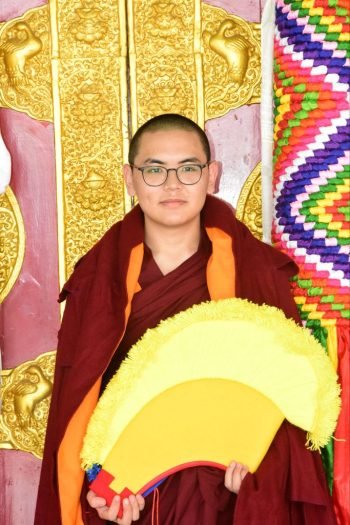
Tenzin Phuntsok Rinpoche outside the Sera Jey Temple after his rik chung debate. Photo courtesy of Sera Je Audio/Visual Department.
Having myself been a math prodigy as a young child, I was beginning to see that we were going to get along very well.
Developing a Point of View through Deep Investigation
Over the course of four years, our interactions took on a familiar pattern. I would visit Rinpoche on Tuesdays and Saturdays. The official subject was Buddhist dialectics, but more often than not our discussions would segue into current events, history, science, and life as a teenager. Rinpoche clearly took his role as a Buddhist monk seriously, but also had all kinds of natural questions about the deeply traditional system of the Tibetan monastery. Things came to a head in 2019, when an especially strict disciplinarian became director of Lhopa Khangtsen. He began his term with a speech outlining his new policies.
“Up until now, there’s been leniency for Injis [foreigners] and tulkus,” the disciplinarian said. Rinpoche and I looked around. There was only one Inji and one tulku in the room. “But from now on, things are going to change!”
As it happened, 2019 was Rinpoche’s fourth year of debate, and according to tradition he would have to answer the senior monks in a public debate in front of our khangtsen. The director called Rinpoche into his office. Displaying a melodramatically wistful demeanor, he reminded Rinpoche of the great lineage of Lhopa debaters. Would he be able to uphold the high standard? For two months Rinpoche and I met as much as possible to prepare. The evening of his big event, lharampa geshes stood up in succession and did their best to embarrass him. I watched as his usual shyness gave way to confidence and poise. This was the first time I had watched Rinpoche debate in public, but I had heard of his top-rate performance during the annual debate exams. It seemed that something deep within him was slowly waking up.
Over the course of the year, the director often singled the two of us out for scoldings. Rinpoche bore the challenge with grace (and, understandably, occasional panic). But one day, the director commented to Rinpoche that, “Science is dangerous. Look what it’s done to the world!” Rinpoche did not remain quiet, but responded assertively, “Well, it’s true. Atrocities have been carried out in the name of science. But you can’t say that means science is the problem. The world today is a much safer and more tolerant place as a result of advances in the past centuries. Whether something is used for good or bad depends on the mind of the person using it.” To me, his conviction in his point of view was a reflection of his having developed it through his own investigations.
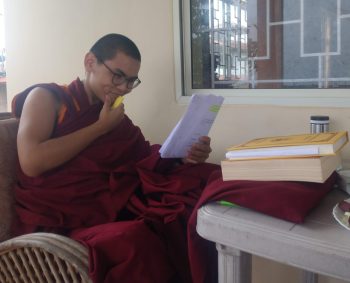
Tenzin Phuntsok Rinpoche studying. Photo courtesy of Ven. Gache.
Due to the pandemic, I was stuck in Nepal during 2020, and when I finally returned in January 2021, I had not seen Rinpoche in almost a year. During my absence he had started listening to podcasts and gaining a deeper understanding of the world outside. There was a noticeable difference in our interactions—rather than my rattling off answers to his endless adolescent questions, we were engaged in a discussion.
“I hear on the news about violence in various places. But I know the news can be sensationalist. I try to see the broader perspective, to remember all the good things that don’t get reported,” he said to me. I had shared this viewpoint with him a few years ago, but now it was evidently coming from him.
At one point he asked me, “Do you think communism has ever succeeded in making the world a better place?” I told him that, while certainly the track record has been highly suspect, I keep in mind that at some level the authors of this ideology had a motivation of altruism. We got into a long talk about Marx, Lenin, Mao, and Castro. For the sake of argument, I pointed out some of the apparent successes, but Rinpoche was adamant in his position that this experiment has failed. Unlike before, he wasn’t just accepting what I said, but came back with his own opinion that he had developed.
Tenzin Phuntsok Rinpoche’s Humor and Candor
A few months later, we are discussing Shantideva’s assertion that, while trying to create positive change in the world is a worthy motivation, it is not a bodhicitta motivation unless somebody thinks beyond just this life and fathoms the reality of enlightenment. Rinpoche is preparing for his rik chung debate. As it happens, he will be in the position of “defender” for the subject bodhicitta, exactly the same position I occupied eight years ago. I have several books packed with notes from my preparations, and we have been going through these together when he has time between his rigorous training in the traditional chant he will have to perform. I ask, “What are you most nervous about? The chant or the debate?” He says, “Actually, my biggest concern is that I might trip on the dagam!” (A dagam is a heavy wool cape that he will have to wear for the ceremony.) I remember my own struggle to master all the details of the ritual, so we set aside our philosophical discussion and spend the hour thrashing out all the fine points that he is expected to perform with precision.
I never had the fortune to meet Geshe Lama Konchog. A few of the older monks in our khangtsen remember his extraordinary, almost superhuman efforts to apply the teachings into practice. While I do believe in reincarnation, I do not hold any expectations for Rinpoche to “live up” to his predecessor. I consider him a different person who will develop his own unique perspective on the Buddha’s teachings based on his extremely unconventional education path in this life, and his candor which I see as his strongest quality. Rinpoche himself always keeps a tongue-in-cheek attitude about his relation with Geshe Konchog. At the end of 2019, I brought two young Singaporean boys to meet him in his home. Motioning to the small shrine in his living room, he says matter-of-factly, “Well, that was me!”
One of the boys, Tashi, asks rather inelegantly, “When did you die?”
Rinpoche plays along. “I died in 2001. You see, I’m really a ghost!”
Ven. Tenzin Gache (Brian Roiter) grew up in the Boston area of the United States. He was ordained by His Holiness the Dalai Lama in 2005 and began studying at Sera Je Monastary in 2006. He is nearing the end of the regular course of study for the degree of geshe and aspires to attend the additional six-year round of Gelug examinations to qualify for the degree of lharampa.
29
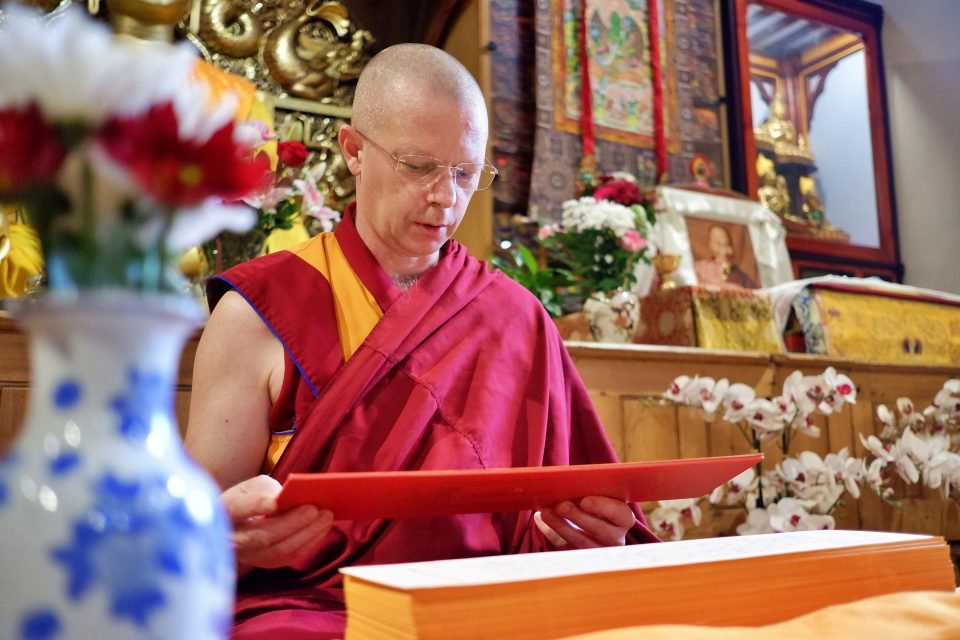
Geshe Tenzin Namdak teaching at Jamyang London Buddhist Centre, UK. Photo courtesy of Jamyang London Buddhist Centre.
FPMT Spiritual Director Lama Zopa Rinpoche regularly encourages Western students to undertake serious, in-depth study of Buddha’s teachings. Rinpoche advises this to his students not only for their personal benefit, but because once they complete their studies, they are able to teach others.
Geshe Tenzin Namdak, a Dutch monk who spent more than two decades studying at Sera Je Monastic University in India, exemplifies this potential. His ability to combine the traditional Buddhist monastic education with a modern Western sensibility makes him a profoundly qualified teacher for students at FPMT centers. And in the short space of nearly three years, Geshe Namdak has offered teachings to hundreds of appreciative students around the world.
Kamlo Chen-Duffy, the spiritual program coordinator at Jamyang London Buddhist Centre, shared this profile of Geshe Tenzin Namdak, who currently serves as the center’s FPMT resident geshe.
On May 8, 2017, Geshe Tenzin Namdak became the first Westerner to complete the twenty-year-long Geshe degree at Sera Je Monastic University. With that, his name joined a short but inspiring list of Westerners who have completed geshe studies programs, including Geshe Kelsang Wangmo and Geshe Tenzin Losel (Graham Woodhouse). This momentous achievement was followed by the completion of traditional postgraduate studies at Gyudmed Tantric College in India, solidifying Geshe Namdak’s status as a paragon and torchbearer for Dharma students practicing within the Nalanda tradition, both in the West and around the world.
Shortly after Geshe Namdak’s graduation, Lama Zopa Rinpoche, who is Geshe Namdak’s root guru, appointed him as the resident teacher of Jamyang London Buddhist Centre. Geshe Namdak follows an illustrious line of resident teachers at Jamyang, including Geshe Namgyal Wangchen and Sera Mey Khen Rinpoche Geshe Tashi Tsering. In the summer of 2019, Geshe Namdak became the present custodian of this forty-year-old community, quickly building a rapport with its students, who were deeply grateful for his arrival.
During his first years in this post, Geshe-la, as he is called, has placed an emphasis on in-depth Buddhist study, recognizing the great benefit students derive from pursuing the structured study pathways provided by FPMT Education Programs. Geshe-la has highlighted the importance of this kind of education to students:
Why are we studying these in-depth aspects of Buddhism? Basically, to eliminate suffering for self and others. To commit yourself to something is good. If you really want to step further in your understanding of the Buddhist path, though it asks for effort, commit yourself to something like this. … Then it starts to come alive.
This focus on structured learning at Jamyang began with the launch of Discovering Buddhism, a Foundational FPMT Education Program. The cohort of students who embarked on this study path with Geshe-la celebrated completing the course in July 2021. At the end of the final teaching, students were invited to share their reflections.
“We all really want to thank you from the depths of our hearts for your incredible, skillful, and prudent guidance over the last three years on this fantastic journey of Discovering Buddhism,” said Nick Holzinger, speaking to Geshe Namdak on behalf of his peers. “Thank you for your amazing kindness and love. Thank you for your patience. And thank you especially for the incredible Dharma wisdom that you shared with us.”
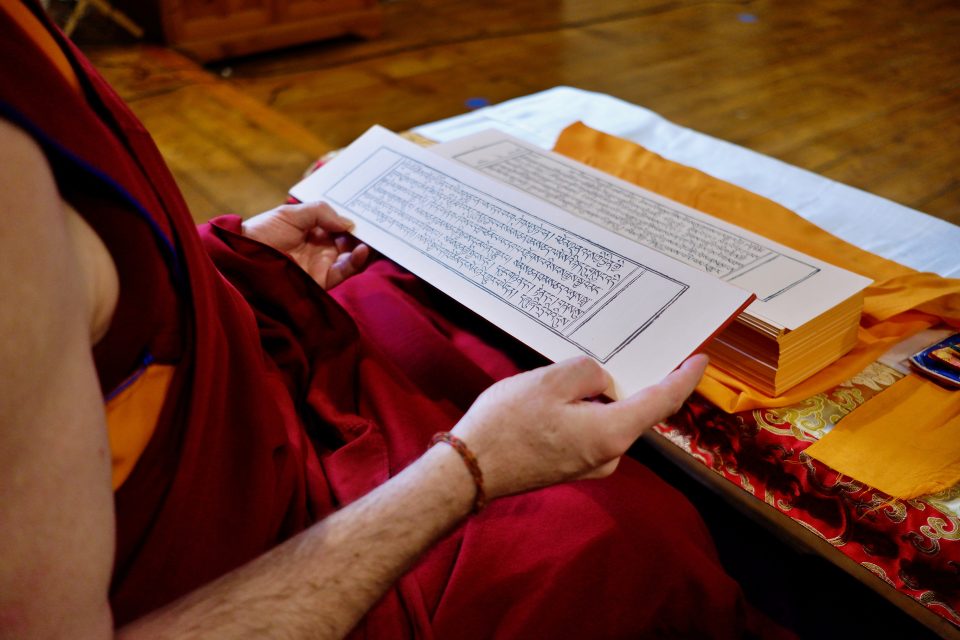
Geshe Tenzin Namdak holding pecha pages at Jamyang London Buddhist Centre. Photo courtesy of the center.
Given Geshe Namdak’s dedication to providing in-depth study, it is perhaps unsurprising that he would next turn his attention toward the FPMT Basic Program (BP), which is a five-year course of advanced study. Before undertaking such a long-term commitment, Geshe-la checked with Lama Zopa Rinpoche about whether it would be of benefit. Rinpoche confirmed that commencing the BP at Jamyang would indeed be the best next step for the center. His observations were quickly corroborated when registration for the course opened in the summer of 2020 and Jamyang received more than two hundred applications from interested students worldwide.
This level of enthusiasm certainly exceeded expectations. As Geshe-la said during Jamyang’s Open Day for prospective program students, “There was a trend that in-depth studies maybe had less interest in recent years, but now I see there is a lot of interest. So I’m very happy to see that. That’s a sign of being extremely fortunate.”
Even in its second year, the BP at Jamyang has already had a transformative effect on the lives and minds of many students. They are being nurtured, supported, and encouraged by Geshe Namdak and a dedicated group of teaching assistants, who are graduates from the previous round of BP at Jamyang. Students are now used to Geshe-la urging them to persevere. “Studying to become a Buddha” is no easy task, he says, but a defeatist attitude that balks at the challenge is “not very constructive” and in the end “gives the victory to the afflictions.”
Geshe Namdak’s students have come to see the advantages of studying in a systematized manner and appreciate the value of being able to do that under the guidance of someone as learned as Geshe-la. “With each and every teaching I realize more and more how privileged we are to have Geshe Namdak as the resident teacher here at Jamyang. It feels like an impossible task to fully understand how precious it is to have him as our teacher,” said Adam South, a BP student. “His humility, patience, and kind nature are a testimony to the effectiveness of the Dharma. His ability to skillfully navigate the complexities of Dharma teachings while maintaining a light-hearted attitude makes Jamyang a wonderful place for in-depth study.”
With Geshe Namdak’s 2020 cycle of the FPMT Basic Program having firmly taken root, an exciting new project has begun to germinate: the Exploring Buddhism course. This new Foundational FPMT Education Program covers carefully selected topics of Buddhist philosophy and practice. These are compiled and presented in modules that help students build a good foundation for advanced studies. At the request of Ven. Joan Nicell, who at that time served as FPMT’s Foundational Program Coordinator, Geshe Namdak drafted the initial course in collaboration with Ven. Tenzin Legtsok, who is currently studying at Sera Je Monastic University. At present Exploring Buddhism is under further development by FPMT Education Services and is being piloted by various FPMT centers in several countries, enabling FPMT students worldwide to advance in their Dharma education.
As we all know, 2020 was no ordinary year. The pandemic changed the way many Dharma centers provide teachings to students. Geshe Namdak, like innumerable other teachers, had to adapt to using video conferencing platforms to give teachings. Out of this disruption, however, new opportunities arose. Teachers found themselves able to connect with a greater number of students. Indeed, many of those studying the FPMT Basic Program with Geshe-la do so remotely, from around the globe.
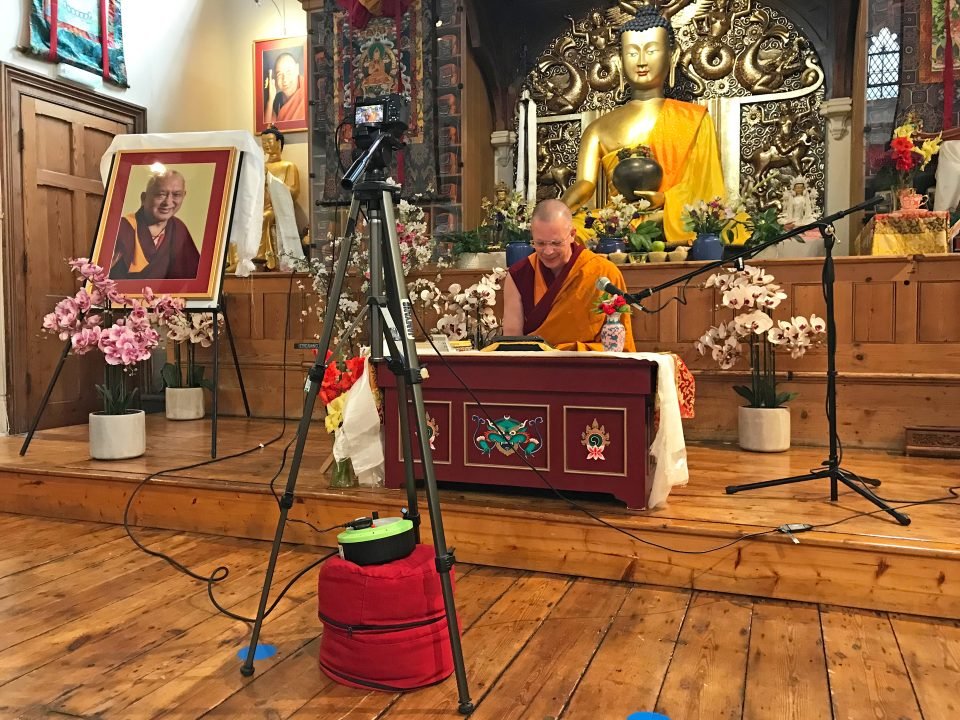
Geshe Namdak giving an online teaching from Jamyang London Buddhist Centre. Photo courtesy of the center.
Even while Jamyang was in lock-down, online teaching allowed Geshe Namdak to continue to accept invitations to teach from other centers and study groups, extending his activities far beyond the stone walls of the courthouse where Jamyang is situated in London. For example, Saraswati Study Group in Somerset, UK, is mid-way through its own cycle of the FPMT Basic Program. Geshe-la has been teaching the group on specific subjects.
“We have already benefited significantly from Geshe Namdak’s teachings. He is so clear,” said Neil Atkinson, Saraswati’s coordinator. “It’s a very secure basis on which to practice. I have the instinctive feeling that if one listens, reflects, and then meditates on what Geshe-la says, the scope for making mistakes or for things going awry is very small.”
Being able to teach remotely also removes the demands of international travel. And Geshe Namdak has certainly made the most of this opportunity, teaching as far afield as the Netherlands (his home country); Bangalore, India; New York; and Madrid, Spain. Due to specific advice from Lama Zopa Rinpoche, Geshe-la has also given well-attended teachings on philosophy to students at Nalanda Monastery in France.
“I am extremely lucky to be Geshe Namdak’s student,” said Conchi Fernandez, who is the spiritual program coordinator of Nagarjuna Centro de Estudios Budismo Tibetano in Madrid. “It is very easy for me to understand Dharma and integrate his teachings as he combines the traditional teachings with the way Western people need to study the Dharma. Also, his sense of humor and the way he is close to people—even though we study online—is something that makes the Dharma easy and profound at the same time.”
While Geshe-la is known by his students for his deep respect of the traditional presentation of the Buddhist teachings as preserved and passed down by generations of Indian and Tibetan masters, he is also innovative. Following His Holiness the Dalai Lama’s example, he has made a concerted effort to collaborate with scientists. The fruit of this effort has manifested in “Science & Wisdom LIVE,” an initiative that brings contemplatives of various traditions into dialogue with experts in various scientific fields, including neuroscience and quantum physics.
As part of this project to make Buddhist wisdom accessible to new audiences, Geshe Namdak had an enlivening online conversation with theoretical biologist Dr. Rupert Sheldrake in June 2021. Their discussion explored the nature of reality, interconnectedness, and the relationship between consciousness and matter. “I much enjoyed the experience and found it very helpful in deepening my understanding of the Buddhist approach,” Dr. Sheldrake said of the encounter. “Geshe Namdak is amazingly clear in his explanations.”
Success in Buddhist studies requires many factors, including engaging in activities to accumulate merit, purify negativities, and eliminate obstacles. With this in mind, Geshe-la has inspired the community at Jamyang to undertake specific projects and adopt new traditions. These include annual recitations of scripture during the period of Saka Dawa and “Honouring the Lineage,” a project to install statues of the lineage masters in the gompa at Jamyang. Thus far, new statues of Shakyamuni Buddha, Lama Atisha, and Guru Rinpoche have been consecrated and installed, as well as Lama Tsongkhapa and his heart sons. The fundraising for the second part of the project—which will see the installation of statues of Manjushri, Chenrezig, Vajrapani, Nagarjuna, and Asanga—has already been completed.
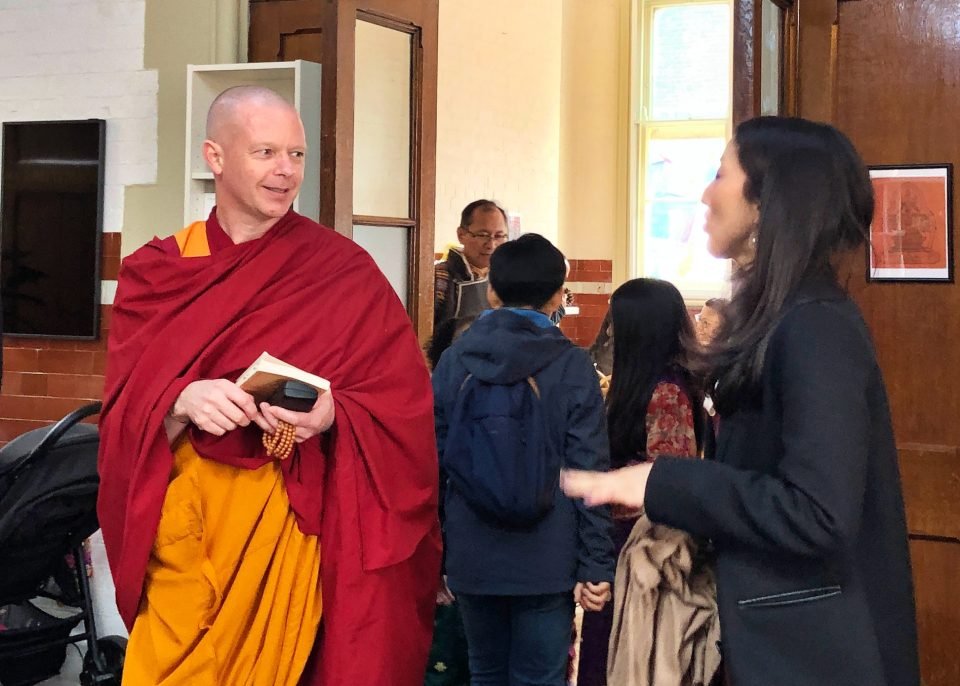
Geshe Namdak on Losar at Jamyang London Buddhist Centre, March 2022. Photo courtesy of the center.
Although he has adapted to life back in the West, for decades Geshe Namdak was immersed in, and derived great benefit from, Tibetan culture. He now gives regular talks to the UK Tibetan community, including the younger generation, in order to repay the kindness of the Tibetan people. Pempa Samuels is a teacher and member of the Tibetan community and also an FPMT Basic Program student at Jamyang. “He gives stories of his journey. He gives his time. He’s patient and encourages us. He gives us a realistic attitude,” Pempa said. “I’m really glad that Geshe-la has come to London and taken on board a massive amount of teaching roles. I’m grateful for that.”
A key factor that sustains Geshe Namdak’s connection to the Tibetan community is his fluency with the Tibetan language. This skill has also been put toward a number of virtuous translation projects, including short texts at the request of Lama Zopa Rinpoche and a big project undertaken in partnership with Ven. Tenzin Legtsok for Sera Je Monastic University. Their translation of key parts of Khedrup Je’s Clearing Mental Darkness: An Ornament of Dharmakirti’s ‘Seven Treatises on Valid Cognition’ will be titled Freedom through Correct Knowing: On Khedrub Jé’s Interpretation of Dharmakirti and will be published by Wisdom Publications in August 2022.
Finally, Geshe Namdak sets an inspiring example for students, not only through his many teachings, but also by remaining committed to go into retreat for several months of the year, despite his active schedule. As he has said himself, “It is important to do retreat even when involved in many projects.”
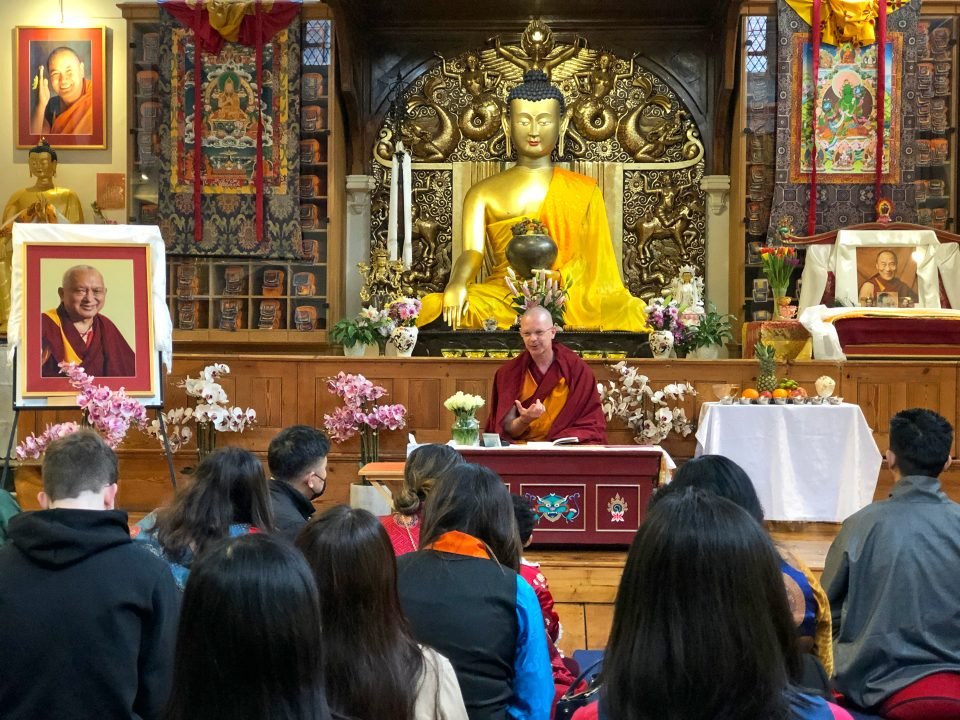
Geshe Namdak giving a teaching for Losar, Jamyang London Buddhist Centre, March 2022. Photo courtesy of the center.
It is clear to see from these many endeavors that Geshe Tenzin Namdak is fulfilling the vast visions and wishes of his own teachers, including His Holiness the Dalai Lama and Lama Zopa Rinpoche. Those who have the privilege of hearing his teachings have no doubt that his motivations are sincere and steeped in compassion. In a short space of time, he has uplifted the minds of countless students. In their gratitude, they pray for his long life and that he continues to turn the wheel of Dharma, and they thank Lama Zopa Rinpoche for his immeasurable kindness in enjoining Geshe-la to teach.
Kamlo Chen-Duffy began working at Jamyang London Buddhist Centre as the center manager in September 2019. He transitioned to the role of spiritual program coordinator in May 2020. Since then, he has helped coordinate the enrollment of nearly four hundred students in long-term courses taught by the center’s resident teacher, Geshe Tenzin Namdak. Kamlo is also studying the FPMT Basic Program with Geshe Namdak.
Learn more about FPMT Education Programs and opportunities to study Buddhism both online and on site on FPMT.org. You can also read more about Geshe Tenzin Namdak.
- Tagged: basic program, discovering buddhism, exploring buddhism, geshe tenzin namdak, jamyang buddhist centre
5
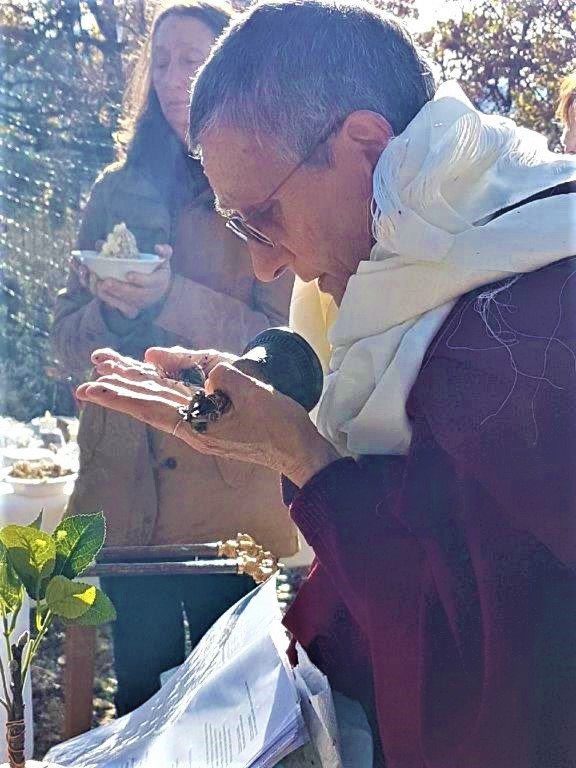
Ven. Thubten Lhamo offering puja.
The French nun Ven. Thubten Lhamo took refuge at Kopan Monastery in Nepal with Lama Thubten Yeshe in December 1979. She was ordained at Kopan in April 2017, on her sixty-sixth birthday. On November 13, 2017, under Lama Zopa Rinpoche’s advice, she started a three-year Vajrayogini retreat at Thakpa Kachoe Retreat Land in France. To conclude the retreat, Ven. Lhamo had to do fire pujas, which were done with the advice of Geshe Tenzin Loden, the resident geshe at Institut Vajra Yogini (IVY) in France. It took her four months to prepare for doing these pujas at IVY and four additional months to complete them, which happened in July 2021. As we publish this interview, Ven. Lhamo is in the Pyrenees finishing some commitments and doing more retreat.
As she was doing the fire pujas, Nicolas Brun, director of IVY, sat down with Ven. Lhamo to talk about the retreat. She shared that it does not feel appropriate to her to call it “her retreat” since so many people helped her with it. This reflection of her humble and sincere approach to practice runs throughout this interview. Please note that this interview was done in English although French is Ven. Lhamo’s first language. We are so pleased to share it with you. May it be the source of incredible inspiration for your own practice and retreat aspirations!
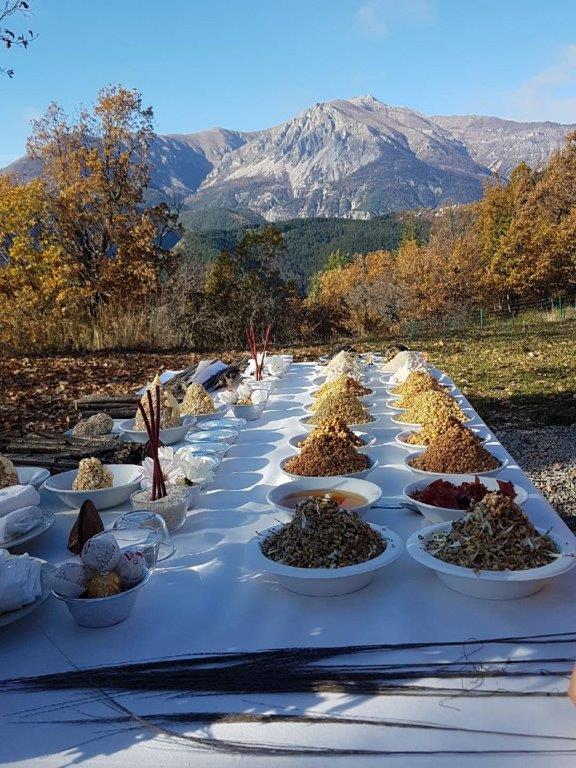
Offerings at Thakpa Kachoe Retreat Land, France.
The Interview
Nicolas Brun: How did you decide to do three-year retreat? It is a large undertaking. What motivated you to do it?
Ven. Lhamo: So, I did not decide. I asked Lama Zopa Rinpoche for advice because I have made so many mistakes. There were many things to do. The advice was written: “three-year retreat.” I thought it was a preliminary practice. I didn’t understand. And then when I stopped working, I asked Rinpoche about this retreat, and he told me, “Vajrayogini retreat.” That’s the way it happened.
How long did it take to prepare to go into retreat? What are the preparations you made?
It took me a long time because when you do retreat you have to do nine preliminaries. Some preliminaries I had done before, but some I had not done. It took me, maybe … two years? More than one year. So I did them at different places—Osel Ling, my house, Institut Vajra Yogini, Nepal, Bodhgaya. I received help from Holly [Ansett] to know what all these preliminaries were because, again, I didn’t know anything about this. It was very funny, you know, I had no information about all this. So the main thing was this preparation.
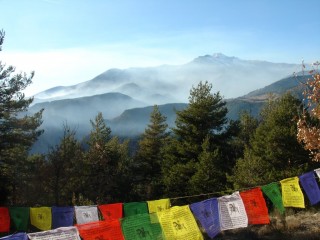
Beautiful surroundings at Thakpa Kachoe Retreat Land.
Describe what an average day was like during the three-year retreat. What was your environment like?
For me it’s not easy to wake up early in the morning, so I woke up at 6:20 A.M. and would start quite late. But I felt okay doing like this. I was doing four sessions a day, maybe two hours each, and finishing later in the evening. I think it was okay for me to do like this. The main thing was to do the four sessions. Except sometimes when I was very tired, I would do three or even one when I was exhausted. But I kept doing my four sessions most of the time. I also had to do my normal practice. I had to cook. I went for a walk every day at lunch time because I was in a very beautiful place in the mountains, and I think for me this was a very good habit because I needed space, you know. The forest was beautiful, and there were animals. It was a good way to relax.
What advice was important to you during this retreat?
I was doing what Lama Zopa asked me to do. This was very important because most of the time I felt that I don’t understand anything, I’m unqualified, my mind is unsubdued. The only thing I had was Rinpoche told me to do this retreat. That was the only thing that could keep me there on my cushion. He knows why I am doing this. But I don’t remember that he gave me special advice. Maybe I would have needed more advice, but maybe I didn’t know how to ask for it, I don’t know. This could maybe have to come from me, but I didn’t ask Rinpoche.
For other people, I think it might be really nice if you have someone who can really help you when you feel bad. And at some point Geshe-la [Geshe Loden] here helped me, but more for practical questions like how to do the fire pujas and things like this.
But what was going on inside, I had to cope with it. I didn’t feel helpless, but maybe that’s the job to do.

Ven. Lhamo at Thakpa Kachoe Retreat Land, France.
What was the most difficult part of doing the three year retreat? Did you ever think about giving up?
It was difficult just to be with myself. This is always difficult because you face your mind all day long. You cannot escape. You have to cope with it and face it.
I didn’t think to give up, I don’t think so. But I was desperate, I cried a lot. I had many wounds inside. But I could see that everybody has, so that gives me more compassion for people. When I do funny things or bad things, it is because I have this wound that is not cured. But my challenge was not to get hypnotized by my wounds, but to go very deep inside the wound because then at some point it’s like it disappears. I had this experience. I didn’t think to give up because I said, “Yes, I will do.”
Were there other difficult things other than being with yourself?
Sometimes you can be sick. I became very thin during my retreat. I had problems with the liver, pain all night. And to cope with this, the main thing is the mind.
You have to accept yourself and learn to love yourself. I considered that if I don’t love myself, then I cannot love anyone because then I will pretend I love others just to gain a good feeling or to look nicer or to have a reputation or things like this. I could see it was a duty to love myself. And I wrote, “I have to love myself even when I don’t love myself.” And maybe this is the main thing I have learned. I mean, I am not finished learning this.
Because then, all of the practice is twisted, and I had this question all the time, “Where is the practice? What is the practice?” I had this question and I still have this question. It’s like you have questions, and you just follow something, and the questions are more important than the answers. This is the feeling I have; it is a process—“Where is the practice? Who am I? Who is practicing?”—because I didn’t want to just pretend.
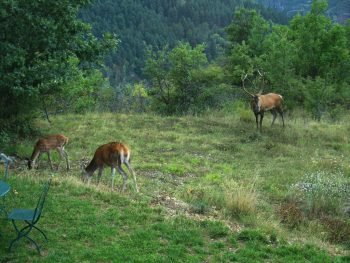
Some of the animals of Thakpa Kachoe Retreat Land, France. Photo courtesy of Thakpa Kachoe Retreat Land.
What was the most pleasurable part of doing the retreat?
It was not coming from my practice. [Laughter.] The pleasurable part was to go outside in the woods and to see the animals, and I met the people living there, very simple people. It helped me a lot because I talked with them, not much, but yes I talked. They knew I was in retreat, but I didn’t talk about my retreat. I like people like this. No big words, no big complicated Buddhist world.
Sometimes I felt good, and I followed the advice of Lama Yeshe. Lama Yeshe said to write down things. So I had on my table a small booklet, and especially in the morning I wrote many things.
So you had the advice to have a little booklet for writing down notes during the retreat?
Yes, when the thought comes, write it down because some seconds after, it’s finished. So you have to write it down when it comes. It used to come during my first session in the morning. I started and then I write. It was the best time to write. Have it ready to write in, so you don’t have to look for anything.
Do you read through the booklet again sometimes?
I am sometimes surprised what I wrote. Sometimes nice things, yes. So it’s just like a glimpse of something.
What was the most significant thing you learned in the retreat?
What I said before, to love myself. Then, at some point, I don’t know why I had this feeling that good or bad is the same—feeling good, feeling bad is the same. I had this feeling when I finished my retreat. I lost it now.
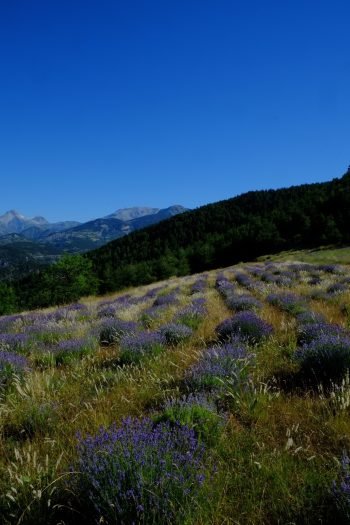
Thakpa Kachoe Retreat Land, France. Photo courtesy of Thakpa Kachoe Retreat Land.
You noticed after the retreat there was a little bit of equanimity?
I have no name [for it]. I have this feeling to go somewhere I have no name. I cannot say. Just, to love oneself. Because it’s not me, me, me. Because you can be fascinated by this. It’s just to love yourself, kind of, at the same time detached. I had this feeling that really, this was necessary. And that [there are these questions about] the practice—Where is the practice? Where is the real point? You have to [do this] work, you know? Because I can pretend, which I did before. I did pretend I was a holy being [laughs]. Then I made so many mistakes. So, yeah, Where is the practice? What is the practice? What does it mean really?
What advice do you have for others who are considering doing a long retreat?
I would like to say first that I am a very ordinary being. That means, anybody could do this retreat. Because I am just nobody special. I could do this retreat because so many people helped me all the time. So I had this feeling that it’s not my retreat.
When you feel bad, when you feel lost, at least you remember, “my guru told me to do this.” At least I had this.
Of course, to prepare the material things is so important. Like your papers [such as mail], medicine, health, teeth, what to eat. So with these things you have to be very well organized and have different solutions if things change. People can die. People can get sick. So be very clear about all this.
And then, if you are sick, what do you do? Do you go to see a doctor? Are you going to stay in your house? So I think maybe something has to be done about the caretaker. To help them to know what to do. Because when I was sick, it was difficult, and it’s like, I had to really be sure that I was sick, you know. To allow myself to go to the doctor. I waited until really I couldn’t cope with it. I went to the doctor, and one time to the dentist also.
So the caretakers, it would be important that the caretakers have training or maybe advice about how to help people during retreat because sometimes you have to make big decisions.
Yes, like to go to the doctor, I was not sure if I could wait. Do I have to go or not? I didn’t know, so that was difficult. And you have to think about what to do if people die. Because, of course, some people can die. You have to prepare to separate from your family. For me to separate from my grandson was most difficult.
Do you have any more advice?
Not to wait to be too old. You need energy and to be in good health. Because, of course, if you have pain, it is difficult. You have to know your limits and to know what you need. And for me, I had pain in the knees. But I couldn’t go see a physical therapist. I can go once to the doctor, but I cannot go every week to see them. So then, okay, you have to cope with your pain.
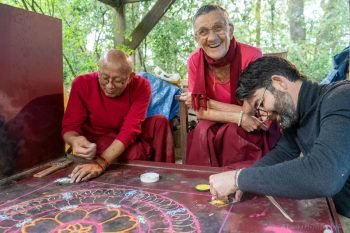
Ven. Lhamo (center) with Geshe Loden and Nicolas Brun, Institut Vajra Yogini, France.
You are doing fire pujas to complete the retreat. How long will that last?
About the fire pujas, I didn’t know anything because you cannot know everything before starting, there are too many things to know. So then you learn little by little. When I asked Lama Zopa Rinpoche he told me to ask Geshe Loden at Institut Vajra Yogni. So then Geshe Loden spoke about making pills, 650,000 pills. Then, I had to buy a machine in China to make pills. So then, that was very difficult. But, what was nice is that many people helped me to make these pills. And during the process we learned a lot. Sometimes we were desperate during the retreat because the machine was not working. Then it was very friendly and very joyful at the same time—the feeling to help each other and do something nice. Actually it was a very good experience. So when we finished it was, “Oh! Finished!” But it is not finished because now I have to burn all of these pills. So to burn I think it will take maybe three months. Something like this.
What do you have planned for what comes next?
I don’t know what I will do next. Maybe I will go to Dorje Pamo Nunnery. I will ask Rinpoche’s advice. This is the main thing. I will offer what I intend to do, and I will ask his advice because I don’t know.
And I still have more retreats to do anyway, all the other retreats. But when I was doing the three-year retreat, I had the feeling that my life now is retreat. I didn’t have the feeling that I will finish now. It’s not that I mediate, I am not a meditator. And if I did this retreat I think it is because I am lazy, I have no discipline. So I need something strong, and then I do.
I hope you are able to find another strong project.
I will see what Lama Zopa Rinpoche says. Really, I feel him a lot. And this place, this place in the Alps, is a very nice place. Because as soon as you go outside, you have this big, big space and it’s beautiful. So this helped a lot.
Billions of Thanks from Lama Zopa Rinpoche
After the retreat, Lama Zopa Rinpoche wrote a letter to Ven. Lhamo, including the following:
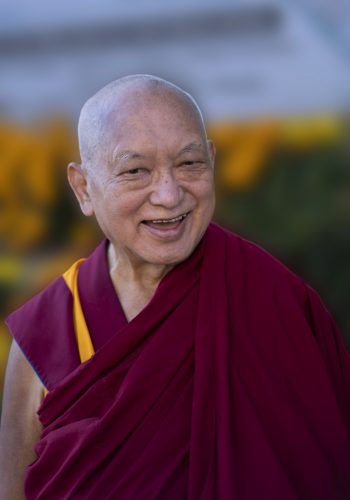
Lama Zopa Rinpoche at Kopan Monastery, Nepal, November 2020. Photo by Ven. Lobsang Sherab.
Billions of thank yous for finishing this retreat … so inspiring! And great that Geshe-la was able to help so it was clear for you.
Numberless thanks for doing the retreat and dedicating the life to sentient beings, following His Holiness’ wishes and Lama Yeshe, and that you were able to complete with Geshe-la’s help—as he did two three-year retreats himself—so fortunate! I am sure Vajrayogini is blissed out and extremely pleased. Now you’re ready to go to the pure land. Now in the world there are so many problems with the pandemic, environment, etc. Now you can go to Vajrayogini pure land and there you can become enlightened very quickly, much quicker than in Amitabha pure land, as it takes more than one life there.
This is great inspiration in the world for others to do the three-year retreat of Vajrayogini.
More Advice and Reflection from Ven. Lhamo
In addition to what Ven. Lhamo said about the retreat in her interview, she also wanted to share the following with students thinking about engaging in retreat:
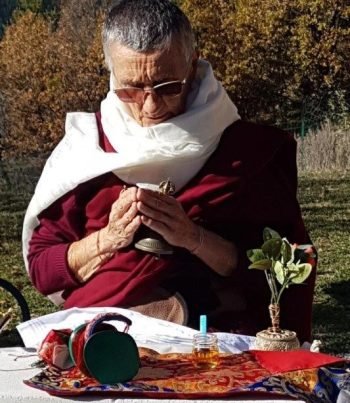
Ven. Lhamo doing puja
- Know yourself with honesty before starting.
- Have a schedule that you can keep according to your capacities and preferences, but have a clear structure and rhythm.
- Have a mentor with whom you can communicate, receive help, and clarify what you are doing and what is happening involving inner work and practical issues.
- Receive the blessing of your teacher, sometimes it is the only “thing” you have to continue.
- Solitude makes you discover and perceive new things. You go through death and craziness. It is not an intellectual reflection but a practical living experience.
- You can sing the practice, listen to audio.
- Do practical work like painting and making things.
Ven. Lhamo said, “When I finished, my first thought was, ‘This was a preparation. I would like to do the real retreat.’ To finish is not easy. … And I really don’t know what I will do after.”
Ven. Lhamo also wishes to sincerely thank the many people who helped her, including sending offerings on her behalf, helping her with the fire pujas, and preparing the pills needed for the fire pujas.
FPMT.org brings you news of Lama Zopa Rinpoche and of activities, teachings, and events from FPMT centers, projects, and services around the globe as well as from students, teachers, and others in the FPMT community. If you like what you read, consider becoming a Friend of FPMT, which supports our work.
You can learn more about Thakpa Kachoe Tibetan Buddhist Retreat Land: www.thakpakachoe.org
- Tagged: geshe tenzin loden, in-depth stories, institut vajra yogini, long-term retreat, nicolas brun, retreat, thakpa kachoe retreat land, vajrayogini retreat, ven. thubten lhamo
19
Maratika: Where All of Your Prayers Are Fulfilled
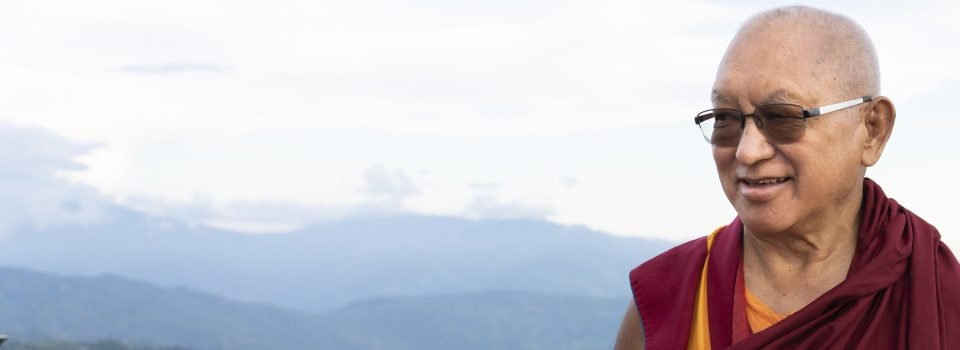
Lama Zopa Rinpoche standing on the ridge where the very large Padmasambhava statue will be built above the Maratika Caves, Nepal, September 2021. Photo by Ven. Lobsang Sherab.
By Ven. Sarah Thresher
Maratika, known locally as Halesi, is a sacred pilgrimage site with ancient meditation caves located in eastern Nepal where Guru Rinpoche achieved immortality. Ven. Sarah Thresher has undertaken the journey to Maratika annually since 2007 to make offerings and prayers for Lama Zopa Rinpoche’s long life, and shares here some of the history and features of this holy place, along with some details of Rinpoche’s recent visit and vast vision for its future.
According to the late head of the Nyingma school of Tibetan Buddhism, Dilgo Khyentse Rinpoche, Maratika is one of the six holiest places in this world, along with Bodhgaya in India, Manjushri’s Five-Peak Mountain and the Potala Mountain in China. The remaining two places have not been “opened” yet: Uddiyana and Shambhala. Some years ago, Lama Zopa Rinpoche wrote, “In the Maratika cave where Guru Rinpoche found immortal realization, all your prayers can succeed.”
Ancient scriptures record that long ago Maratika was blessed by the three Buddhas—Manjushri, Chenrezig, and Vajrapani—and that due to this blessing any practice performed on the three hills in Maratika that bear their names is a hundred times more powerful than practices done at other places. It is also said that Eighteen Long Life Tantras—along with other teachings taught by Buddha Amitabha in Sukhavati at the request of Chenrezig—were scribed by dakinis in symbolic script using pure gold and concealed in a jeweled casket in the caves of this holy place. This makes Maratika a particularly powerful place for any kind of practice and especially for those that dispel obstacles to life.
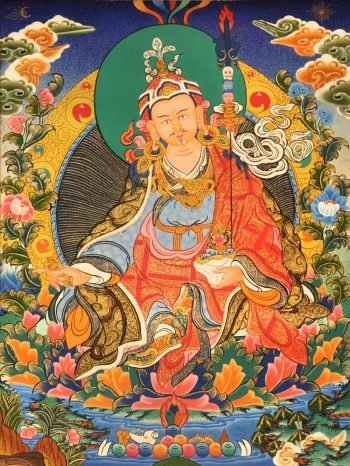
Padmasambhava (also known as Guru Rinpoche)
Since ancient times, generations of great Buddhist masters and practitioners have undertaken the sacred journey to Maratika to practice in its caves. Most famously, the legendary master himself, the second Buddha, Padmasmbhava (known also as Guru Rinpoche), sought the blessings of these caves for his practice of longevity with the Princess Mandarava. After engaging in long-life practice for three months, Buddha Amitayus appeared in front of the Guru and wisdom mother and placed a vase of long-life nectar on their crowns to grant empowerments. Upon drinking the nectar they accomplished the state of immortal life, free from birth and death, and then arose as Hayagriva and Vajravarahi.
The more one reads and learns about Maratika, the more devotion and faith arise that this is not an ordinary place. High lamas have composed praises of Maratika’s outer, inner, and secret qualities. His Holiness Trulshik Rinpoche writes that all twenty-four holy places are contained within Maratika:
Nowhere in India, Tibet, or elsewhere will such an exceptional pilgrimage place be found.
I, an ordinary being, could never finish expressing the qualities of Maratika
But since they are seen to be true, they cannot be denied.[1]
Maratika has long been a popular destination for pilgrims from all over the Himalayan regions—including high lamas from all traditions—but now more and more pilgrims are visiting from around the world. Many come to do long-life prayers and practice for their teachers or themselves.
The previous Trulshik Rinpoche would spend one month of his precious time each year in retreat at Maratika for His Holiness the Dalai Lama’s long life and would send nuns from his gompa at Thubten Choling to stay all year round in continuous long-life practice for His Holiness in the main cave.

Kopan nuns doing puja on Manjushri Hill in 2013. Photo courtesy of Ven. Sarah Thresher.
For many years, Rangjung Neljorma Khadro Namsel Drönme (Khadro-la) has also come annually to Maratika to do long-life retreat for His Holiness. She usually does retreat in the Guru Rinpoche Secret Save at Manjushri—a smaller cave located near the main cave of longevity—where His Holiness Sakya Trizin and His Holiness Drukchen Rinpoche spent time in retreat. On one occasion Khadro-la had a vision of Buddha Amitayus in this cave that lasted many days, and she made long-life pills, which she later offered to His Holiness.
Anyone can go to Maratika for a short or long retreat or simply for pilgrimage, and it’s still possible to practice in the caves. In the past Khadro-la has recommended that pilgrims stay for three days, three weeks, or three months. It is said that merely having the thought to go to Maratika is very powerful, and His Holiness Sakya Trizin said that on arriving in Maratika all of one’s life obstacles will be removed.
Maratika is situated on a ridge with distant views of the Himalayas to one side and river valleys and hills to the other. The journey to get there, through river valleys and rural Nepal, takes around eight hours by jeep from Kathmandu, so it is necessary to spend at least one or two nights there. Personally, I recommend at least a three-day, four-night stay as there is so much to see, and it’s important to have time for meditation and prayers also.
There are five main caves—the Long-life Cave, the Heruka Cave, the Secret Cave, the Garuda Cave, and the Naga Cave. There is also Mandarava’s Cave, which is in the jungle a half-day’s jeep trip away. Each cave has its own special character: some are very large and others are small, some are high up and others are deeper in the earth.
Both inside the caves and outside on the hills, there are many naturally arising rang jung, or special features—such as a natural conch in the Wrathful Cave, victory banners, umbrellas and pennants hanging from the roof of the caves, dakini script on the walls, a phurba, a treasure chest, a mandala, and so many more.
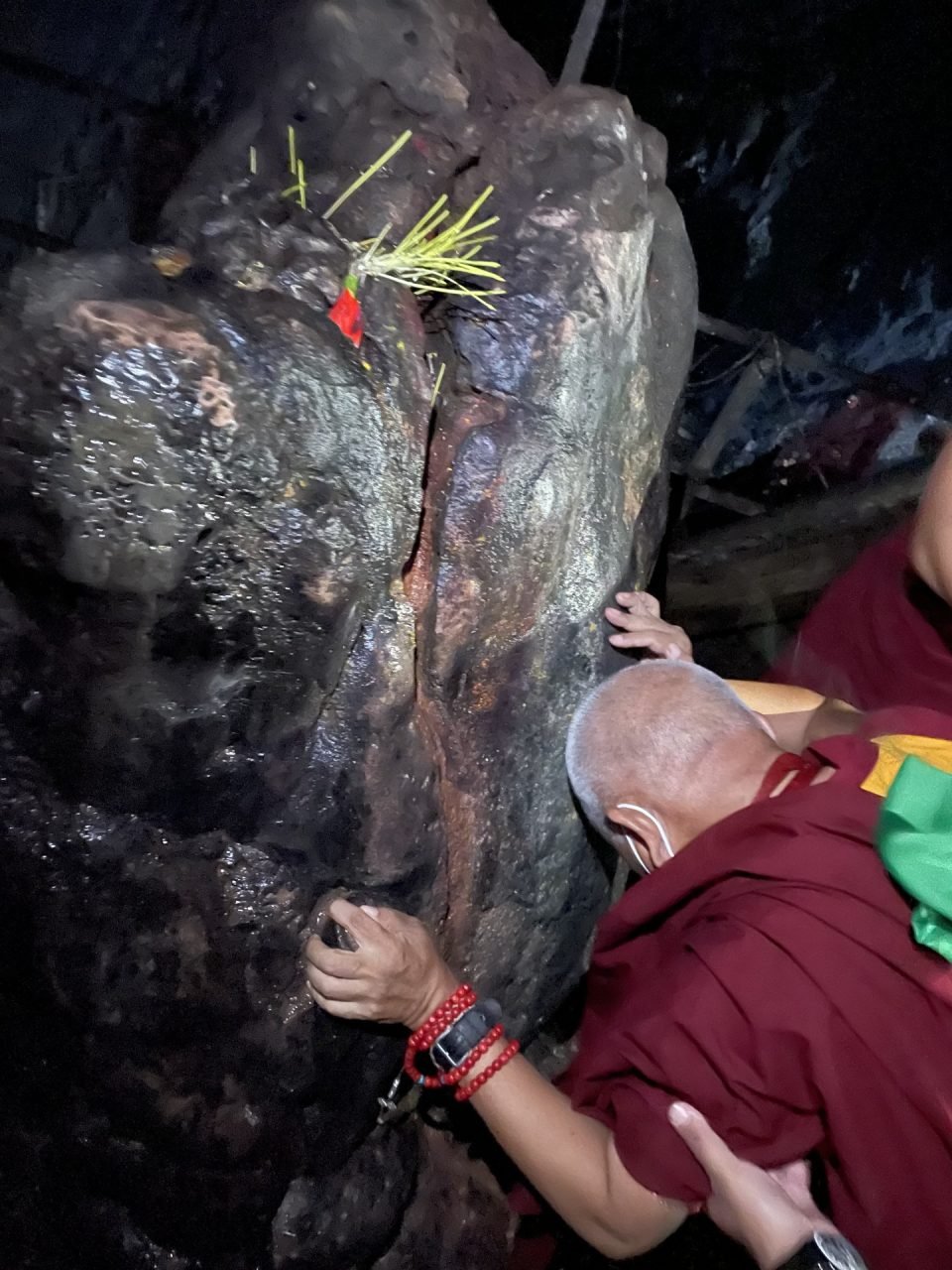
Lama Zopa Rinpoche praying at the Tsebum long life vase where all prayers are fulfilled. Photo by Ven. Sarah Thresher.
One small area of the main cave has many of these kinds of holy objects—the imprint of the holy body of Buddha Amitayus, the Buddha of Long Life; a naturally arising long-life arrow; a White Tara in the rock above; and next to that, Buddha Amitayus’ long-life vase (tse bum), where special nectar will sometimes flow on auspicious occasions. Many meditators like to practice here as these sacred objects make it the perfect place to recite long-life mantras or sutras. The long-life vase is considered the most holy object at Maratika, and it is said that any prayers made at the vase will definitely be fulfilled.[2] There are also four “pathways” inside the main cave—challenges in the rocks that a pilgrim must past through in order to purify the following: birth in the lower realms, the intermediate state, birth from an ordinary womb, and broken samaya with the guru.
There is a connection between FPMT and Maratika. The Lawudo Lama, Kunzang Yeshe, who is Lama Zopa Rinpoche’s previous incarnation, spent time at the pilgrimage site. His heart disciple, Ngawang Chophel, built the monastery at the mouth of the cave and became the first Maratika Lama.[3] On Lama Zopa Rinpoche’s first visit to Maratika in 2008, the young reincarnation of Ngawang Chophel (who passed away in 1997) was there to greet Rinpoche, and they have met since. (He is currently a teenager studying at Mindroling Monastery in India.) Rinpoche has been very generously supporting the small Nyingma monastery at Maratika for many years now. The most recent donations offered were to complete the new monastery building, which is currently underway.
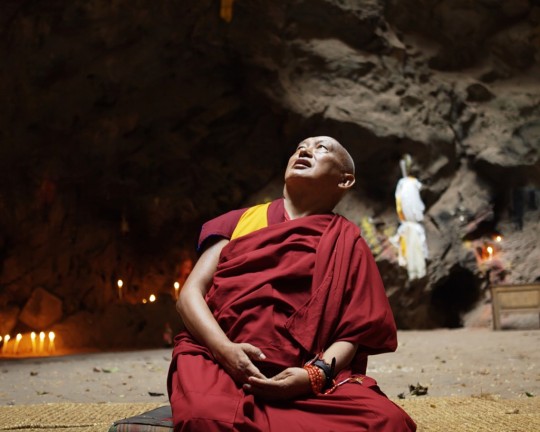
Lama Zopa Rinpoche at Maratika Caves, Nepal, February 2016. Photo by Ven. Losang Sherab.
Over the past fourteen years, the small hamlet that was Maratika has developed rapidly due to the completion of a road from Kathmandu. The cost of land has skyrocketed, and it has become harder and harder to find and purchase suitable property. Like many places that expand quickly, Maratika’s growth has been somewhat chaotic and unplanned. Hotels and guesthouses have sprung up all over what used to be an idyllic landscape of fields. Whereas in the past it was necessary to trek several days to reach the caves and stay in conditions of hardship, it is now a relatively easy journey with quite luxurious new hotels in which to stay.
There is no doubt that Maratika will continue to develop, bringing with it a constant influx of many thousands of pilgrims, similar to Bodhgaya. Most of these pilgrims will not be Buddhist and with this growth, there is the danger that some of the pilgrimage site’s rich Buddhist heritage could be lost.
With this in mind, Rinpoche has envisioned the construction of a huge Padmasambhava statue on Manjushri Hill above the Guru’s Secret Cave. People will be able to visit the statue and practice there. A plot of public land has been secured, plans have been drawn up, and the construction team and statue maker have been appointed.
The statue of Padmasambhava, which is planned to be 45 feet (14 meters) tall with a 15-foot (4.5-meter) throne, will be in the aspect of Padma Gyalpo, Padmasambhava’s magnetizing form. It will be made of bronze and plated with gold. The statue will take around five years to complete.
Having seen how rapidly Maratika has developed over the past five years, I can only guess at how important this project is and how it will affect the town that grows around it. It is an awe-inspiring vision. There is also a wish to have a place for our gurus and some students to stay and do retreat nearby the statue.
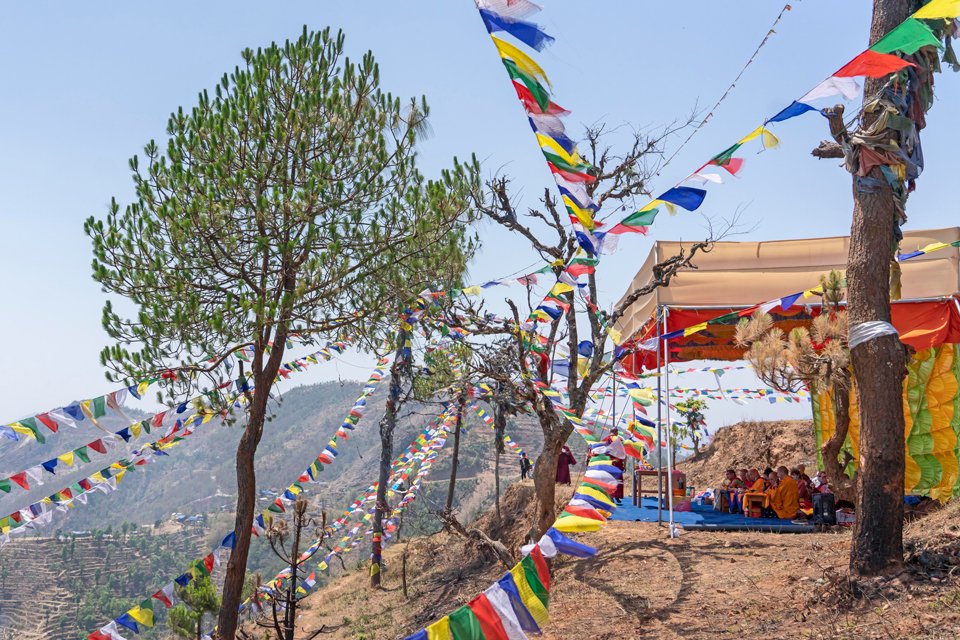
Lama Zopa Rinpoche and Khadro-la doing the bhumi puja on the ground where a 66-foot tall Padmasambhava statue will be built, Maratika, Nepal, April 2021. Photo by Ven. Lobsang Sherab.
In April 2021, Rinpoche and Khadro-la traveled to Maratika to see the land and do a preliminary blessing. In September 2021, Rinpoche returned to Maratika along with the Kopan lama gyupas and nuns to do the actual blessing of the land on the most auspicious day. This was meant to be just a short trip of two days, but since all the conditions for our visit were so idyllic—a smooth journey, perfect weather, peaceful and conducive accommodation—the trip was extended a further two days. This gave time for Rinpoche to interact with some of the local people. He taught two of the hotel owners, blessed the goats in Maratika liberated for his long life, gave two Zoom teachings, and also visited the main cave to make special prayers at the long life vase, which was opened only for Rinpoche. For those of us fortunate to accompany Rinpoche on the trip, it felt like a very auspicious time.
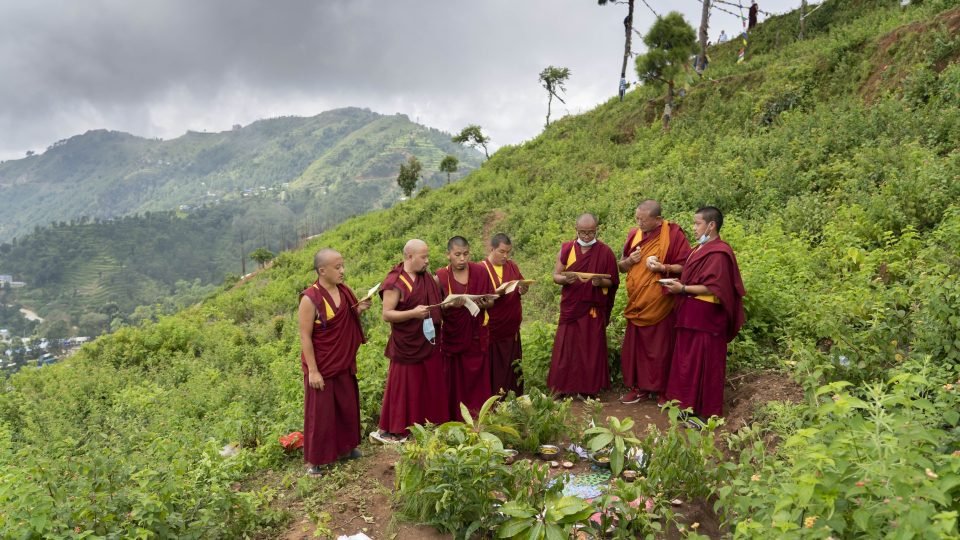
Kopan lama gyupas performing the bumi puja and ground consecration puja on the Guru Rinpoche statue land in Maratika, before the actual building begins of the statue, September 2021. Photo by Ven. Lobsang Sherab.
For pilgrims wishing to visit, Rinpoche translated The Requesting Prayer to Maratika, which is a concise guide to the holy places and holy objects of Maratika in the form of a prayer.[4]
I hope that everyone who reads this article will rejoice and aspire to visit Maratika and pray for the long lives of our precious teachers, the success of this holy object project, and for all our teachers wishes to be effortlessly fulfilled.
Ven Sarah Thresher is an English nun, currently living in Nepal. She first met Buddhism at Kopan in 1982 and ordained a few years later. In the past she has worked as an editor and taught at FPMT centers around the world.
Learn more about Rinpoche’s Vast Vision to build Padmasambhava statues around the world as part of the Padmasambhava Project for Peace.
Endnotes:
[1] Taken from The Vajra Song Melodiously Praising Maratika by Kyabje Trulshik Rinpoche.
[2] Good introduction to the sites of Maratika can be found on the websites Nekhor.org and Maratika.info.
[3] More information on this relationship past and present can be found in the book The Lawudo Lama.
[4] The prayer was composed by a Nyingma Khenpo while in retreat in Maratika and offered to Rinpoche in the cave while Rinpoche was doing practice.
- Tagged: guru rinpoche, in-depth stories, maratika, padmasambhava, padmasambhava project for peace, padmasambhava statue
16
For more than three decades, the Meridian Trust has been documenting Buddhist teachings and traditions around the world. The UK-based organization has collected an archive of more than 2,500 hours of film and video, including rare footage of the generation of Tibetan lineage holders who first went into exile. Vicki Mackenzie shares the story of the Meridian Trust and its connection to FPMT.
Unbeknown to most Buddhist students, there is a stash of hidden treasure accessible through a mere tap of the fingertip. Faces, voices and words of the most venerable masters who managed to escape from Tibet, video of His Holiness the Dalai Lama receiving the Nobel Peace prize, extraordinary footage from Tibet itself of its culture and historical events, and little gems of meetings between students and gurus. It’s accessible through the Meridian Trust website, an archive of over 2,500 hours of footage that has recorded the vanishing Tibetan traditions. And it is the brain child of Geoff Jukes, a long-term British student of Lama Yeshe and Lama Zopa Rinpoche, and manager of some of the biggest names in the British music industry.
“The late 1970s and early 1980s, was an extraordinary time to meet the Dharma,” Geoff said. “There seemed to be an unending supply of these very rare beings, who appeared in our midst, the repositories of the unique Tibetan culture that was rapidly vanishing. It became very clear to me what an extraordinary window of opportunity we had been given, and it wasn’t going to go on forever. I wanted to record and preserve it for future generations. I discussed it with Lama Yeshe, and he was very enthusiastic.”
Geoff pulled together a group of people, friends, and friends of friends, and with his professional access to sound and video equipment started recording. At the beginning they filmed the Tibetan masters who Lama Yeshe boldly persuaded to come to the UK to teach at his newly formed FPMT centers—eminent teachers such as His Holiness Kyabje Zong Rinpoche, Tsenshab Serkong Rinpoche, Geshe Dargye, Serkong Rinpoche, and of course Lama Yeshe and Lama Zopa Rinpoche. “We all acted from the heart,” Geoff said. “In the early days it was remarkably easy, because the teachers were so available.”

Screenshot of Meridian Trust Digital Archive Service page
The project took a giant leap forward in 1985 when Geoff and his team approached His Holiness the Dalai Lama to ask if it were appropriate to continue filming the lamas. His Holiness not only approved but instructed that all four schools of Tibetan Buddhism should be included as well as Bon. “His Holiness gave us a list of the teachers and the commentaries that they were known for, to be recorded for posterity. He understood that it was vital that we capture something that was passing.”
In 1985 Meridian Trust was born, the name created by Greta Jensen, a founding trustee and camera person, signifying the global line of longitude where two cultures meet.
Today, more than thirty years later, Meridian Trust are still filming and offer a cornucopia of inspiring, instructive, and valuable footage. Following the Dalai Lama’s advice, they have filmed teachers from all schools, including Kalu Rinpoche, Kirti Tsenshab Rinpoche, Khensur Ngawang Nyima, Lati Rinpoche, Senje Choden Rinpoche, and many others. There are interviews with leading painters, sculptors, and weavers. There is footage following Namkhai Norbu and a group of pilgrims to the holy mountain of Kailash and the hidden kingdom of Shang Shung. You can also find hours of video of the His Holiness the Dalai Lama, including the first Kalachakra initiation in Europe, held in Rikon, Switzerland in 1985; his private audiences; his appearance, arranged by Geoff, at the famous Glastonbury Pop Festival in 2015; and his public talk with the comedian and author Russell Brand in 2012.
“For me, however, it’s the early films that are particularly precious because no-one else was doing it then,” said Geoff. “We caught some iconic FPMT moments such as His Holiness’s and Lama Yeshe’s teachings at Institut Vajra Yogini in France and at Istituto Lama Tsong Khapa in Italy in 1981. Many FPMT centers do not realize the special, iconic moments we’ve captured and which are available to them.”
In recent years Meridian Trust has broadened its scope to reflect how Dharma is evolving in the West through a variety of emerging Buddhist teachers like Jetsunma Tenzin Palmo, Ven. Robina Courtin, Alan B. Wallace, and others, as well as Tenzin Osel Hita (Lama Yeshe’s reincarnation).
Greta Jensen recalls how things have changed for over the years:
“At the beginning the equipment was so large we had to hire big cars to carry it all around. It was like lugging furniture about. I remember setting up in Bodhgaya to film the Kalachakra. The Dalai Lama and a retinue of monks were on the stage going around the mandala staking it out before it began. I was trying to get these huge, thick sound cables in place. One had got stuck behind His Holiness’s throne, and I crawled along to untangle it when I came face to face with the Dalai Lama, who had seen the problem and had freed it. ‘Here you are,’ he said. There were lots of wonderful moments. I remember filming the meeting between His Holiness and the Roman Catholic Archbishop of Westminster, Cardinal Basil Hume. I locked him out, but managed to get him in finally.”
Today, Meridian Trust has digitized all its work, making it available worldwide for different audiences: Buddhist, scholars, adventurers.
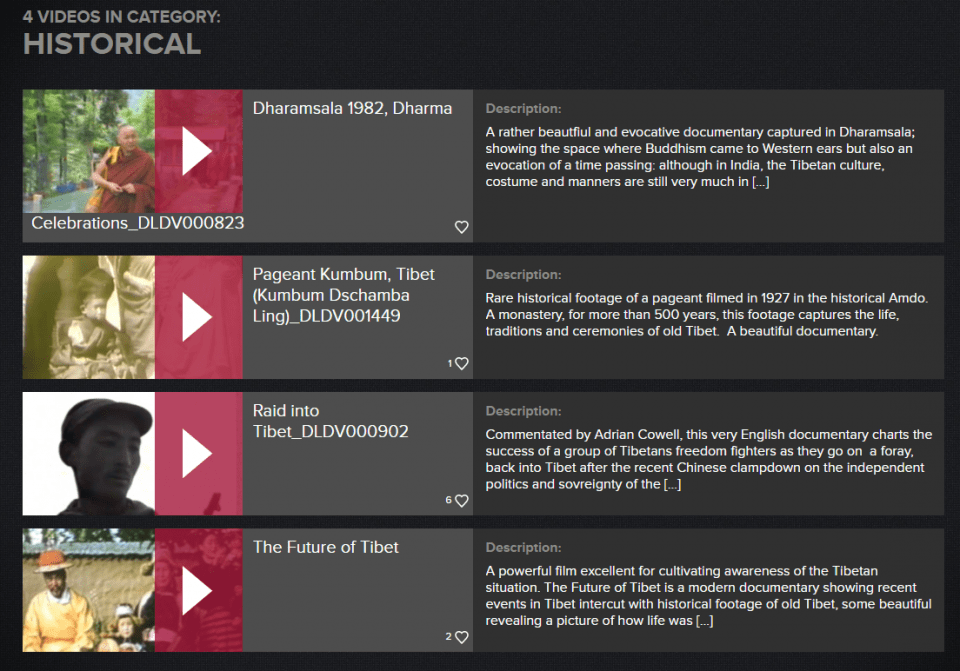
Screenshot of videos in Historical category on Meridian Trust website
“As more Chinese are engaging in their spiritual traditions, there may come a time when they will appreciate more what the Tibetans have to offer,” said Marie Beresford, trustee and long-term member of the Meridian team.
Meridian Trust has recently handed over a copy of the entire archive to the Tibetan Library of Works and Archives in India to be held for posterity. The trust has also over the years trained Tibetan film crews working for the library to document their own history.
“It’s very exciting for the Tibetan people to see not only His Holiness in Western countries but also their own land and culture. I feel as if Meridian Trust is paying homage, giving back something of the enormous treasure the Tibetans have given to us,” said Geoff.
Meridian is expanding its scope by launching a new, updated website (meridian-trust.org) in January 2021, which will include podcasts and articles covering a wide range of Dharma subjects.
Visit the Meridian Trust online to watch videos and learn more about the video archive.
Vicki Mackenzie is a British journalist who has written for the national and inter national press for over forty years. Her articles have appeared in The Sunday Times, The Observer, The Telegraph, the Daily Mail and many magazines in Britain and Australia. She’s also the international best-selling author of Cave in the Snow; Reincarnation: The Boy Lama; Child of Tibet; Reborn in the West: The Reincarnation Masters; and Why Buddhism? Westerners in Search of Wisdom. Her latest book is The Revolutionary Life of Freda Bedi: British Feminist, Indian Nationalist, Buddhist Nun, published in March 2017 by Shambhala Publications and available in the Foundation Store. She has been a student of Lama Thubten Yeshe and Lama Zopa Rinpoche since 1976.
22
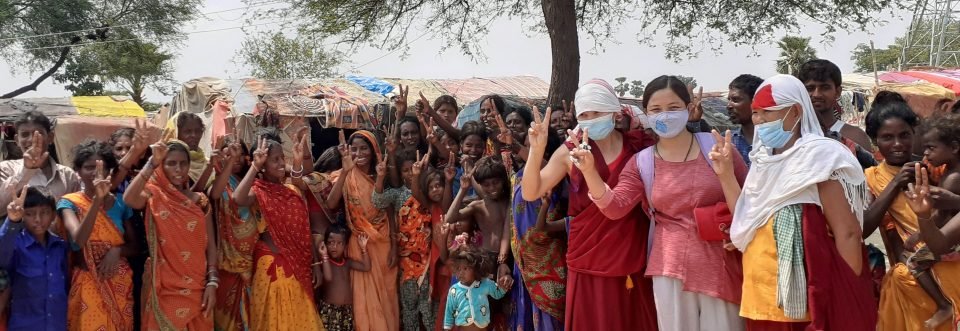
Food distribution in Barachati Village, Bihar State, India, June 2020. Photo by Samten Dolma Bhutia.
Root Institute for Wisdom Culture, the FPMT center in Bodhgaya, Bihar State, India, has been distributing daily staples and food to local poor people and migrant laborers returning to their villages due to the COVID-19 pandemic. Community service is one of FPMT’s Five Pillars of Service. Samten Dolma Bhutia, center manager, shares the story.
Root Institute had the wish to offer service during the COVID-19 pandemic, especially in our state of Bihar, one of the poorest states in India with a high volume of migrant workers. The merit-multiplying month of Saka Dawa helped us set this course into action.
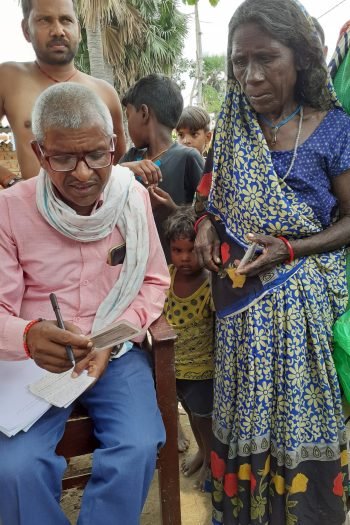
Village representative Vijay Paswan helping with a survey in Ghongwa Village, Bihar State, India, June 2020. Photo by Samten Dolma Bhutia.
By the blessing of Lama Zopa Rinpoche (please read Rinpoche’s message on this project), we began distributing food in May, funded by Root Institute. In June 2020, we received a donation from the Tzu Chi Foundation in Taiwan for food distribution around the Buddhist holy sites of Bodhgaya and Sarnath, and began distributing food on their behalf on June 5.
Two nuns, Ani Lhundrup Doma and Ani Tsangmo; Mr. Pema Tsering, Maitreya School principal; and Root Institute staff lent their kind assistance. We distributed 206 bags of food on the first day.
We sought the help of Father Lawrence, who familiarized us with the poorest village. Father Lawrence is a Jesuit priest who runs a school and missionary project in Bodhgaya and the surrounding area. Their church members surveyed the villages they are connected to and collected their clients’ names from their database.
They surveyed the first village we would distribute to, a remote village named Barachati, and made a list of 160 names. We had extra bags left over after visiting Barachati, so we distributed them to the Romani Indians who live in tents by the roadside.
Root staff members, including Mr. Pema Tsering, suggested that we conduct a survey on our own with the help of our staff. The next day Pema-la asked Umesh, our bus conductor, to take us to his village. Umesh was happy to help us with this survey.
When we go for a survey, we note down the names of the villagers and their identity numbers and give them coupons. The next day, when we do the food distribution, the villagers bring their coupons and identity cards, and we check our list and get their signatures to assure that all the names listed get a food bag.
We go from house to house, collecting their names from their identity card and noting down the identity number. (There could be many people with the same name, but identity numbers are unique.) Our purpose for going house to house or having a village representative help us is because not everyone in the village is poor. There are some who own land and a farm tractor and are not in dire need of food, and in some cases three or four members come from the same family for food, when we don’t visit house to house.
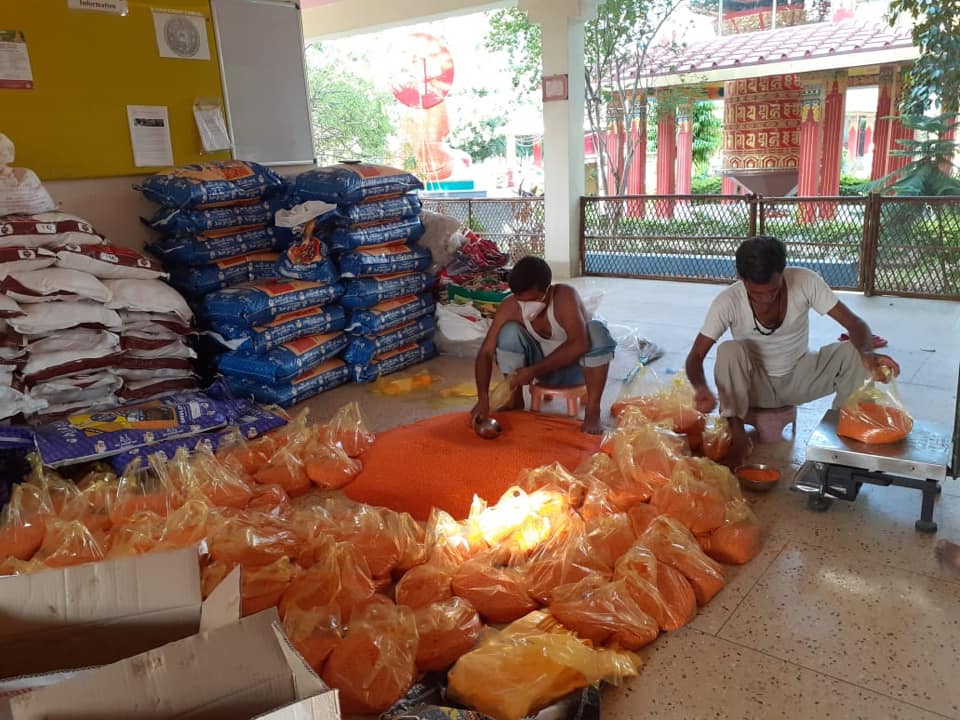
MD Shahid and Binod packaging food at Root Institute, Bodhgaya, Bihar, India, June 2020. Photo by Samten Dolma Bhutia.
Pema, Umesh, and I went by scooter to Illara, Umesh’s village, and the nearby village of Bandha. All together we collected 129 names. The next day we packed 129 bags of food and left Root to distribute food to Illara and Bandha Villages.
Our director contacted Ladakhi monk Anand Bhantey ji and asked him to help us find another village. He came the next day, picked up Shahid and I, and took us to a village named Phur Phuri. Anand Bhantey ji had helped these villagers make a tent to shelter them from rain and heat, and helped them with food as well. He also has plans to educate the children.
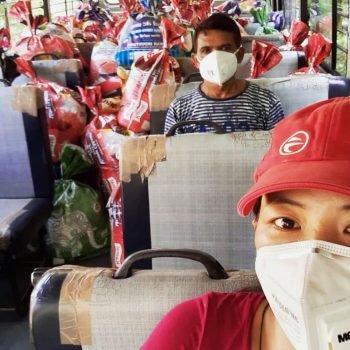
MD Shahid and Samten Dolma Bhutia on a Maitreya School bus delivering food to villages, Bihar State, India, June 2020. Photo by Samten Dolma Bhutia.
The people of Phur Phuri Village don’t have anything — not even identity documents. Because of this they cannot access all of the provisions provided by the government. It would have been very hard for us to find this village without Anand Bhantey ji because they live in an area inaccessible by vehicles.
When we reached Phur Puri the people were so happy to welcome Anand Bhantey ji. They greeted Anand Bhantey ji, Shahid, and I by saying, “Namaste Guru ji.” There were 51 families, and we collected their names.
Most of the women of Phur Phuri Village are teenagers, cooking, cleaning, and looking after their children. Phur Phuri villagers belong to Musar, the lowest caste in the caste hierarchy. They live on whatever they can get in their daily lives, such as wages earned by carrying loads or by hunting rats in paddy fields. They seemed to us to be cheerful and hardworking. We distributed 51 bags of food in this village. This totaled 386 food bags distributed in the community on behalf of Root Institute.
On July 6, I revisited this village again to distribute clothing to the children, sponsored by my kind friend Kumphen, who has also helped with Root Institute activities and social service projects.
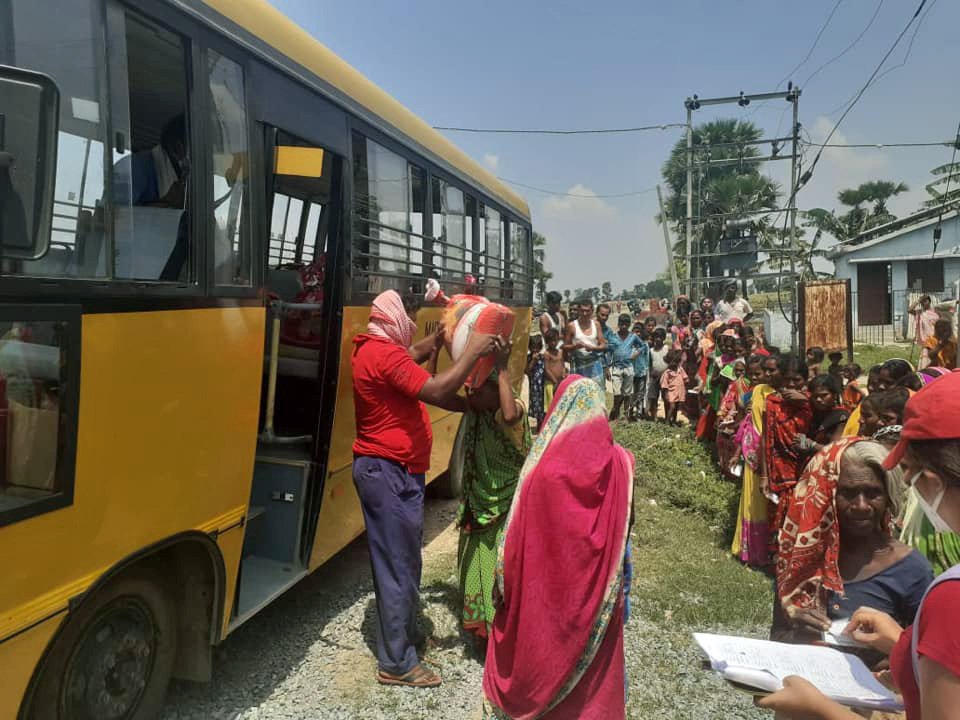
Samten Dolma Bhutia collecting coupons and signatures from the villagers while Shatrudan offers bags of food in Bandha Village, Bihar State, India, June 2020. Photo by MD Shahid.
Surveying was the most overwhelming phase of our work as it was during this period that we met villagers and encountered their lives in the village. Our hearts were particularly touched by the elderly people living in mud houses and still struggling to obtain their basic needs. As we conducted surveys we were assisted by a village leader or an active member of the village due to their familiarity with the people.
After conducting the surveys we made many food distribution trips, offering bags of food to 140 families in Kundali Village, 193 families in Baighanbigha Village, 69 families in Sihodavatad Village, 86 families in lalita Ganj Village, 98 families in Sukandih Village, 24 families in Gaya Krimganj Village, and 101 families in Cherki Village. In sum, we reached 711 families.
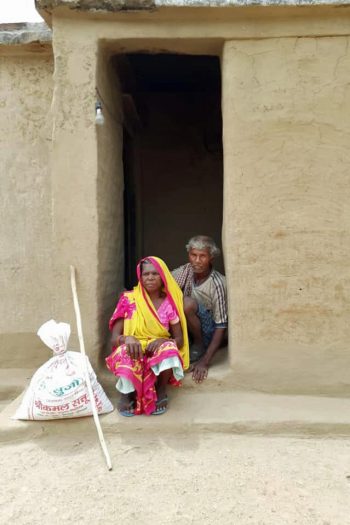
Barachati Village, Bihar State, India, June 2020. Photo by Samten Dolma Bhutia.
We had identified 224 more people in need of food assistance from Dab Manshidi and Godwadi Villages, but we had to stop delivering food before we could reach them due to a sudden and total lockdown beginning on July 16, due to increasing numbers of COVID-19 cases in Bihar.
Finally, on September 13, we were able to distribute food to these communities. As our school buses were not allowed to move around, we distributed the food by asking village heads to bring their farm tractors to Root Institute. Dinesh Kumar, the Navidih Village headman, came to Root Institute with a farm tractor and auto rickshaw to pick up food distribution sacks. Then Tashi-la, Mahakala Cave manager; Kishori, Maitreya School staff; and Raj Kumar, Gopa, and I from Root went to the villages with Dinesh to distribute the food to the people on our list from the surveys. Although we had collected the names of 224 people from Dab Manshidi and Godwadi Villages before the lockdown, by September only 208 bags were distributed as some people had left the village.
The following day we took the remaining 15 sacks of food to Veda Orphan Old Age Home in Bodhgaya, where we distributed 13 bags. We gave the remaining 2 bags to the people we met on the way back to Root Institute.
We have not yet completed our food distribution project on behalf of the Tzu Chi Charitable Foundation. We will be going out to distribute food in the future when the time is good for us to do so.
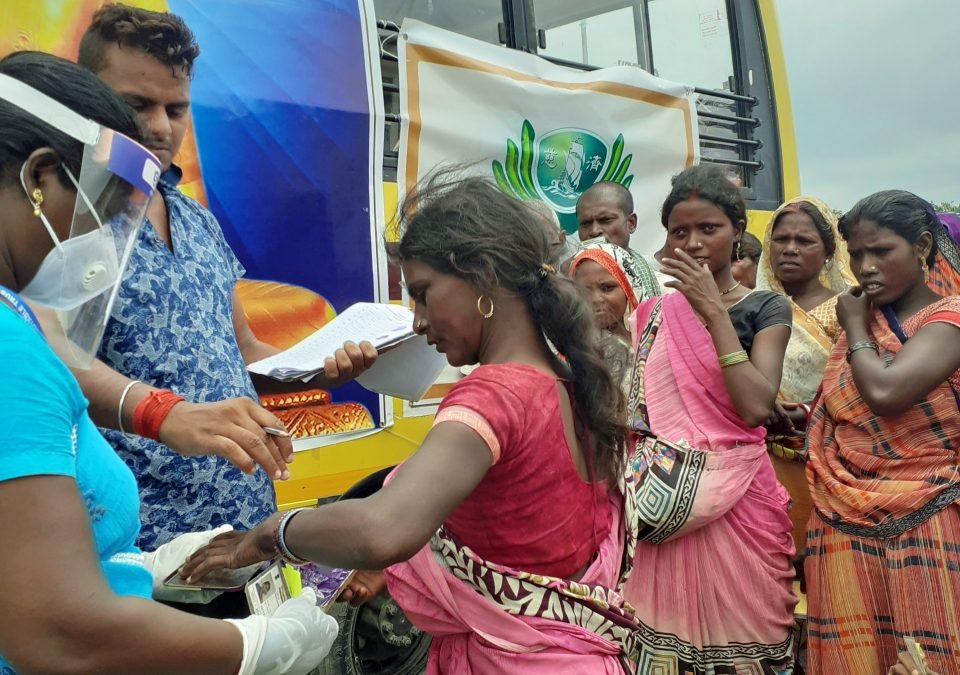
Lucy Khujur and village representative Ravi helping with food distribution in Sukhandi Village, Bihar State, India, July 2020. Photo by Samten Dolma Bhutia.
We are grateful to Lama Zopa Rinpoche and feel blessed to have been able to distribute food to people in need. With Rinpoche’s blessings we were able to reduce our fear. When we see others suffering it helps us forget our own suffering. Thank you to the many benefactors who have so generously benefitted the poor laborers struggling to meet their basic needs. Thanks to their generosity, we were able to help others, thereby collecting merit and purifying negative karma.
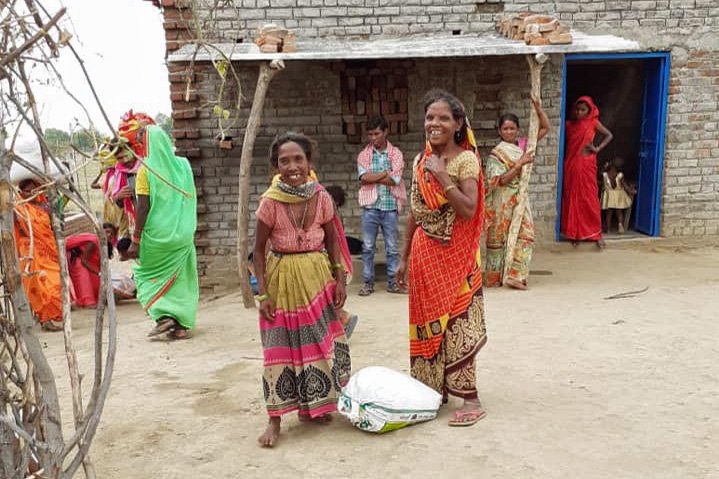
Barachati Village, Bihar State, India, June 2020. Photo by Samten Dolma Bhutia.
After Lama Zopa Rinpoche heard about the food distristribution activities as Root Institute, he offered this message:
Benefits of Charity: Root Institute’s Food Distribution Program during COVID-19
Guru Shakayamuni Buddha said in his teachings that if even a strand of hair is given in charity to a sentient being, for 80,000 eons one will not be reborn in the lower realms and for many lifetimes will be born into auspicious wealth, good health, and fulfilment of wishes due to this action. In the Arya Sanghata Sutra it says one will attain enlightenment by doing the same action. These are the kinds of benefits that are beyond expression and concept.
This food distribution that Root Institute is offering is not just a strand of hair but a variety of food items that are given in charity to the poorest of the poor. So there is benefit beyond expression and concept. When they receive the sacks of food they are extremely happy.
Normally, these kinds of free distributions happen only around local election times. So when we did the food distribution, they were wondering what election was happening. Our food distribution was made across the board, irrespective of the recipient being a Christian, a Muslim, or a Hindu. When the food distribution happened for the first time, we collaborated with the local priests, thinking they might be most familiar with charitable works, but then there was a sense of selective charity toward only those associated with their missions. This did not appeal to us. So after the first distribution we did our own survey to identify the poorest of the poor families, who were extremely happy and appreciative of the help.
We used the school bus for transportation and draped the side of the bus with a huge picture of the Buddha. [Recordings of Rinpoche chanting prayers and mantras were also played over the bus’s speaker.] By merely seeing the image of the Buddha [and hearing the prayers and mantras] they accumulate vast amounts of merit and purified unimaginable amounts of negative karma.
To understand the extent of this merit, it is stated in the Sutra of the Mudra: Entrance to Generating the Power of Devotion that Buddha said, “Manjugosha, a boy or girl of the race, for eons equaling the sand grains of the River Ganga, offers divine food of a hundred tastes and, likewise, divine dress every day to solitary-realizer buddhas equaling the atoms of the whole entire universe, but, Manjushri, any other boy or girl of the race who sees a painting or statue of a buddha collects numberless greater merits. What need is there to mention that anyone who puts their palms together or offers flowers, scent, incense, or lights, [or offering water bowls, Rinpoche adds] collects numberless greater merits than that?” So it is like this, benefitting us from lifetime after lifetime and in dependence upon this we attain the state of Buddhahood.
I also instructed the nuns to participate in the food distribution so that the people can see the robes of a Buddhist and rejoice, and thereby become a condition for them to meet the perfect teachings in their future life—the Buddha’s teaching on the four noble truths, the means to liberation from the great ocean of samsara, for them to have the opportunity to study and practice these teachings, and attain enlightenment. For these benefits, the two nuns went and distributed food.
Thinking from the side of the beneficiaries, these are times of great hardships for them, and help has arrived in their utmost time of need. When we are extremely poor with nothing left to eat and when someone helps us in such a time of need, imagine how extremely happy and appreciative we feel. By this you know exactly what it’s like.
Colophon: Lama Zopa Rinpoche dictated this message in Tibetan to Ven. Tsenla, director of Root Institute, at Kopan Monastery, Nepal, on July 3, 2020. Translated by Ven. Tsenla, edited lightly by Carina Rumrill.
Root Institute center manager Samten Dolma Bhutia writes, “Thank you to everyone who has been helping with this project, including Root Institute staff members Sunil Kumar Manjhi, Arun Paswan, Anil Paswan, Ramananad Das, Lucy Khujur, Lily Kujur, Poonam Devi, Pravin Malakar, Gauri Shankar, Sunil Das, Karan Prajapat, Rupan Manjhi, Binod Kumar, Mehfuz Alam, Raj Kumar, Gopal, Ajay, Kishori, and Ven. Dekyong for looking after Root Institute and for always giving us valuable information and suggestions.
“Thank you to Ladakhi Lama (fondly known as “Baling”), who has been very kind and caring during this time, and Root Institute director Ven. Tsenla for gathering funds to reach out to the poorest of the people affected by COVID-19, for being constantly available, and for guiding us in the work.
“We would also like to thank the villagers who have represented their villages and helped us with our project: Viijay Paswan, Ravindra, Ravi, and Dinesh. Thank you to Tashi-la, Mahakala Cave manager, who has selflessly helped the Root and our staff with food distribution.”
For more information about Root Institute for Wisdom Culture, visit their website:
https://www.rootinstitute.ngo/
- Home
- News/Media
- Study & Practice
- About FPMT Education Services
- Latest News
- Programs
- New to Buddhism?
- Buddhist Mind Science: Activating Your Potential
- Heart Advice for Death and Dying
- Discovering Buddhism
- Living in the Path
- Exploring Buddhism
- FPMT Basic Program
- FPMT Masters Program
- FPMT In-Depth Meditation Training
- Maitripa College
- Lotsawa Rinchen Zangpo Translator Program
- Universal Education for Compassion & Wisdom
- Online Learning Center
- Prayers & Practice Materials
- Overview of Prayers & Practices
- Full Catalogue of Prayers & Practice Materials
- Explore Popular Topics
- Benefiting Animals
- Chenrezig Resources
- Death & Dying Resources
- Lama Chopa (Guru Puja)
- Lama Zopa Rinpoche: Compendium of Precious Instructions
- Lama Zopa Rinpoche: Life Practice Advice
- Lama Zopa Rinpoche Practice Series
- Lamrim Resources
- Mantras
- Prayer Book Updates
- Purification Practices
- Sutras
- Thought Transformation (Lojong)
- Audio Materials
- Dharma Dates – Tibetan Calendar
- Translation Services
- Publishing Services
- Teachings and Advice
- Find Teachings and Advice
- Lama Zopa Rinpoche Advice Page
- Lama Zopa Rinpoche: Compendium of Precious Instructions
- Lama Zopa Rinpoche Video Teachings
- ༧སྐྱབས་རྗེ་བཟོད་པ་རིན་པོ་ཆེ་མཆོག་ནས་སྩལ་བའི་བཀའ་སློབ་བརྙན་འཕྲིན།
- Podcasts
- Lama Yeshe Wisdom Archive
- Buddhism FAQ
- Dharma for Young People
- Resources on Holy Objects
- Ways to Offer Support
- Centers
- Teachers
- Projects
- Charitable Projects
- Make a Donation
- Applying for Grants
- News about Projects
- Other Projects within FPMT
- Support International Office
- Projects Photo Galleries
- Give Where Most Needed
- FPMT
- Shop
Translate*
*powered by Google TranslateTranslation of pages on fpmt.org is performed by Google Translate, a third party service which FPMT has no control over. The service provides automated computer translations that are only an approximation of the websites' original content. The translations should not be considered exact and only used as a rough guide.In my mind, one of the beauties of Buddhism is that it offers us a practical training for our mind. It does not say, ‘Bodhicitta is fantastic because Buddha said so!’ Instead, it gives us the methods for developing such an attitude and we can then see for ourselves whether it works or not, whether it is fantastic or not.
